The best Android apps to download in 2018
There's never been a better time to get into Android apps, as the Google Play store has exploded in recent years, with a proliferation of titles that can cater to your every need.
The problem is: there are just too many of them, even with Editors' Choice, Featured and Best Selling, Top Paid and Top Free categories there to help.
You can filter, see Google's lists or read the reviews - but the easiest (and best) way to find top quality apps is to have someone else do the searching for you.
That's where we come in. Like you, we want the best apps for our Android phones. The apps that are going to revolutionize functionality or, at the very least, offer something so great that it becomes one of the must-have apps that has to be downloaded whenever you get a new handset.
The following apps will be constantly updated and are a mixture of paid and free ones that have been chosen by our Android experts. So, even if you do dip into actual cash for one of these apps, you can be safe in the knowledge it's a worthwhile purchase.
We’ve also sorted them into categories, so you can find what you’re looking for more easily. Click through to the following pages for those or check out the best Android apps of the week below.
Best Android apps of the week
These are the two apps that we've chosen to highlight each week. They're usually new apps or apps that have recently received a major update, but occasionally hidden gems and other essentials will also be highlighted.
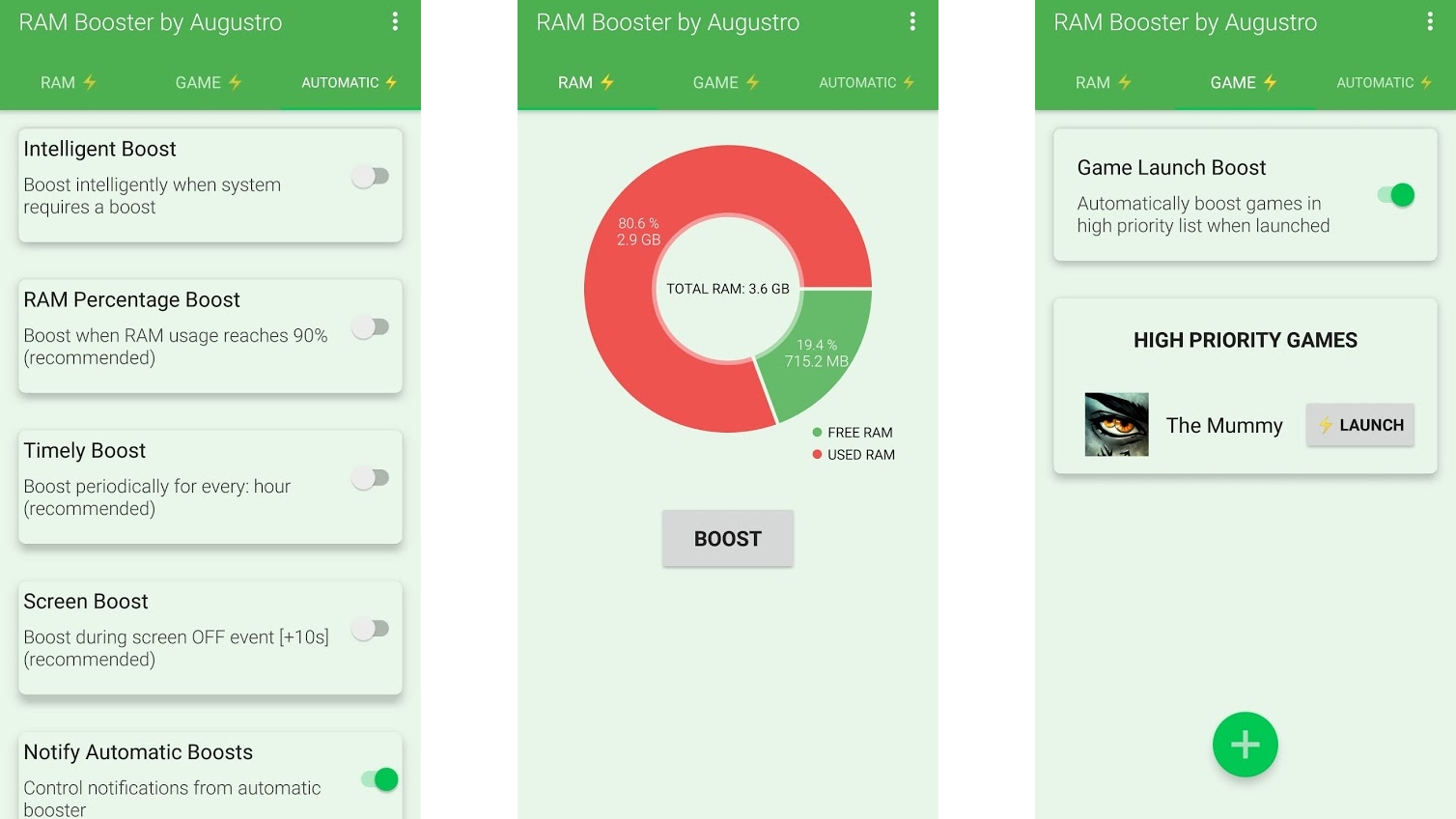
RAM and Game Booster
$0.99/£0.59
Some smartphone makers have put a big focus on gaming modes, such as Huawei with its GPU Turbo feature, but if you don’t have a handset with these sorts of features there are still things that can help, such as RAM and Game Booster.
It helps by freeing up RAM, which it can do on-demand or when specific games are launched.
You can also set RAM and Game Booster to free up RAM when RAM usage reaches a set percentage, after a set period, or when the app judges that the device requires it.
This isn’t the first time we’ve seen an app aimed at freeing up RAM, but the various settings for when it happens are more comprehensive here than on most rival apps. This still won’t turn a low-end phone into a gaming powerhouse, but it could make a small difference to performance.
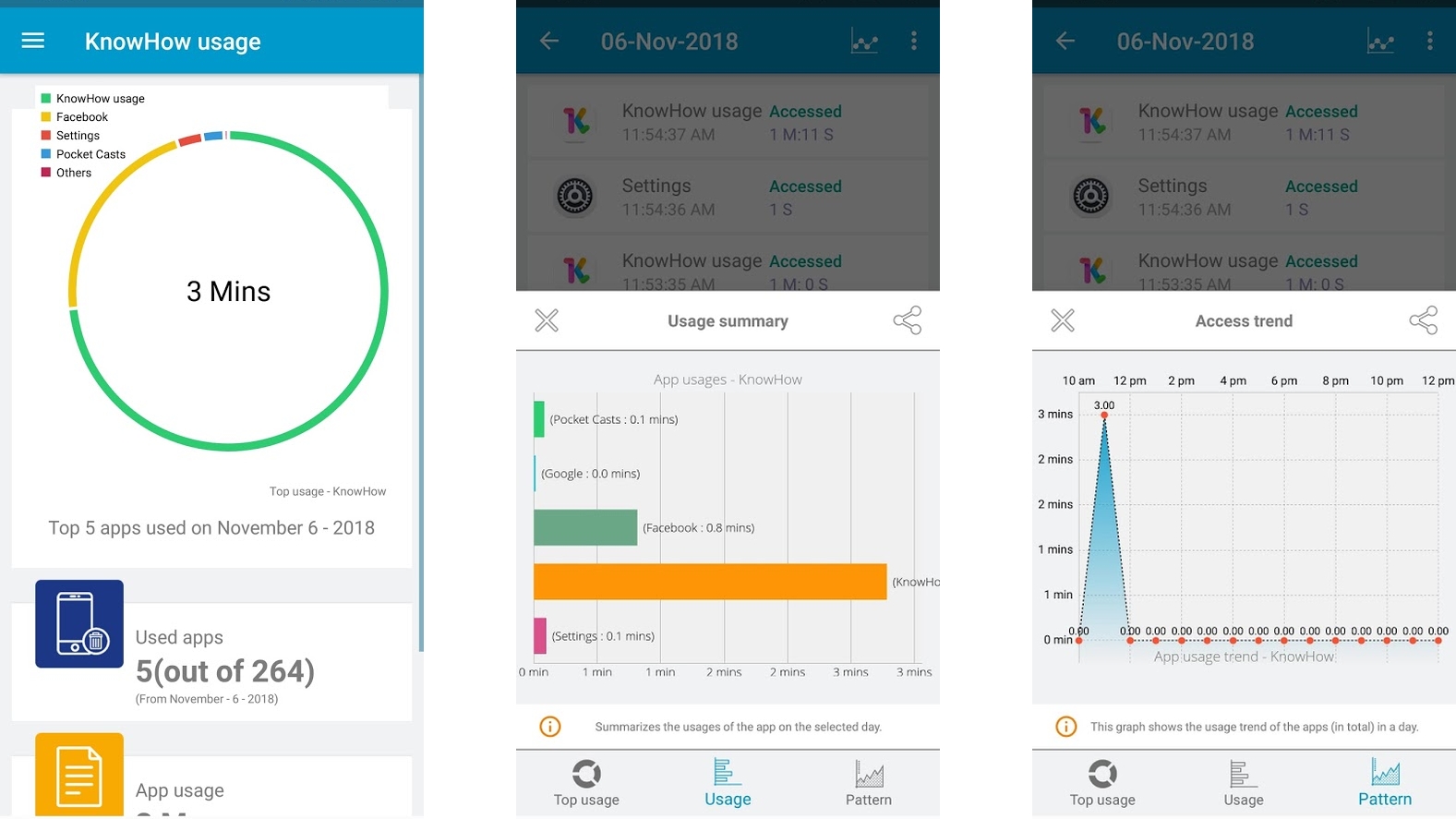
App Usage Tracker
$0.99/£0.99
Google’s Digital Wellbeing app does a good job of helping you monitor your smartphone usage, but it’s not currently available for a lot of phones, so App Usage Tracker makes for a handy alternative.
It will tell you how long you’ve spent in total using apps each day, which apps you’ve used and how long you’ve used each of them for.
As well as numbers, there are also pie charts and graphs showing your most used apps, as well as a ‘pattern’ chart, which shows the times at which you most use your phone.
There are also tools allowing you to hide certain apps from usage tracking and it’s overall just a great way to get a clear overview of how much you use your phone, when, and what for.
Our only real issue with App Usage Tracker is that in our tests the app seemed surprisingly sluggish, but that could be an issue with our device or a quirk that will be fixed in an update.
The best Android camera apps and photo editors
Our favorite Android apps for shooting, sorting and editing photos and videos.
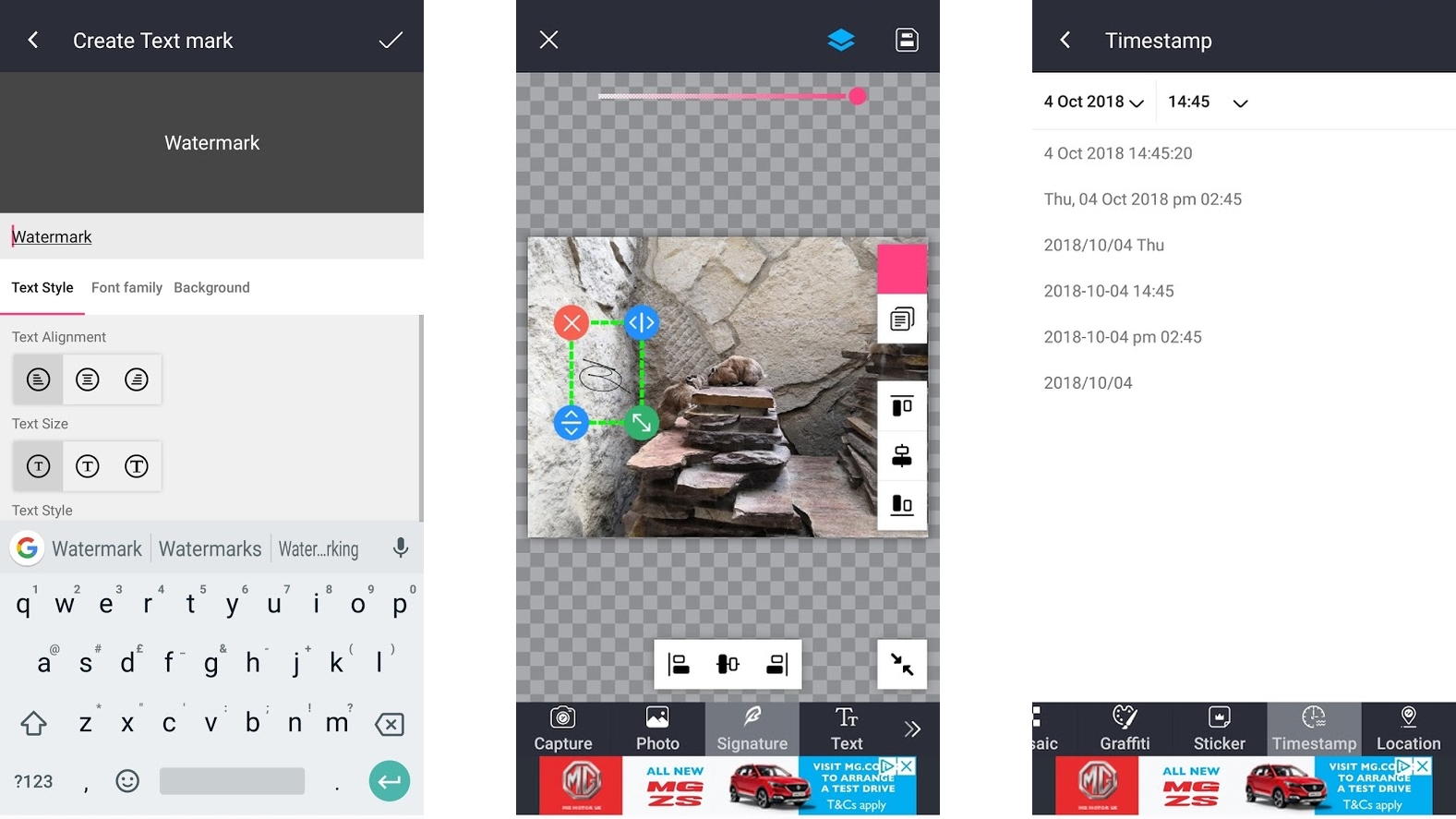
Photo Watermark
Free + $0.99/£0.89 monthly subscription
Photo Watermark does exactly what the name suggests – it lets you add watermarks to photos – but the types of watermarks you can add are quite varied.
Not only can you add custom text as a watermark (including changing the font, size and color), you can also use your signature (or any other hand-written text) as a watermark by writing on the screen.
You can also apply stickers, a timestamp, a location, a mosaic effect, or ‘graffiti’ (which basically just lets you go wild on your images with a digital paintbrush). Whether you want to protect your photo or just log when and where it was taken, there should be a tool here to suit.
Photo Watermark is free, but it’s quite heavy on adverts. For $0.99/£0.89 per month you can get rid of them, but unless you’re adding watermarks to a ton of images it’s probably not worth it.

StoryZ Photo Motion & Cinemagraph
Free + $1.99/£1.79 monthly subscription
StoryZ Photo Motion & Cinemagraph is a photo editing app in two parts. The first of these is ‘Ripple’, a mode which lets you add motion to a static image by drawing the area and direction that you want the motion to happen.
This can be an effective way to make it look like water or smoke is moving for example, or simply to add a slightly trippy effect to things that you might expect to be static.
The ‘Motion’ mode, which lets you blend a video with a photo, leaves you with an ‘image’ that’s partially static and partially in motion.
In both cases it can be hard to make the effect look convincing, but it’s doable, as evidenced by all the impressive public submissions shared on the app. StoryZ also holds contests with specific themes, such as ‘stairs’ or ‘sand’, which you can enter by submitting a relevant creation. The best ones will be featured on the home page and competition page of the app.
You can use StoryZ for free, but if you find that you have more of a talent for it than we do then there’s also StoryZ Premium, which for a monthly subscription removes adverts and watermarks, increases the allowable length of videos in Motion mode, improves the toolset in Ripple mode and lets you save and share in high resolution.

KineMaster
Free + £2.91 (roughly $3.70) monthly subscription
KineMaster is probably one of the most powerful video editors on Android, but it’s also intuitive enough that anyone could enjoy using it.
The app lets you add audio and visual filters to footage, add text, stickers and other overlays, alter and trim videos frame-by-frame, adjust the speed, add transition effects and a whole lot more. You can also record videos straight from the KineMaster app. It can feel a little cramped on a phone screen, but otherwise everything works well.
You can use KineMaster for free, but all your videos will have a KineMaster watermark and you can’t use them commercially. To remove the watermarks, allow commercial use and unlock additional assets (such as effects and overlays) you have to pay a subscription, but at £2.91 (roughly $3.70) per month it remains affordable.
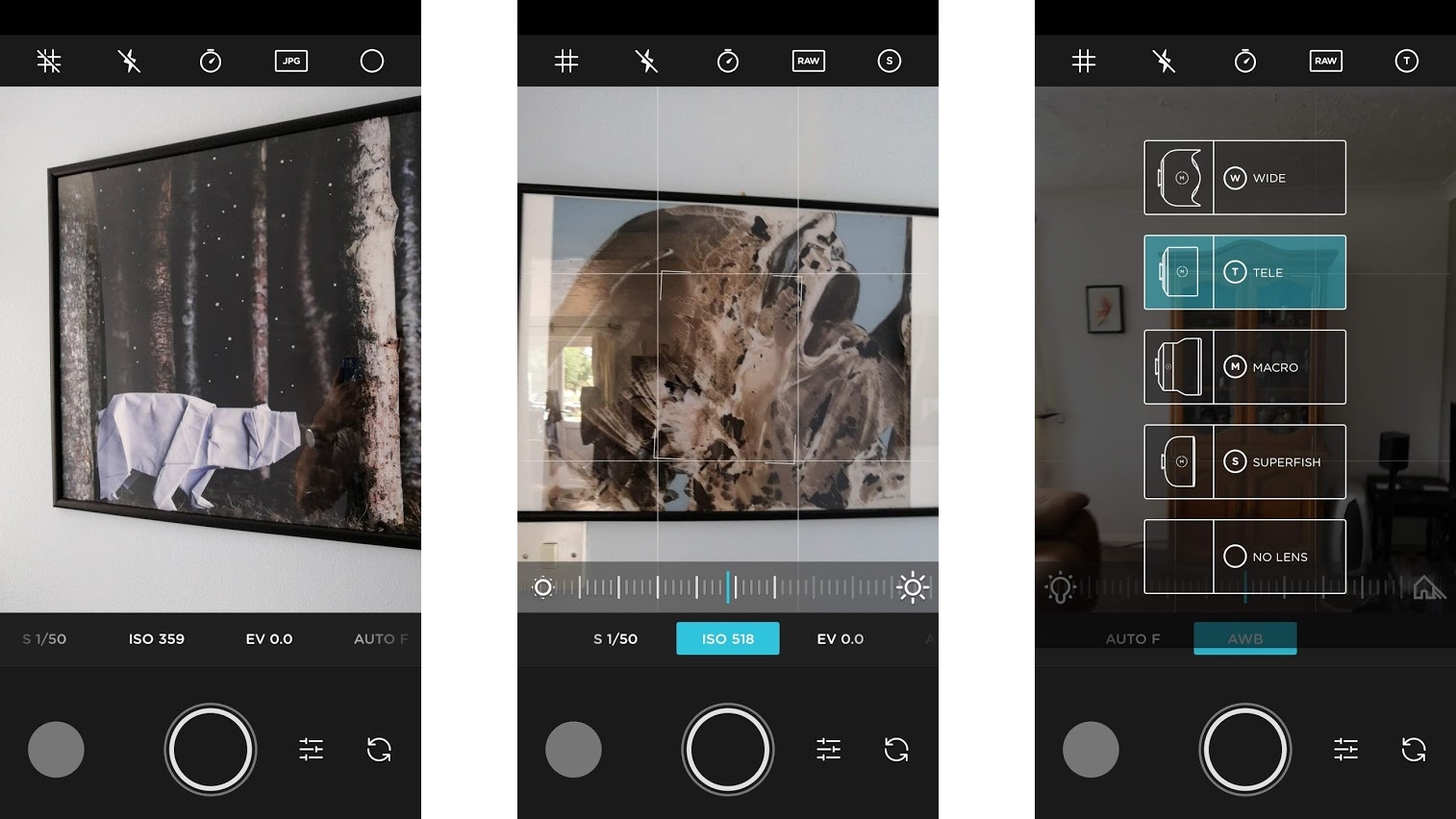
Moment – Pro Camera
$1.99/£1.79
A truly great camera app arguably needs to both avoid clutter and be packed full of manual controls, so you can capture an image exactly as you want it, but that’s a tough balance to strike, and few manage. Moment – Pro Cameraarguably does though.
It gives you full manual control, including RAW shooting, shutter speed, ISO, white balance, exposure compensation and focus. There’s also tap to focus, a timer, a grid and several different lenses. It’s an impressive toolkit, with the app focusing more on powerful utilities than gimmicky filters, but it all has a very clean, minimalist look.
And it’s designed with ease of use in mind. You can double tap any setting to return it to auto or double tap the viewfinder to turn everything back to auto and all the controls are within easy reach.
The main downside of Moment is that it can’t currently shoot videos, but for photos there’s a good chance you’ll want to replace your current camera app with this, and video is apparently in the works.
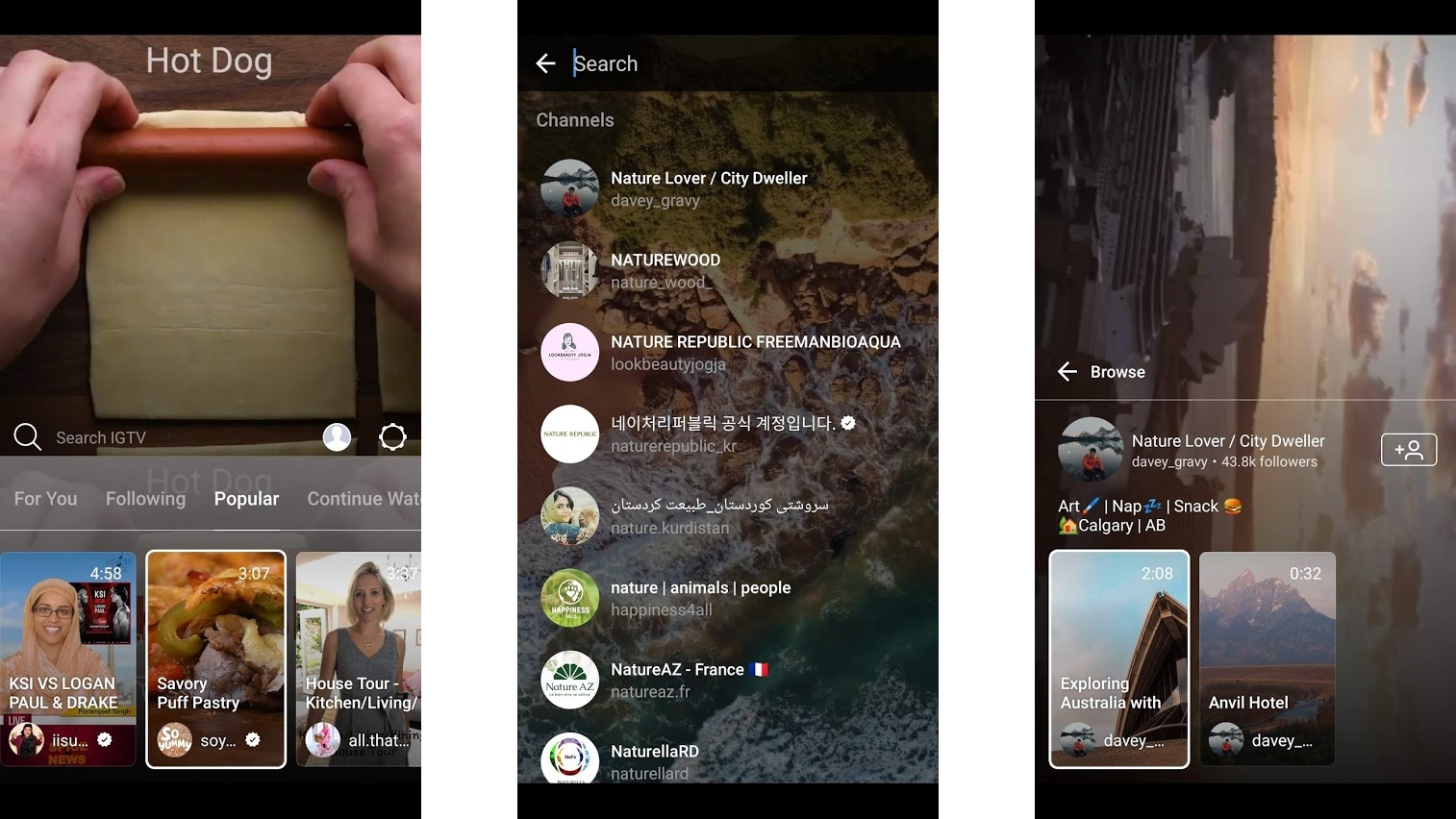
IGTV
Free
IGTV is a new app from Instagram that’s focused on long-form video content. Rather than the one-minute videos of old, you can now make and watch videos up to an hour in length. Videos are in full-screen portrait format, which is unusual for longer content, but makes it easy to hold your phone while watching.
If you already have an Instagram account you can simply sign in to instantly see content from people and brands that you already follow. You can also like and comment on videos, view popular ones and browse and search for content beyond the stuff that the app already highlights to you.
Technically, you don’t need the IGTV app to access all this stuff, as it’s also been added to the main Instagram app, but if long-form video content is the main thing you’re interested in rather than photos or shorter videos, then the IGTV app is the best way to get it.
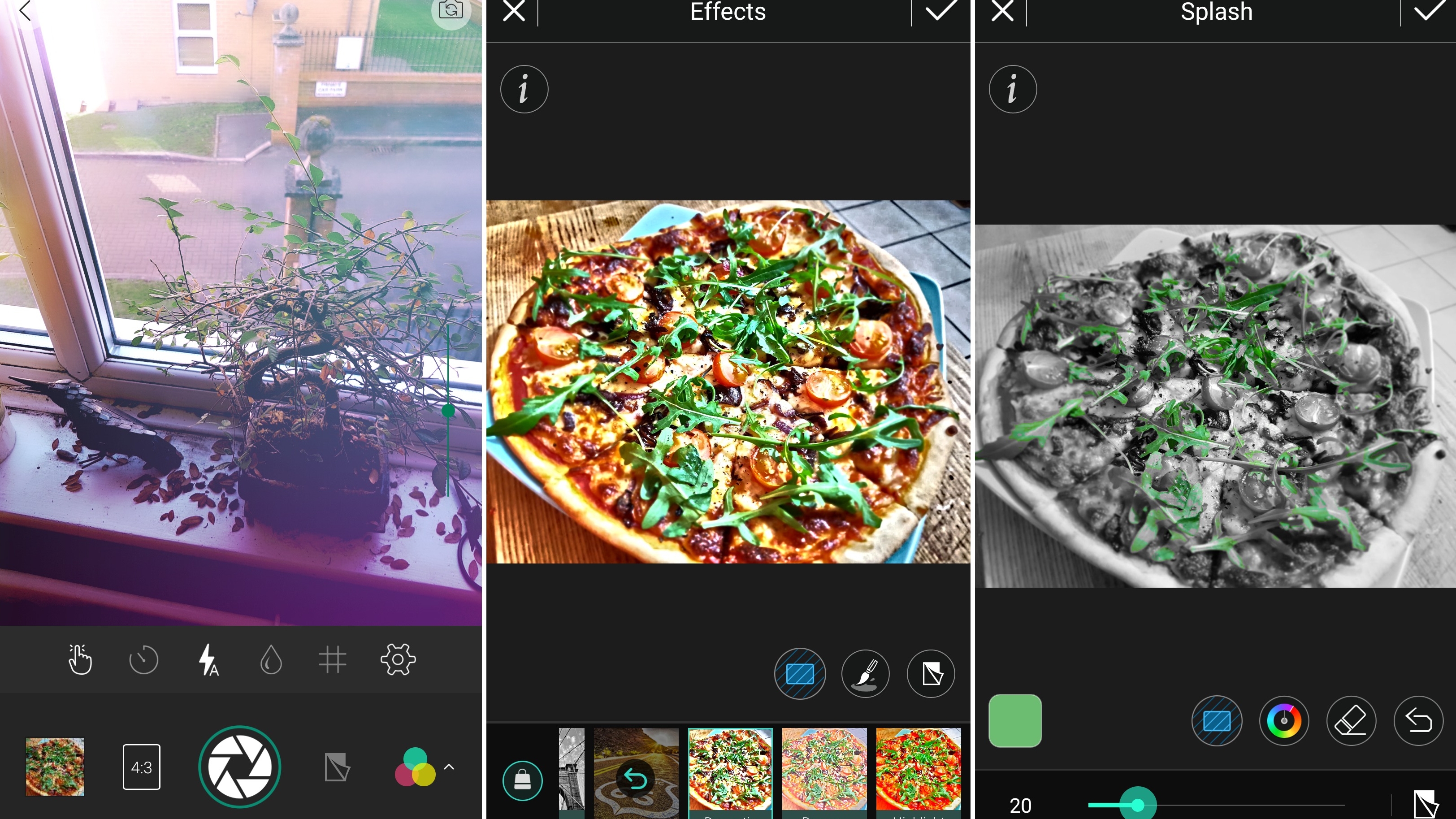
PhotoDirector
Free + optional subscription
Your phone might have a powerful camera, but chances are it doesn’t come with much in the way of photo editing tools. Fortunately, PhotoDirector can fill in the gaps.
This app lets you adjust the tone, saturation, white balance and colors of photos you’ve previously taken, as well as adding filters and effects, which you can adjust the strength of and apply to all or just part of an image.
You can also add text, stickers, frames, change the perspective, mirror the image, cut sections and a whole lot more.
There are lots of tools, but PhotoDirector is easy to navigate and you can always undo your changes, so you’re safe to experiment.
And that’s just the editing part of the app. There’s also a built-in camera, which lets you shoot new photos with various effects and see live through the viewfinder how they will affect the image.
PhotoDirector is largely free, but if you want to direct to your best there’s a premium version that costs £2.59 (around US$3.70) per month, with discounts if you commit for three months or a year. This unlocks additional tools, boosts the output quality and removes adverts.
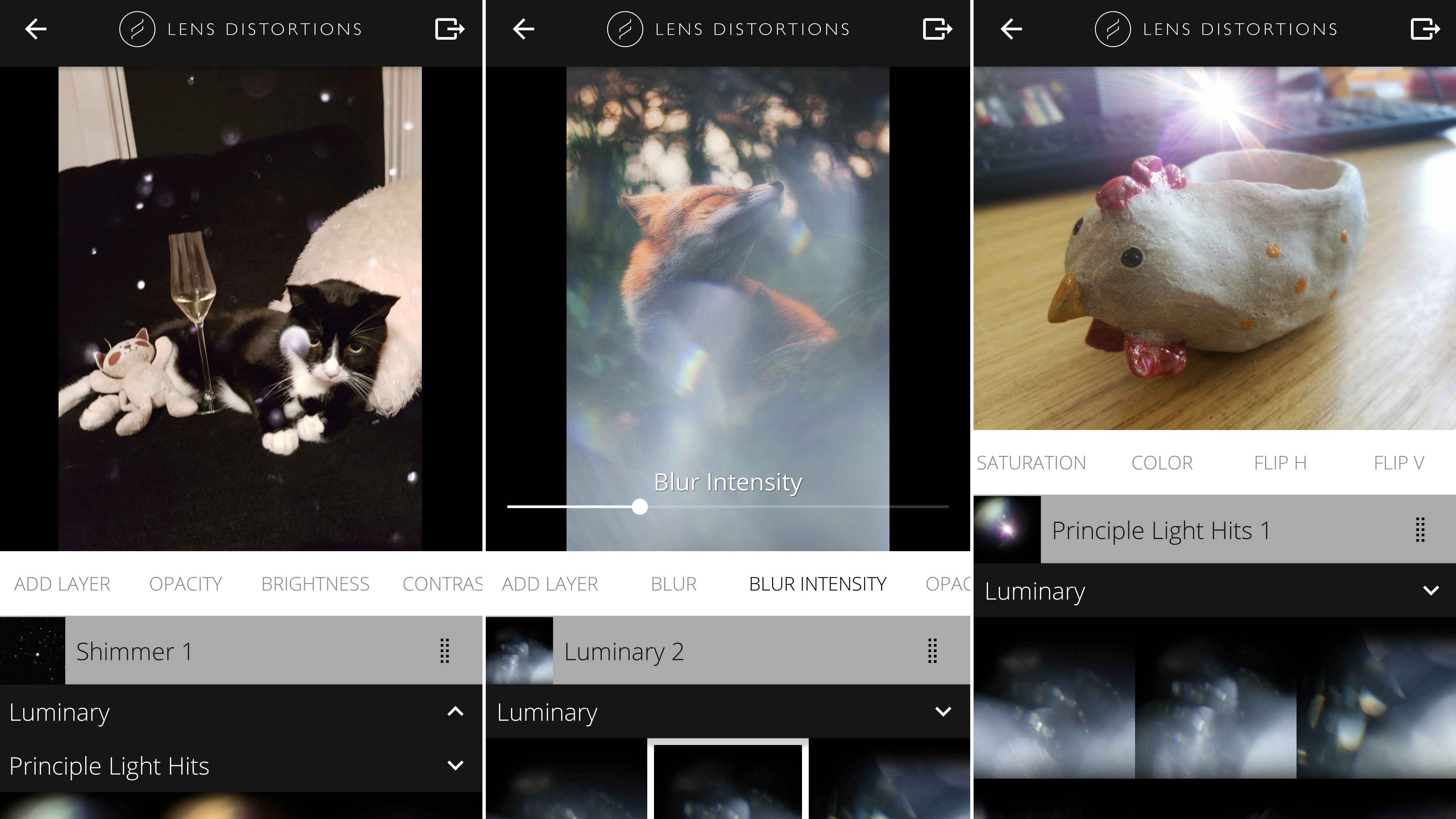
Lens Distortions
Free + $0.99/£0.99 monthly subscription
“The best effects are the ones no one knows you added.” So says the intro video to Lens Distortions, and it has a point.
Rather than flashy, gimmicky effects and photo filters, Lens Distortions has a selection of natural, true to life ones that look like they could have been captured by the camera itself.
These include sunlight, rain, snow and fog effects, so tend to be most suited to outdoor shots, but they look convincing and there’s a selection of different looks in each category.
Once you’ve applied a filter you can tweak it by adjusting the brightness, saturation, contrast and more, and add extra layers so you can apply more than one filter at a time.
The interface is slick and intuitive, and your edited photos can be saved to your phone or shared with various social media and cloud storage apps.
You get 40 filters for free at time of writing, but for a $0.99/£0.99 monthly subscription you can unlock additional filter packs and 215 premium filters. As a one-off purchase it would have been easy to recommend, but as a subscription it’s probably only worth it if you find yourself using Lens Distortions a lot. Either way though the free version is well worth a download.
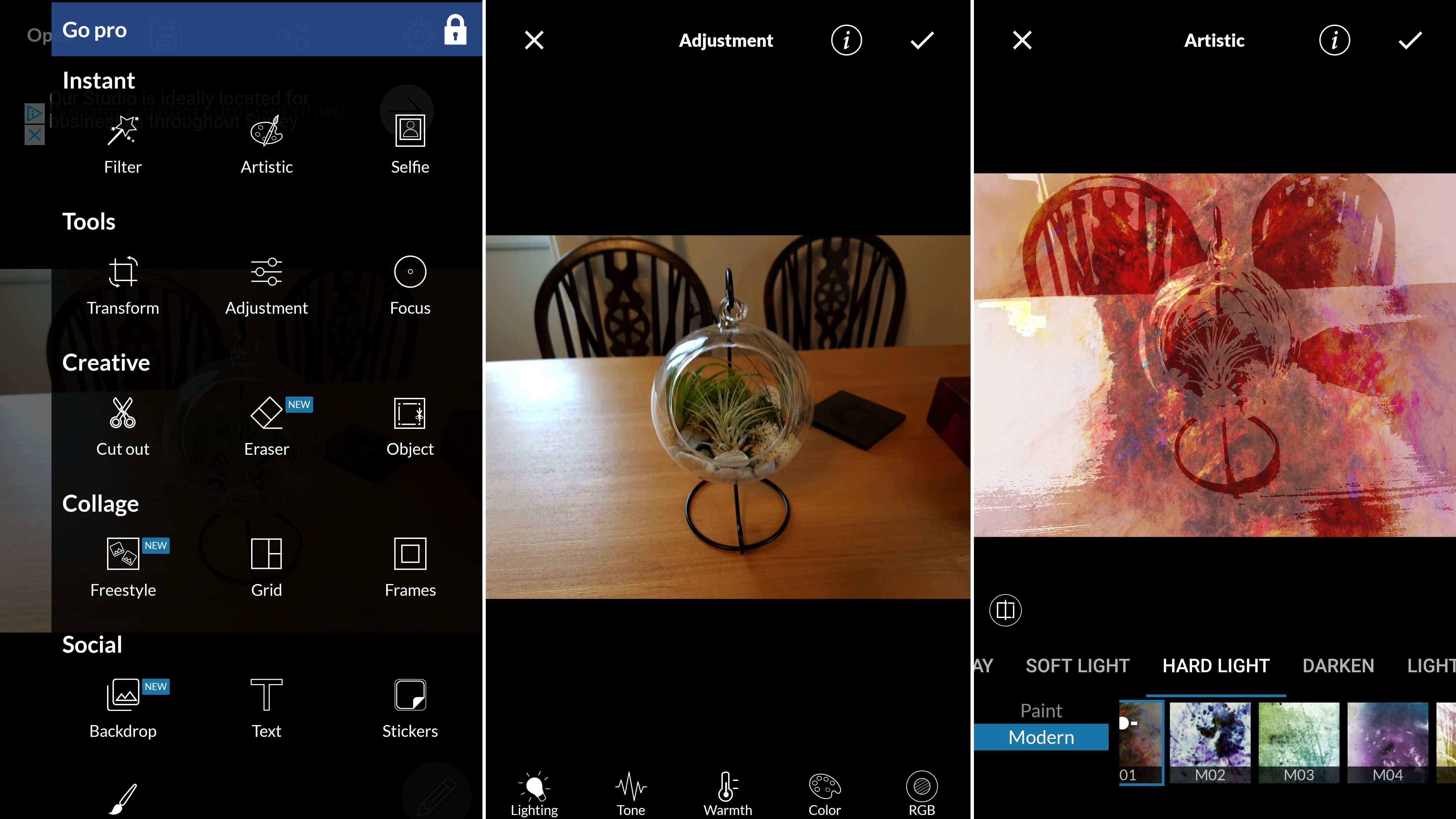
LightX Photo Editor
Free + $3.69/£3.49 IAP
If you want an all-in-one photo editor for Android then LightX Photo Editor is a good choice, not least because most of the features are free.
You can merge photos, add effects and filters, selectively apply colors to regions of an image, adjust the color balance, smooth and sharpen images, crop them, rotate them, draw on them, add frames and stickers, add text, create collages and a whole lot more.
That’s all handled through an intuitive interface; bring up the main menu with a tap, select the category of edits you want to make (filters or frames, for example) and you’ll be taken to a menu with all the relevant options.
Most of it is fairly self-explanatory, but there are also tutorial videos for if you get stuck, and for a one-off $3.69/£3.49 IAP you can get rid of adverts, unlock additional stickers and frames, and add the ability to save images in PNG format.
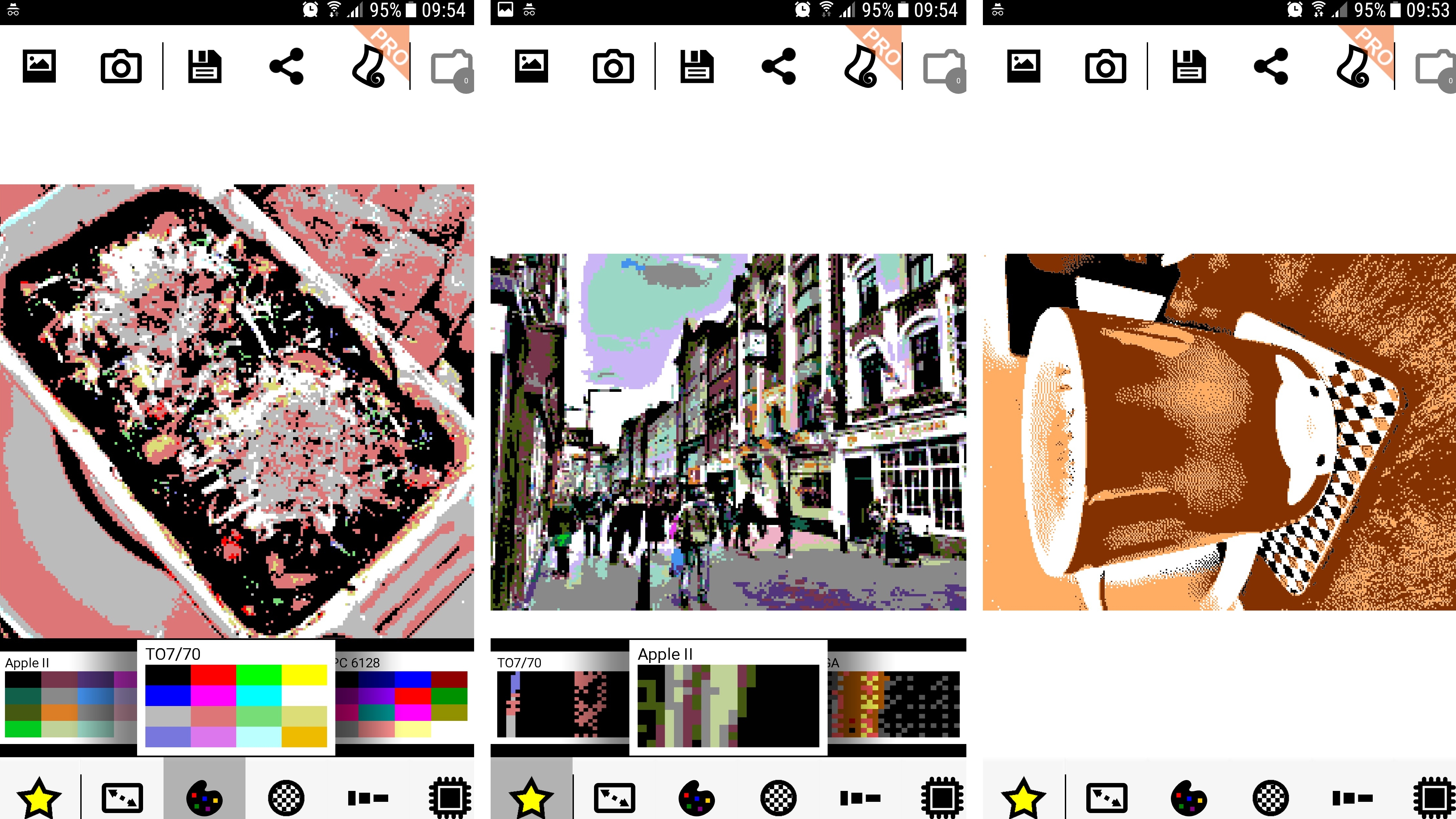
8Bit Photo Lab
Free + IAP
8Bit Photo Lab is a photo filter app that takes you back to simpler times. Times when games didn’t have near-photo-realistic graphics and Android was just a glint in Andy Rubin’s eye.
Simply snap or import a picture and pick a color palette from over 50 options, such as Game Boy or Commodore 64. Your photo will then instantly transform into something you might have seen on a screen from that era.
But that’s just the beginning, you can also add effects such as noise and checkerboard patterns, change the resolution and aspect ratio, tweak the contrast, saturation and brightness, and add 8-bit stickers, such as a mouse cursor, or little characters that look like they’ve come straight out of a game from the late 80s.
Essentially, 8Bit Photo Lab is like Prisma for anyone who prefers old-school video games to modern art, but it’s a well thought-through app.
Once you’ve tweaked an image to perfection you can add exactly the same filter to other photos with a swipe, for example, and while you get plenty for free, you can unlock lots of extra options with an IAP, including the ability to turn your creations into animated wallpapers.
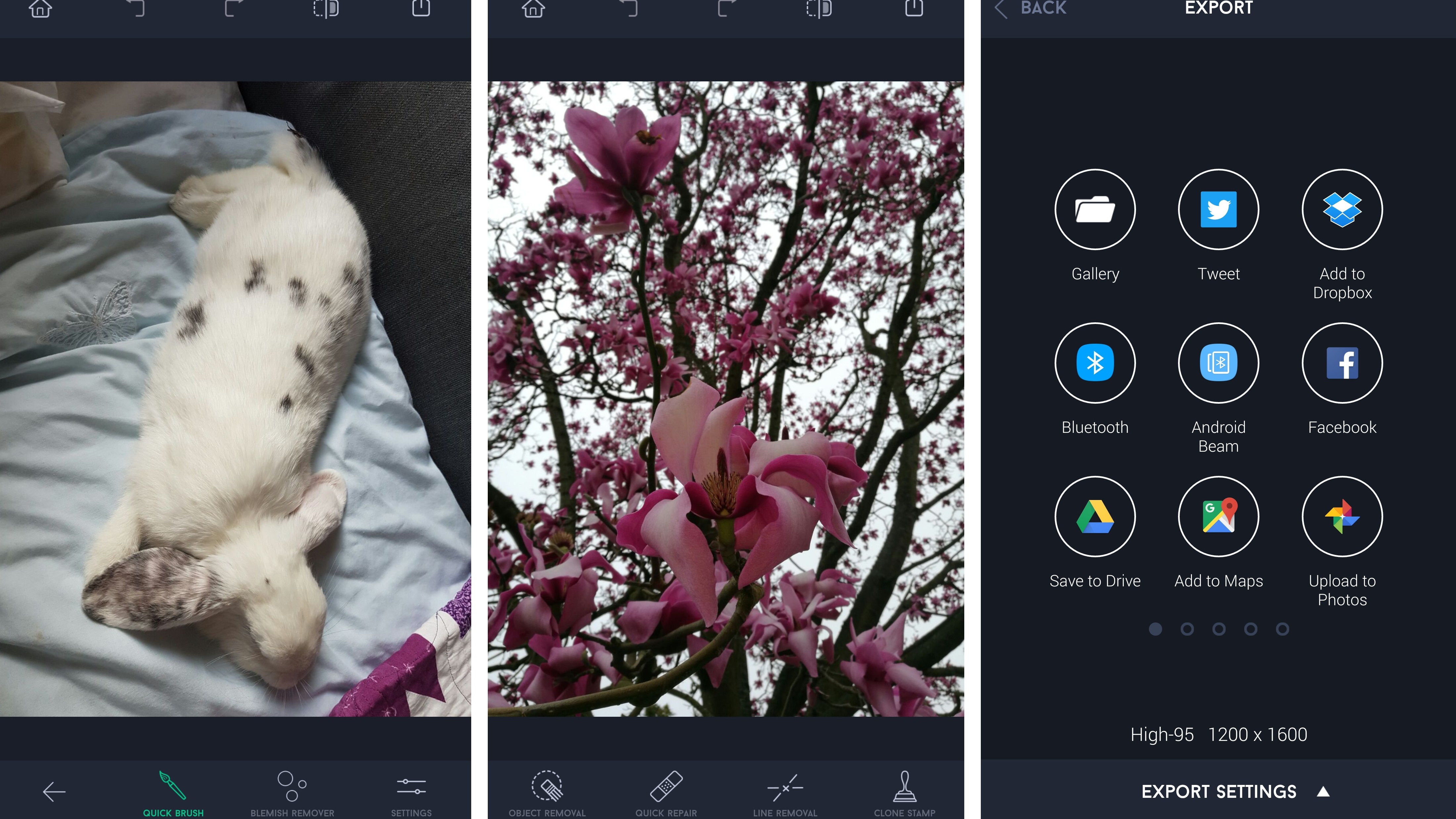
TouchRetouch
$1.99/£1.99
No matter how good your smartphone camera is your images can still be ruined by unwanted additions, be it people in the background, a trash can in your landscape or blemishes on your own face.
TouchRetouch is here to help, by removing anything that you don’t want in your shot. You can get rid of unwanted objects by highlighting or circling them, and simply tap a blemish to remove it.
There are additional tools to clone or mirror parts of the image, and video tutorials to help you get more out of the app – though most of the features are fairly self-explanatory.
Results aren’t always perfect, with the app trying but not always entirely succeeding to hide the seams when you cut someone out, but you don’t have to save any changes you’re unhappy with and it generally does a surprisingly good job, all with only a few taps from you.
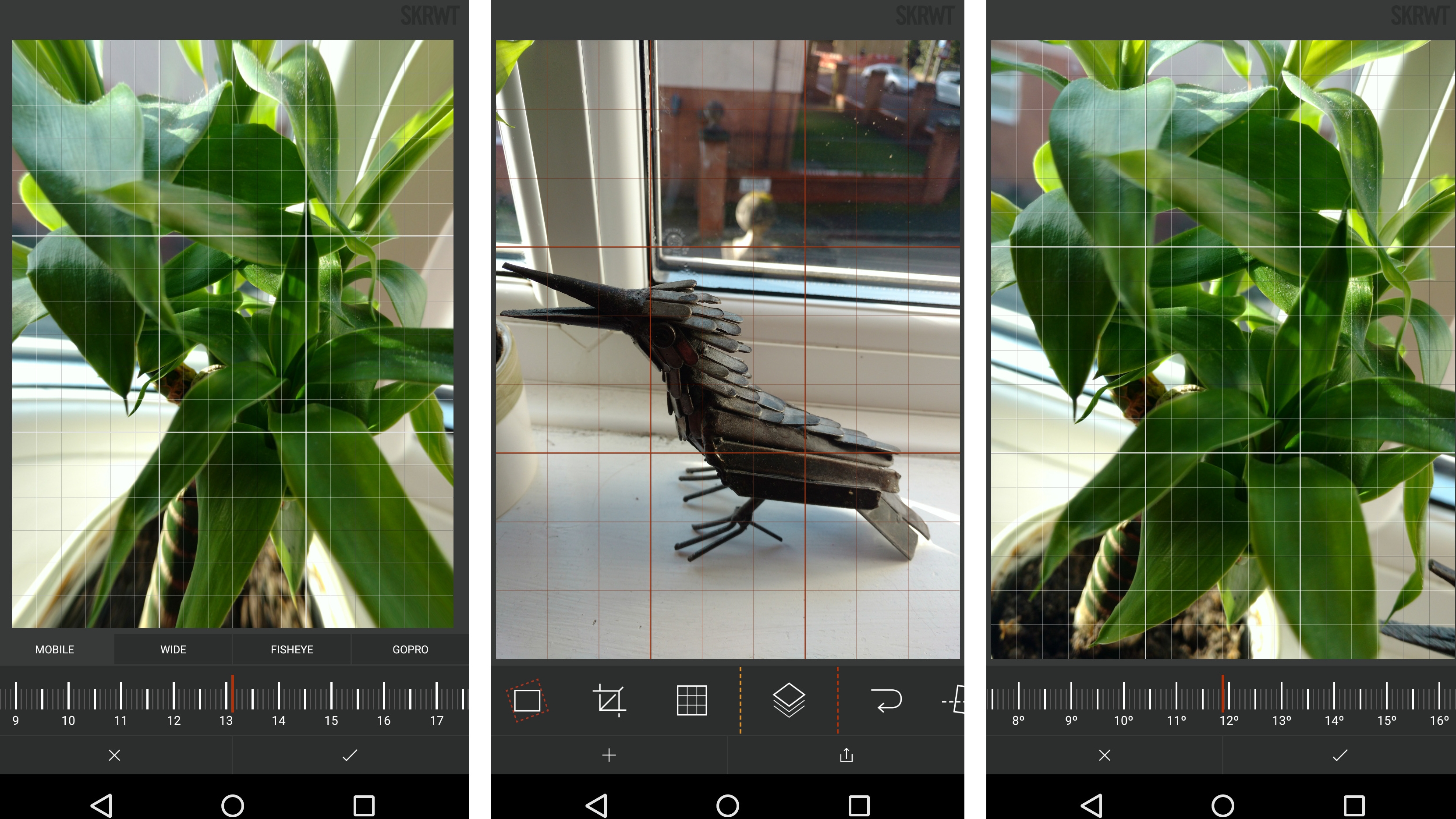
SKRWT
$1.49/£1.39
There are plenty of photo editing apps, but while most offer filters and effects few allow you to alter the perspective of a photo in the way SKRWT does.
There are no stickers here, no makeup modes and no real effects. Instead there are tools to shift the perspective, change the ratio and correct lens distortion.
You can also flip, rotate, mirror and crop images, but SKRWT isn't interested so much in modifying photos in unnatural ways, as in making them look exactly as you envisioned when you took them.
It's a professional tool, but it's easy to use and you can always undo your changes if you don't like them.
Our favorite Android apps for painting, drawing, sketching, design and animation.
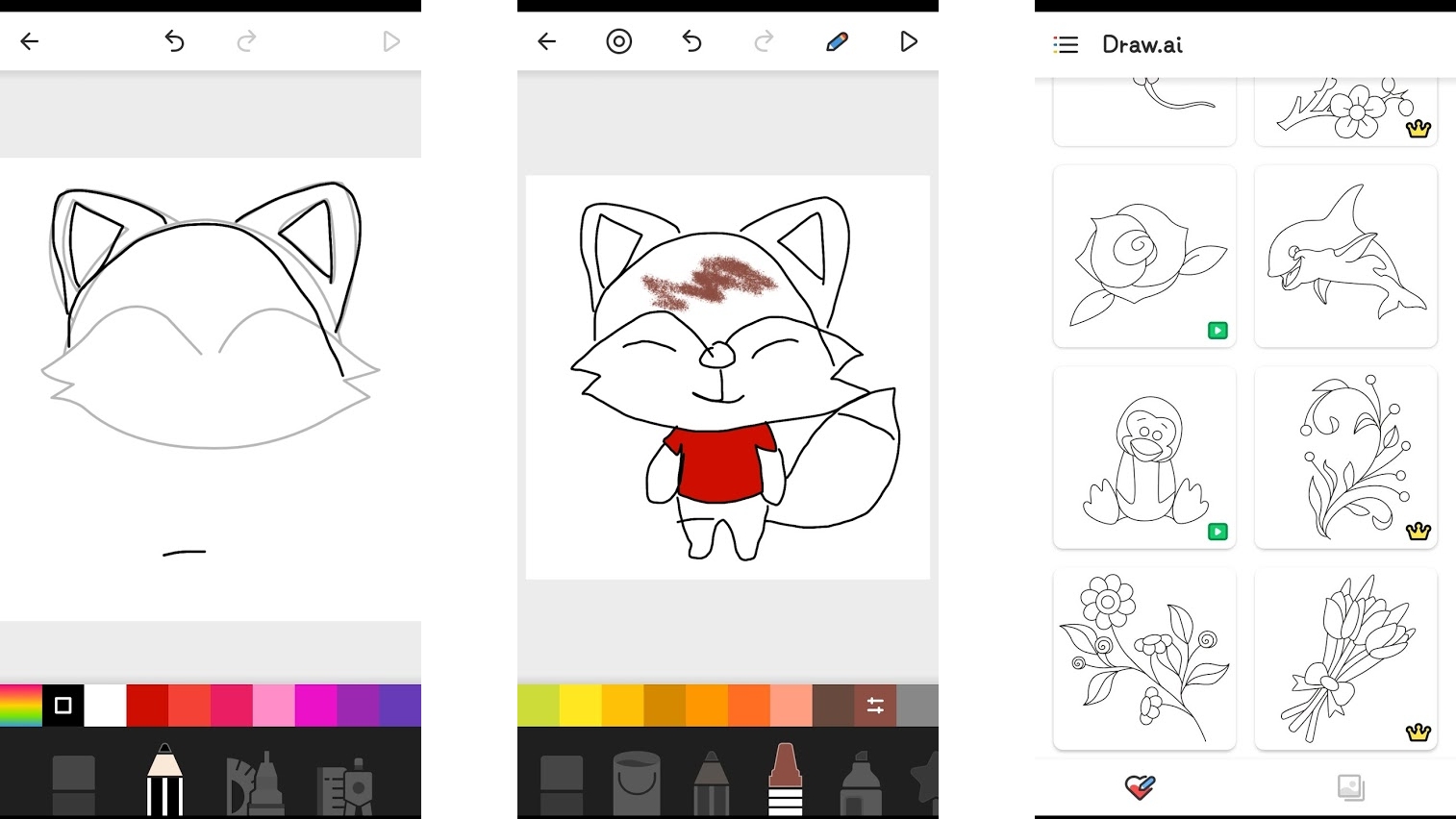
Draw.ai
Free + various IAP
Digital devices seem an ideal fit for drawing tutorials, yet few drawing apps seem to take advantage of them. Instead they often assume you already know what you’re doing or will learn outside the app, while many of the ones that do teach you rely on static images and text, but Draw.ai is more interactive.
While not a comprehensive guide to drawing, it offers a large assortment of images and guides you towards recreating each one step by step, one line at a time. By which we mean the app will draw a line or two from the image, then make it appear faint so you can draw the same thing over it.
This continues until the image is complete, after which you’re free to color it (without a guide). Once you’re finished, Draw.ai will show a short video of the entire process you went through.
The actual drawing tools are more limited than some apps, but there is at least a handy undo button that erases the last line you drew or change you made – something beginners will be making use of a lot.
Many of the images are free and more are added all the time, but to access everything you’ll have to pay a $5.99/£5.49 weekly subscription (with big discounts available if you pay monthly or yearly instead – you can get a full year for $59.99/£52.99).
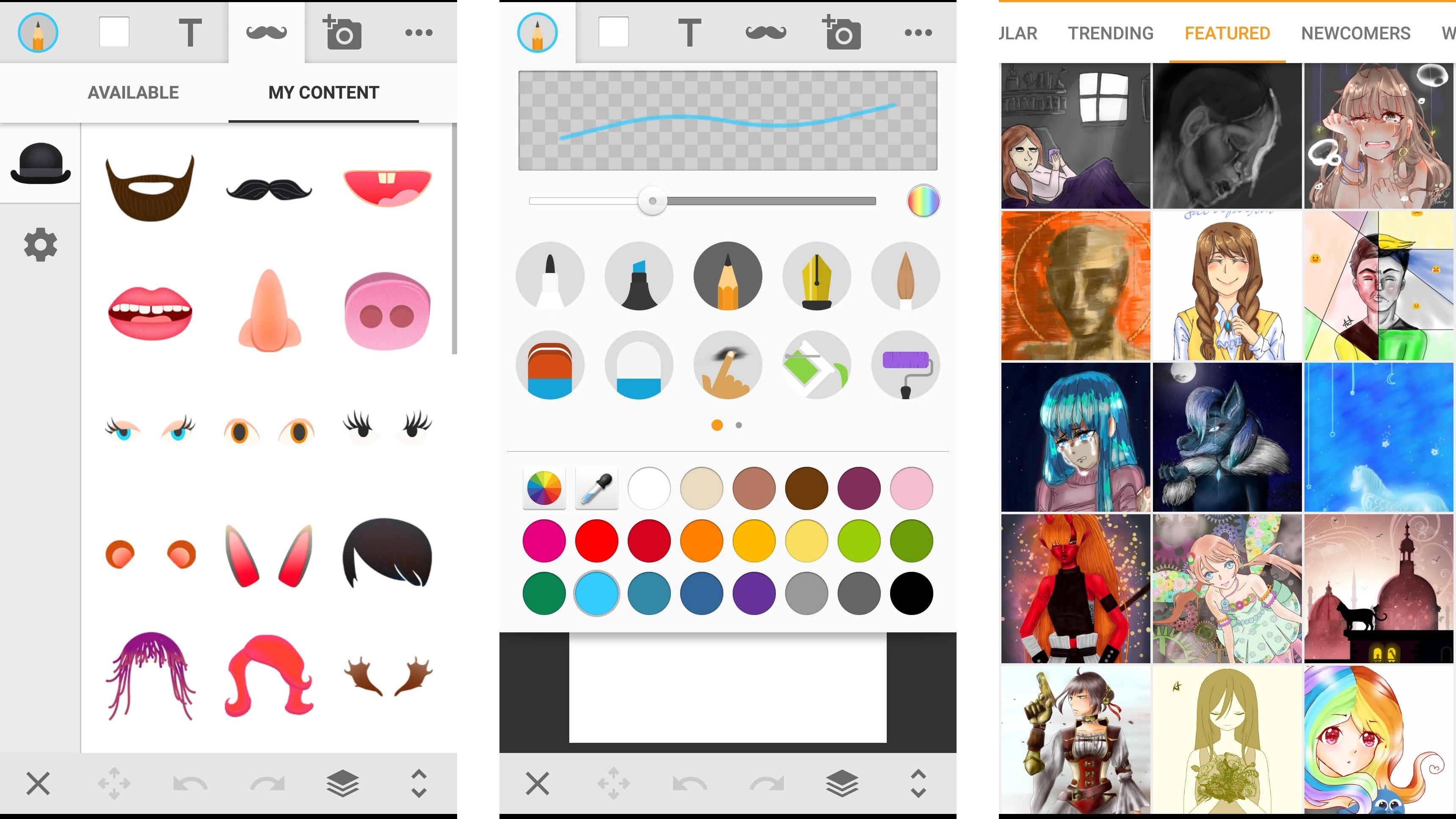
Sketch - Draw & Paint
Free + various IAP
Sketch – Draw & Paint is a photo editor, sketching app and art community all in one, and while it’s not the deepest option for any of those things, it’s fun and easy to use.
On the sketching side you get a variety of different pen and brush types of different sizes and colors, along with the ability to add text and stickers and some basic tools, such as a ruler and layers.
You can either start with a blank canvas or take or import a photo, which brings us to the photo editing aspect of Sketch, an aspect which relies on the same set of tools.
As for the community, Sketch lets you upload your creations and share them with other Sketch users, as you can also browse through people’s artworks. There are categories for this, including ‘trending’ and ‘newcomers’, or you can just search for something specific.
You can comment on or like any of the shared artworks, and follow their creator so you can more easily keep track of any other work they produce. The actual quality of work in the community is varied, but that means it should be less intimidating to share your own.
Sketch – Draw & Paint is mostly free, but you can buy extra sticker packs or for £0.99 (around US$1.30) per month subscribe to Sketch Premium to unlock all the stickers, remove adverts, get a transparent background and be able to use a custom canvas size.
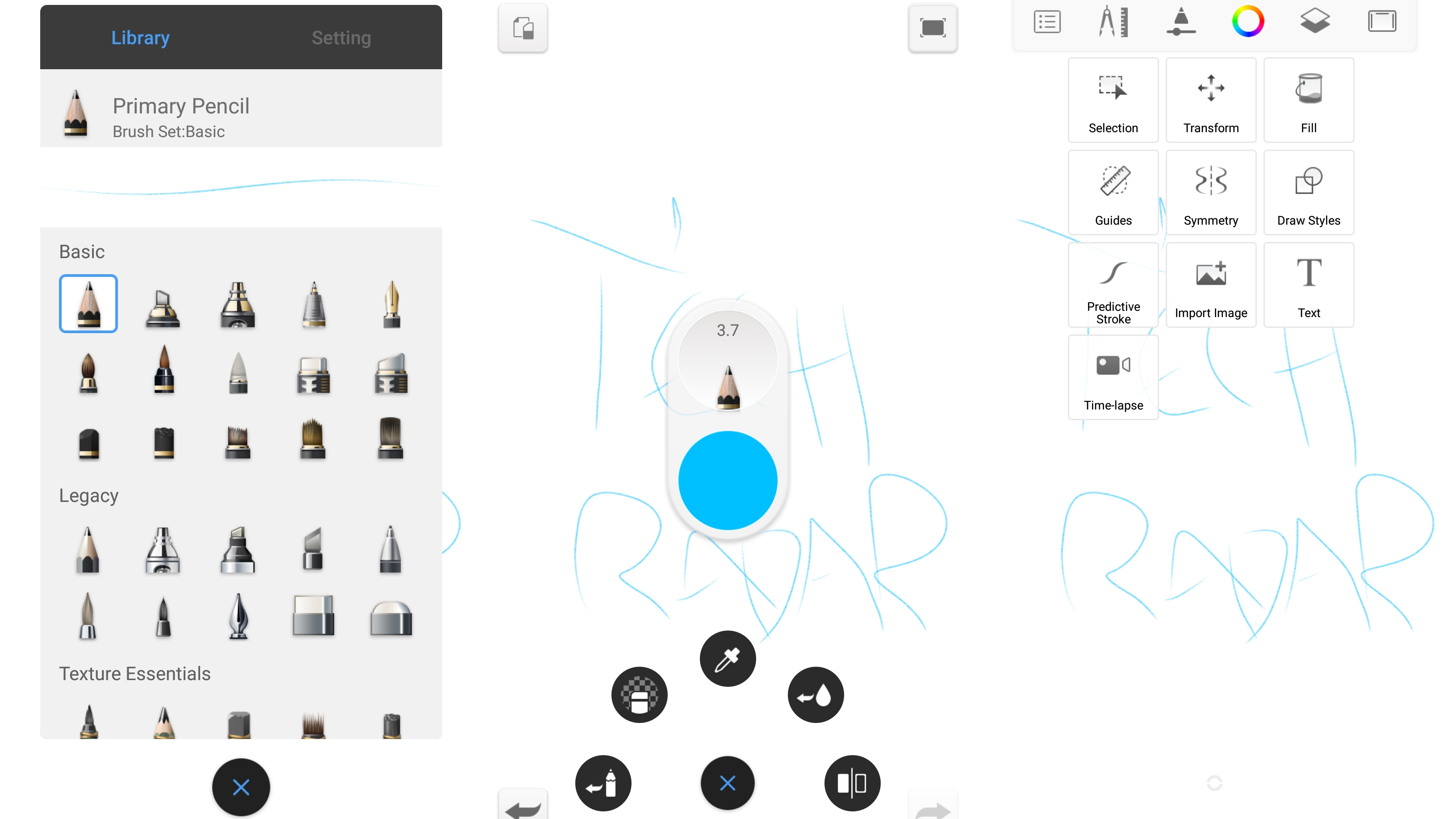
SketchBook
Free
You’ve probably come across SketchBook before – if not on Android then on iOS or desktop. This Autodesk sketching tool has been around for a long time and is one of the bigger names in the space, but it’s worth a second look because it’s now completely free, whereas many of the features were previously behind a paywall.
That means you can access loads of preset brushes, import images in any quality, customize the canvas size, and do many other things that previously you’d have had to pay for.
And, of course, you can sketch, with all the tools combining to make SketchBook one of the most powerful mobile options around.
You’ll need a tablet or at least a large phone to make the most of it, but as it’s now totally free there’s nothing to lose in downloading it and giving it a try, even if you have a smaller device.
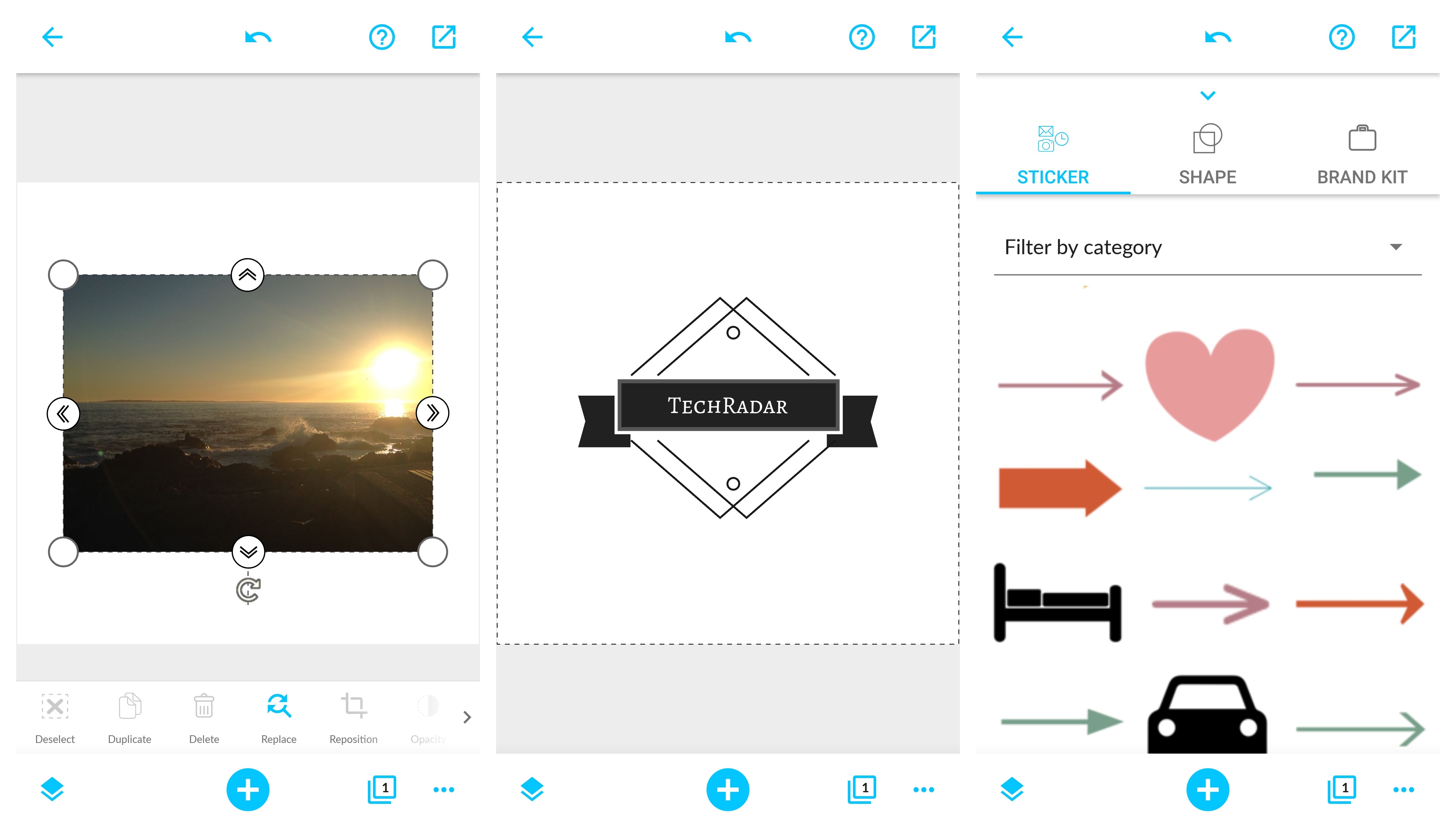
Desygner
Free + $7.49/£5.99 subscription
Desygner lets you unleash your inner graphic designer on your phone or tablet, but with an intuitive interface and thousands of templates it’s simple enough for beginners to use.
You can combine text, shapes, images, stickers, backgrounds and more to create logos, posters, adverts, PowerPoint-like presentations, postcards or any number of other things where images and typography are important.
Each component of your design can be moved, resized, rotated, flipped, duplicated or have its color changed, and you can work with multiple layers. Results can then be saved to your device to be used wherever you want.
We suspect it might be a bit limited for professional graphic designers, who may want more freedom to completely create designs from scratch, but for everyone else Desygner is a great way to make something that looks professional.
The basic app is free but certain features, as well as the majority of the templates, require a monthly subscription which costs $7.49/£5.99. That’s probably worth it if you’re going to use the app semi-regularly, but if you just want to design something as a one-off you might find the free version good enough.
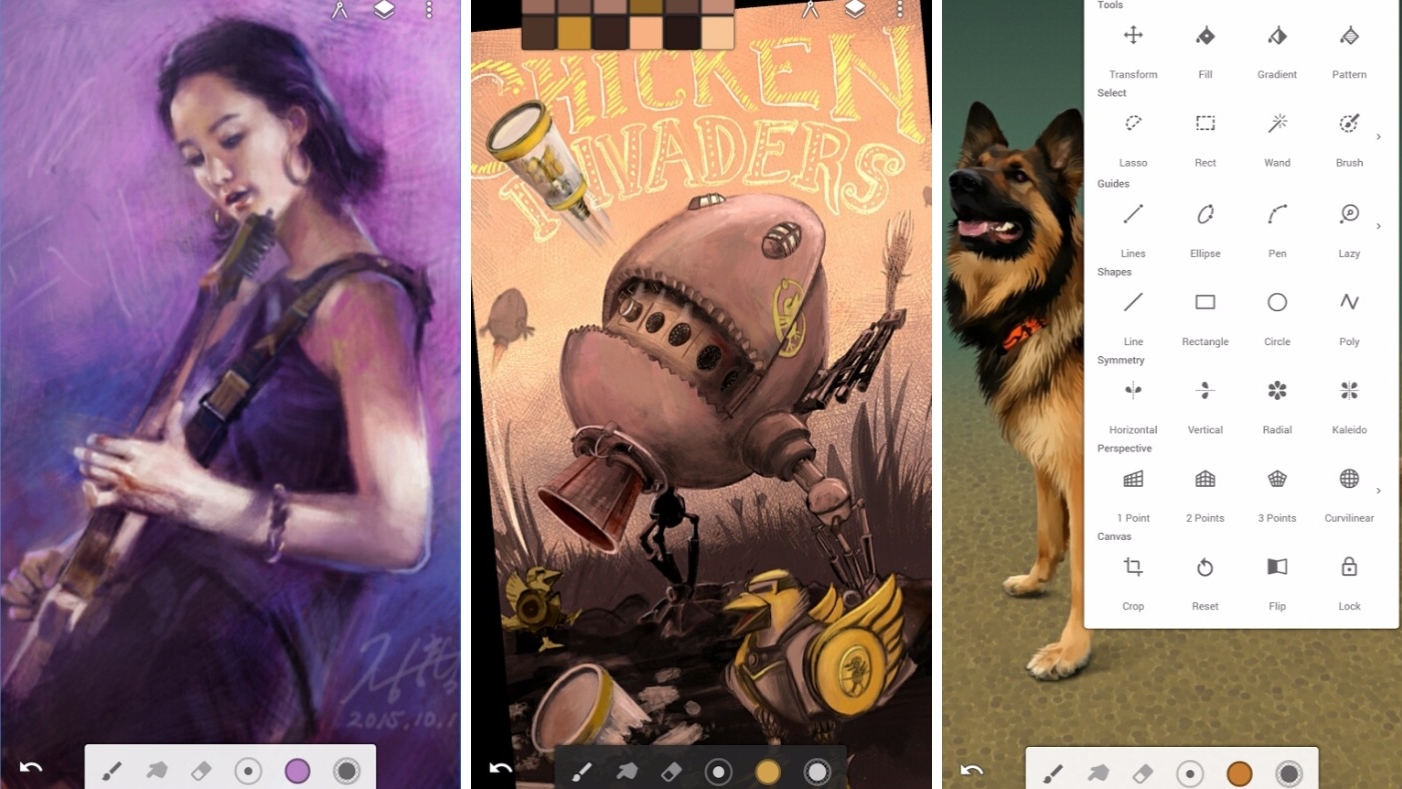
Infinite Painter
$7.99/£6.99
There’s no shortage of apps for digital artists, but Infinite Painter is one of the most feature-packed, with dozens of brush presets and the ability to create your own, along with layers, blending, editing tools and more, plus the option to export your images as JPEG, PNG, PSD or ZIP.
But as well as being packed full of features, Infinite Painter also takes the time to show you how they all work, with detailed tutorials and guides, although the interface is so simple that you should be able to muddle your way through most things anyway.
A lot of the features are hidden behind a paywall, with it costing $7.99/£6.99 to unlock everything, but the app includes a free seven-day trial, letting you try everything out before you decide whether you want to put money down, which if you’re a fan of digital art you probably will, because you get a lot for your money.
Our favorite Android apps for learning new things, from history to music to coding and beyond.
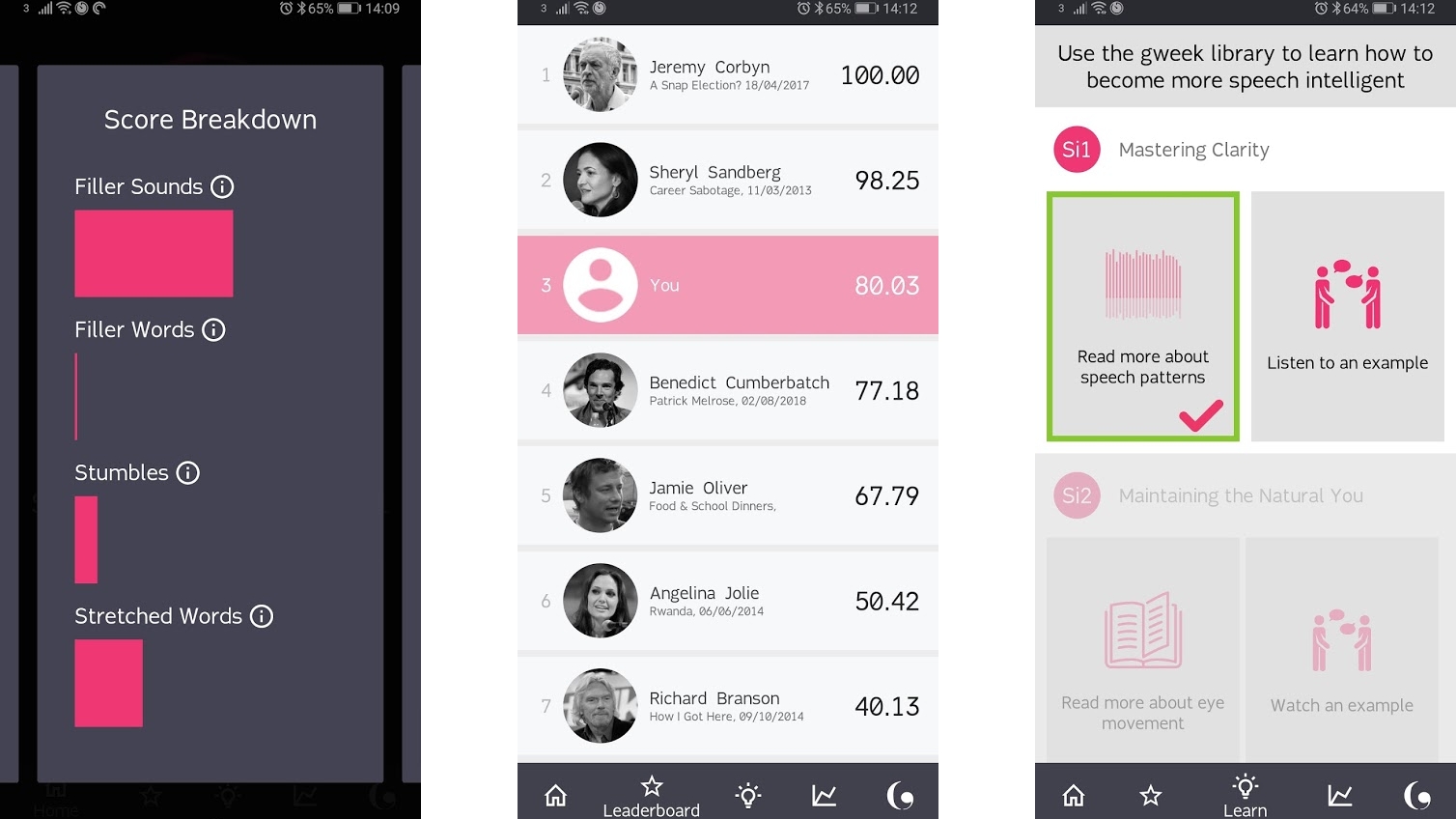
Gweek
$6.99/£6.49 monthly subscription
Ever wish you could speak more clearly? Or just wonder how clear a communicator you actually are? Gweek can help with the first of those things and answer the second.
Simply launch the app and talk into your phone for between one and two minutes about anything you want, then Gweek will analyze your speech, give you a score out of 100, tell you how to improve and show where you rank compared to various famous people.
When you’re ready you can try speaking for another one to two minutes, taking the advice on board, and see how your score changes.
You can also see things like how many filler words you use and how much you stutter, and there are additional tools to help you improve, such as guides to speech patterns and eye movements, and audio and visual examples.
Gweek could genuinely make you a better communicator, which could help in all parts of your life, from your relationships to advancing professionally and even gaining confidence.
However, to use it beyond getting your initial score you’ll need to pay a monthly subscription of $6.99/£6.49. That seems steep, but it’s a genuinely useful app and does something we’ve not come across before.
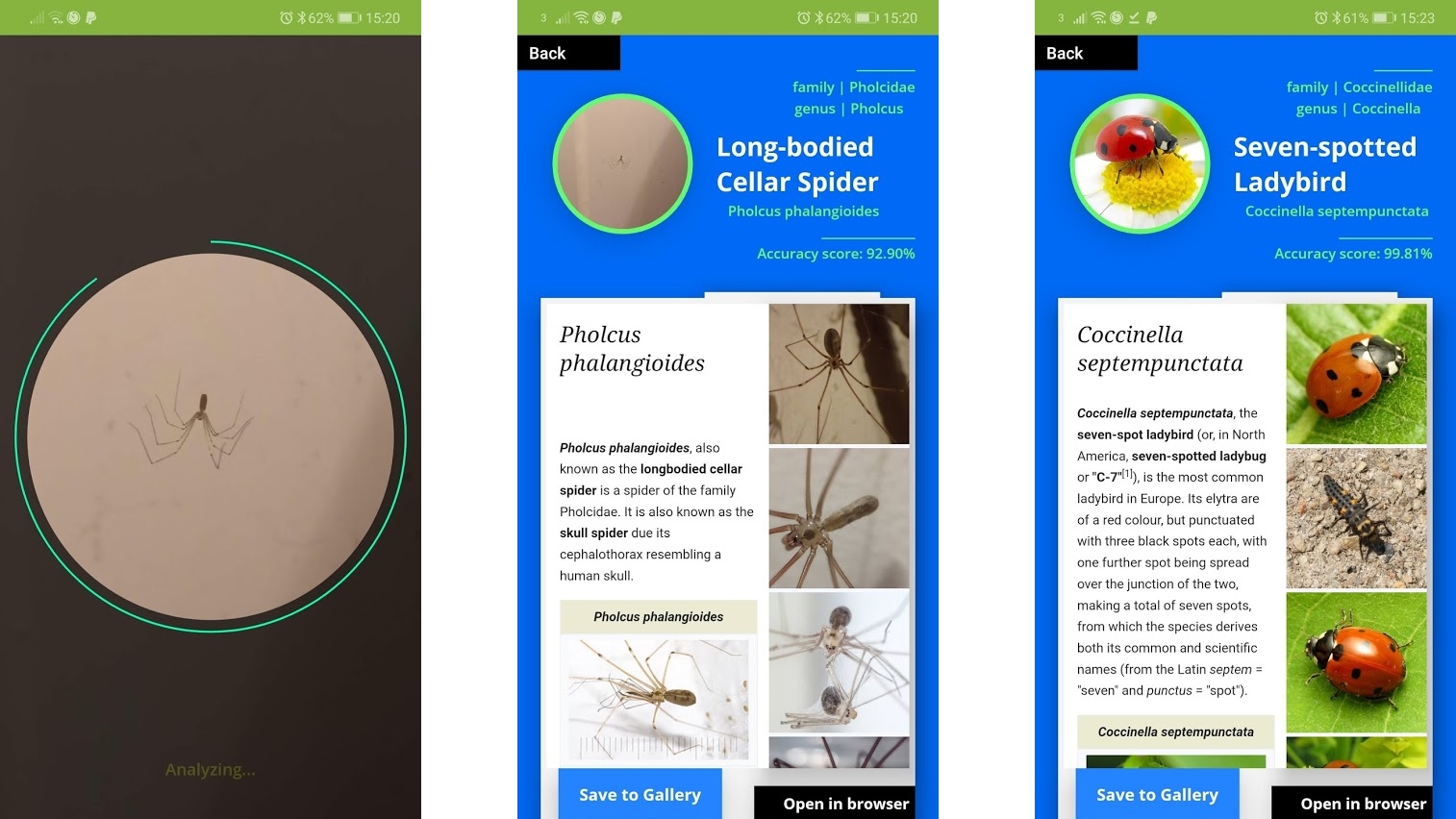
Insect Identifier
$4.99/£4.79
There are numerous apps for identifying plants and now there’s a similar one for identifying insects. With Insect Identifier you can take or import an image of an insect, the app will then analyze it and tell you what you’re looking at.
It will give a percentage for how sure it is of the result, and the results are typically quite detailed, including a gallery of images and various information on things like the biology of the insect and where it’s usually found.
You can save results if you want to come back to them later, but you have to manually tell the app to save them, otherwise they’re gone until you snap that insect again.
Insect Identifier is a basic but genuinely useful app, and while we haven’t been able to test it out too much (due to there not being a huge amount of visible insects near us) results generally seem accurate as long as you get a photo that’s in focus and fairly close up. That latter point can be tricky, and in some cases unappealing, but if you really want to know what something is it’s worth the effort.

Toca Nature
$3.99/£3.99
If you have mixed feelings about letting your kid loose on a smartphone then Toca Nature could be a compromise, making them just as interested in the great outdoors as the screen in front of their face.
The app gives you a mostly empty expanse of grass that you can build mountains, lakes, rivers and forests on – all by selecting what you want and then swiping your finger across the part of the landscape where you want it to appear.
This interaction is wonderfully tactile, with mountains rising as you rub repeatedly across the same area and trees sprouting when you glide your finger.
Once you’re done creating your landscape it’s time to explore, with the app letting you zoom in, wander around and even interact with the animals that have made this space their home, feeding them various treats and hunting out more across the landscape. You can take photos of your world and there’s even a day and night cycle.
While Toca Nature is designed for young children it’s a testament to how good it is that it could appeal to all ages – though older users will probably tire of the limited toolset quickly.
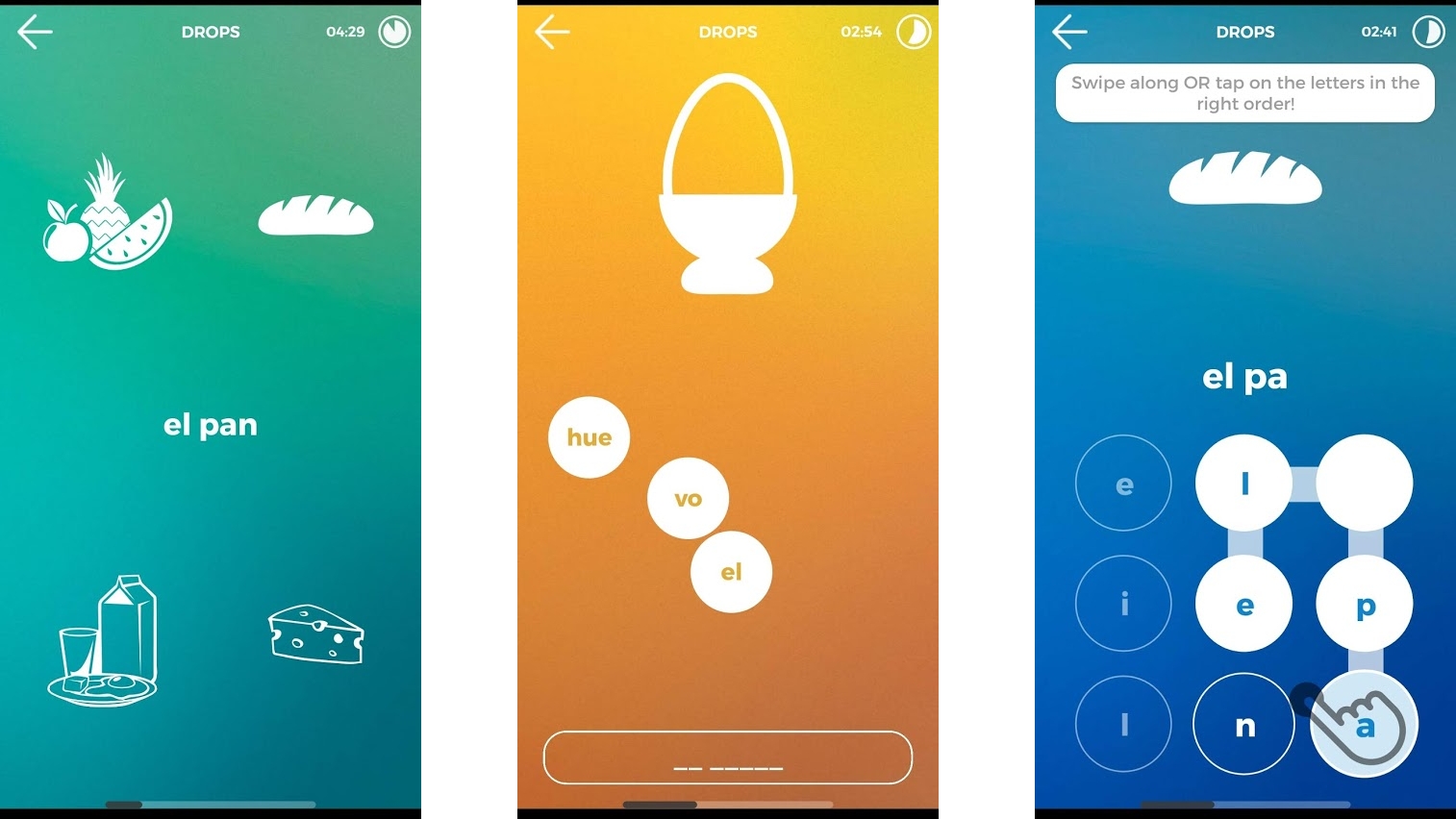
Drops
Free + $10/£8.99 monthly subscription
Apps have revolutionized language learning, but there’s more than one way to learn from an app, and while some focus on typing and speaking, Drops leans into the strengths of a smartphone by making all interactions swipe- and tap-based.
Drops gives you a series of exercises to carry out each time you use it, taking various forms. One asks you to swipe a word to its corresponding picture, another asks you to tap pairs of words and pictures, and one breaks up a word or phrase into several parts and has you tap them in the correct order.
There are others too, and Drops has a lot of content covering all sorts of categories from food to plants and even politics in a variety of languages. Impressively, it also feels as slick and polished as Duolingo, without imitating it.
Drops gives you five minutes of language learning each day for free, but the app is designed to be bite-sized and the makers claim this is enough to make progress.
If you do want more though you can pay for unlimited access at a price of $10/£8.99, with discounts available if you pay for a year upfront.
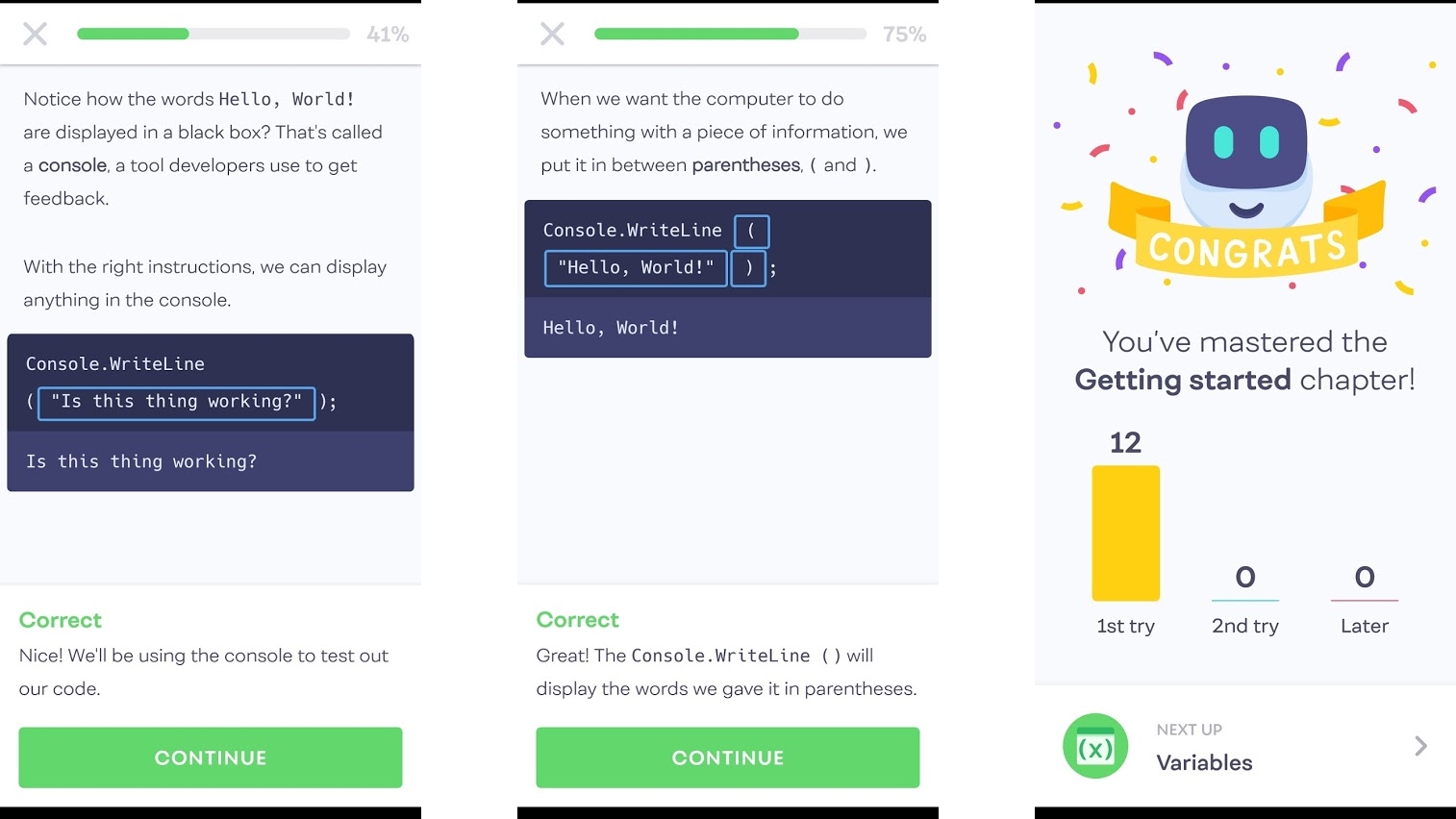
Mimo: Learn to Code
Free + $9.99/£8.99 monthly subscription
The first step in learning to code is deciding what coding language to learn, and that can be a tough decision, as there are a lot of options.
Mimo helps with that, first asking you a series of questions in an attempt to find out why you want to code, then creating a curriculum for you, focusing on the language and skills that are more relevant to your needs.
The lessons are bite-sized and fun, so you can easily and enjoyably fit them into your day, and while we doubt you’ll become an expert from the app alone, it’s a great way to get started or to supplement other coding classes.
You can get started for free, but to unlock the bulk of the content you need to upgrade to premium, at a cost of $9.99/£8.99 per month. Though currently you can get a big discount if you pay for a year upfront, making it a whole lot cheaper.
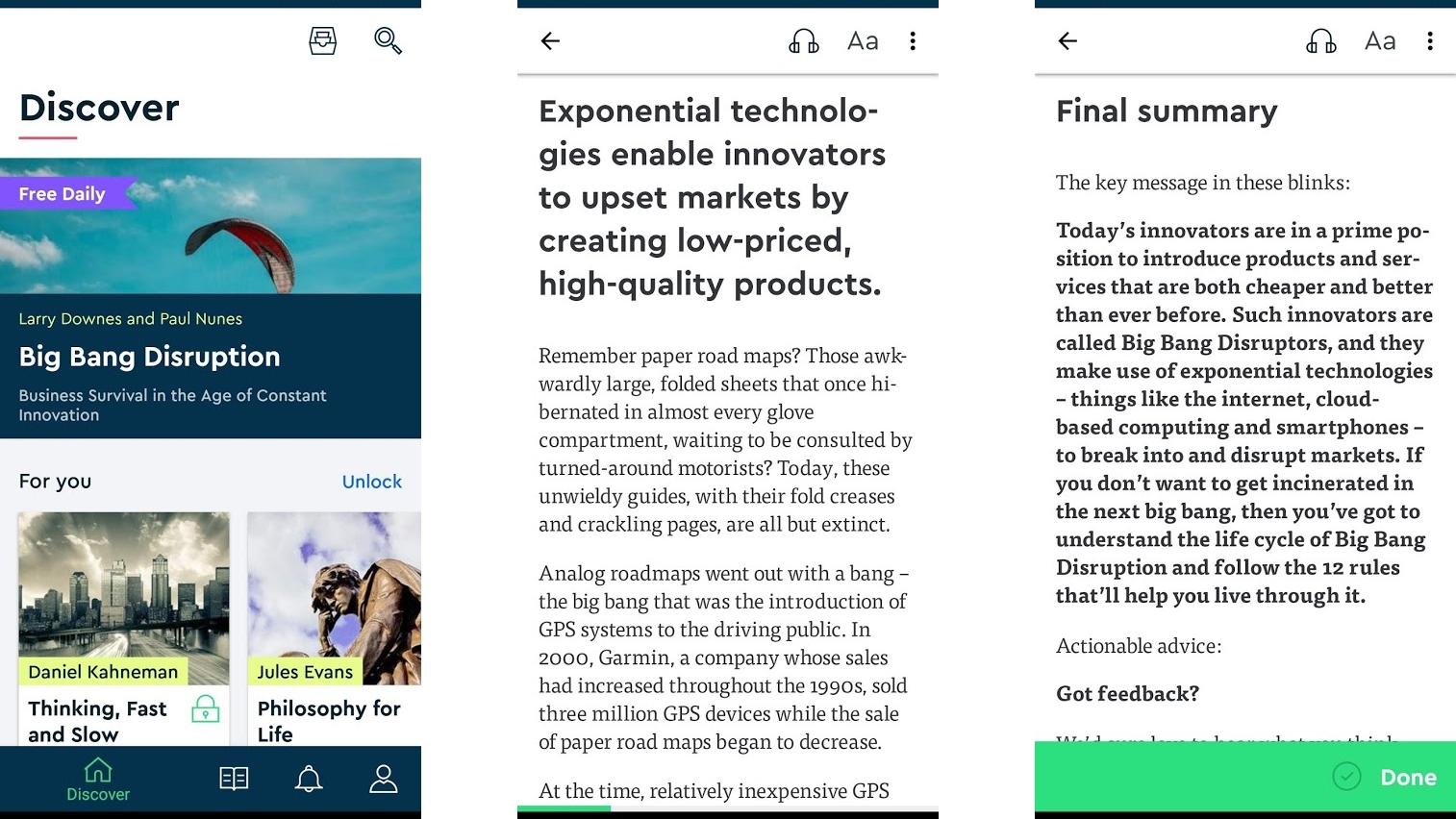
Blinkist
Free + various subscriptions
Few of us have time to read all the books we want to, but Blinkist can give you a fighting chance by distilling the key information in books down into something that only takes around 15 minutes to read.
Obviously, this only works for nonfiction, and you will be missing a lot, but you can genuinely take away many of the core points and messages, so it’s great for books that you’re only semi-interested in and would never read otherwise.
There’s a lot of choice, with over 2,500 books included in the app, though to access most of them you have to pay a monthly subscription (which starts at $6.67/£5 per month if you pay for a year upfront but is $12.99/£13.49 if you pay monthly). This also lets you listen to the distilled versions, so you can consume them even when you can’t or don’t want to read.
If you stick with the free version of Blinkist you get one book per day and the app chooses which one. It’s still well worth having on your phone, but if you get into it then the subscription is probably worthwhile.
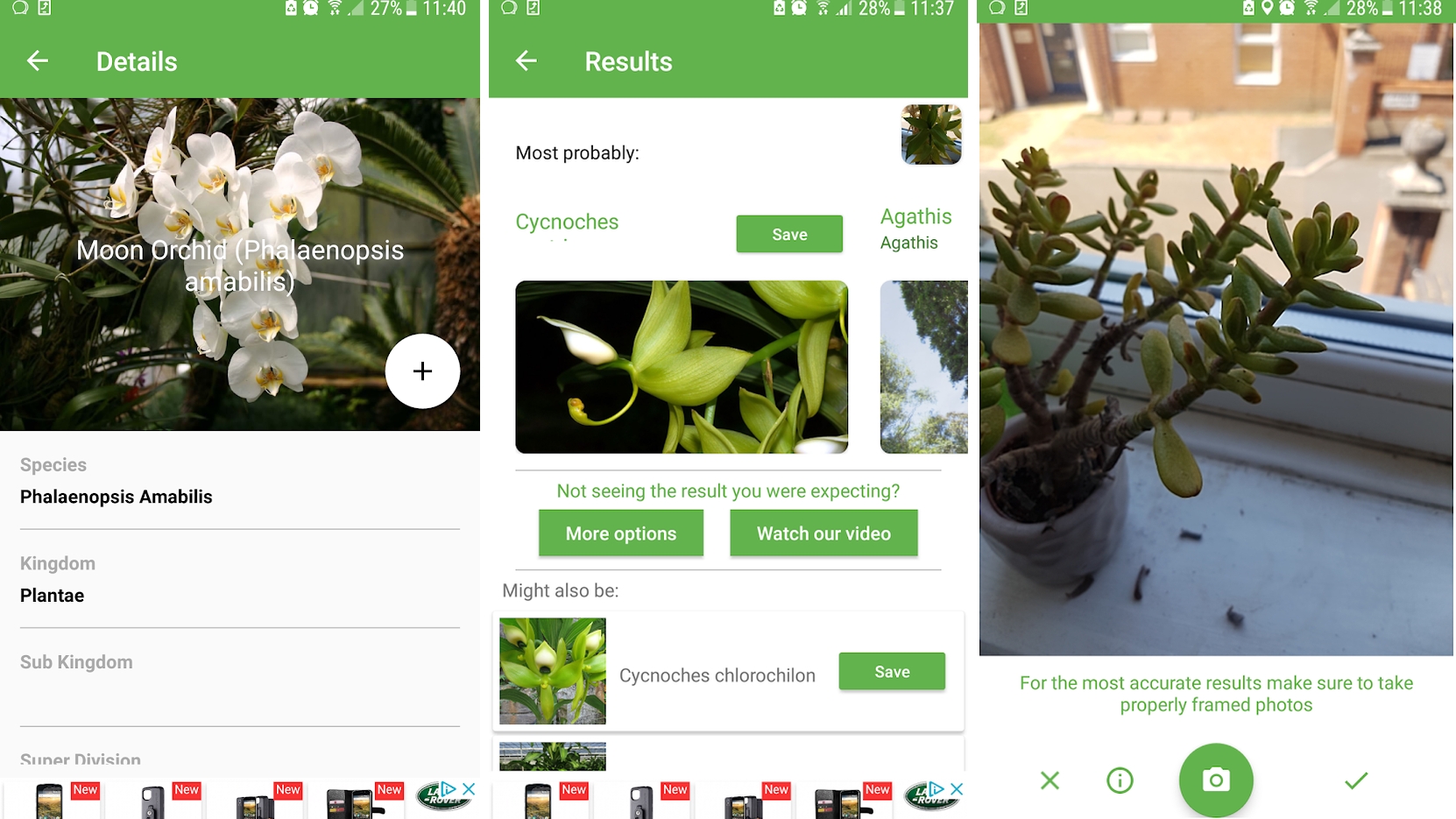
PlantSnap
Free + optional $2.99/£2.69 monthly subscription
PlantSnap is designed to take the mystery out of plants by letting you identify them at the push of a button. Or, more specifically, by taking a photo of them.
The app – which can also recognize flowers, mushrooms and trees – uses AI to tell you what you’re looking at and claims to have a 92% success rate.
It should get better over time too, as its plant database – which already has over 500,000 species – is growing all the time and the app is improving through machine learning.
And as well as identification you can also use PlantSnap to catalog all the plants and flowers you come across in your travels.
If there’s a downside it’s that the app has adverts. These can be removed for a fairly pricey $2.99/£2.69 monthly or $19.99/£17.99 yearly subscription, which might be worthwhile if you use the app a lot.
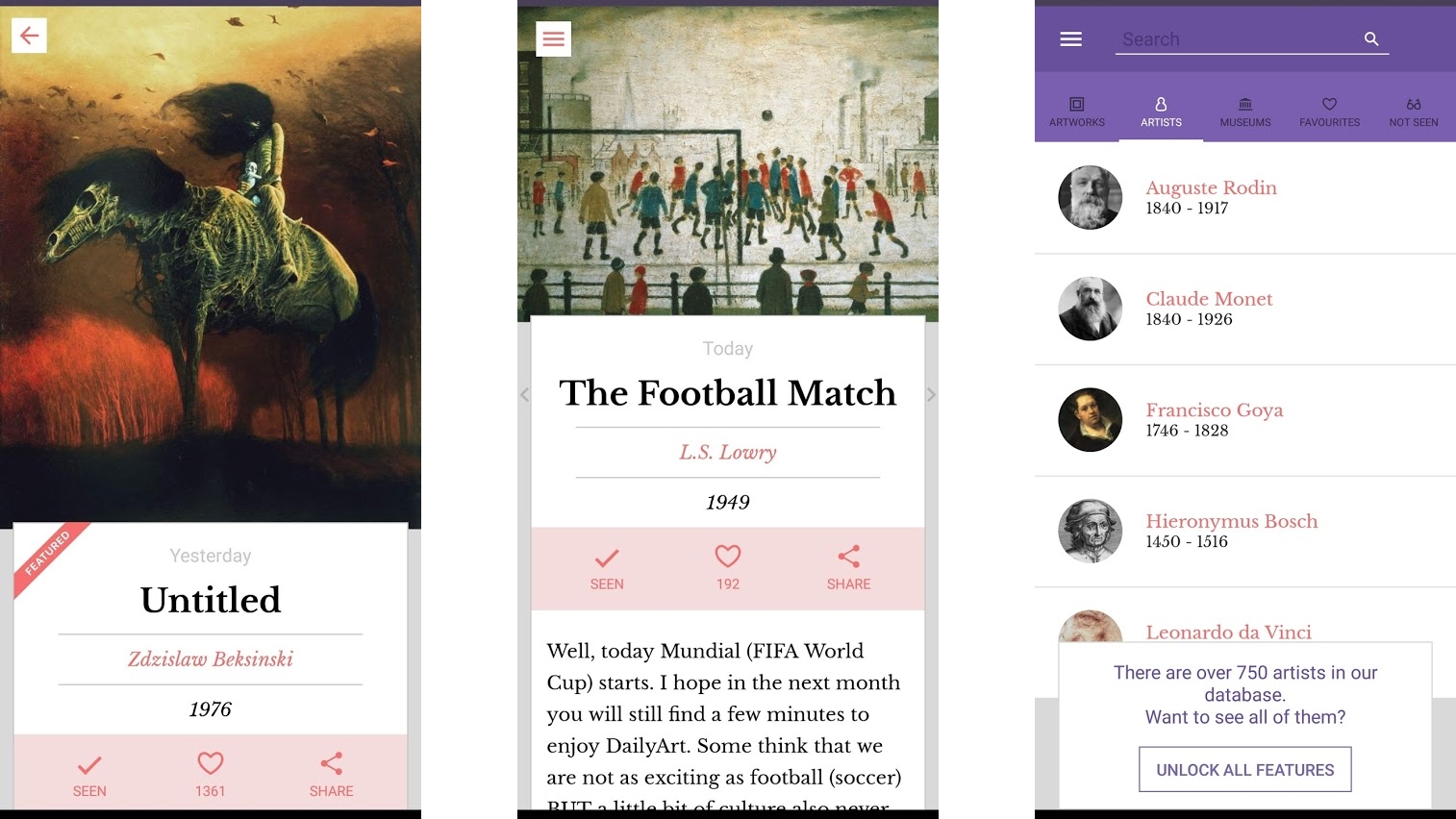
DailyArt
Free + $4.99/£4.69 IAP
DailyArt shows you a new artwork every day – mostly paintings, but sometimes other forms of art such as sculpture too.
It includes classic, modern and contemporary artworks, accompanied by information on the work and artist, so you can see and learn something new every day.
You can also favorite, share and download artworks, get notifications when a new daily one appears, and get information on where you can see each of the works in the flesh.
The core DailyArt app is free, but for a one-time IAP you can unlock access to the entire database, which currently includes around 4,000 artworks from 1,000 artists, so if you want to go beyond one artwork each day you’ll have a whole trove of them to dive into.
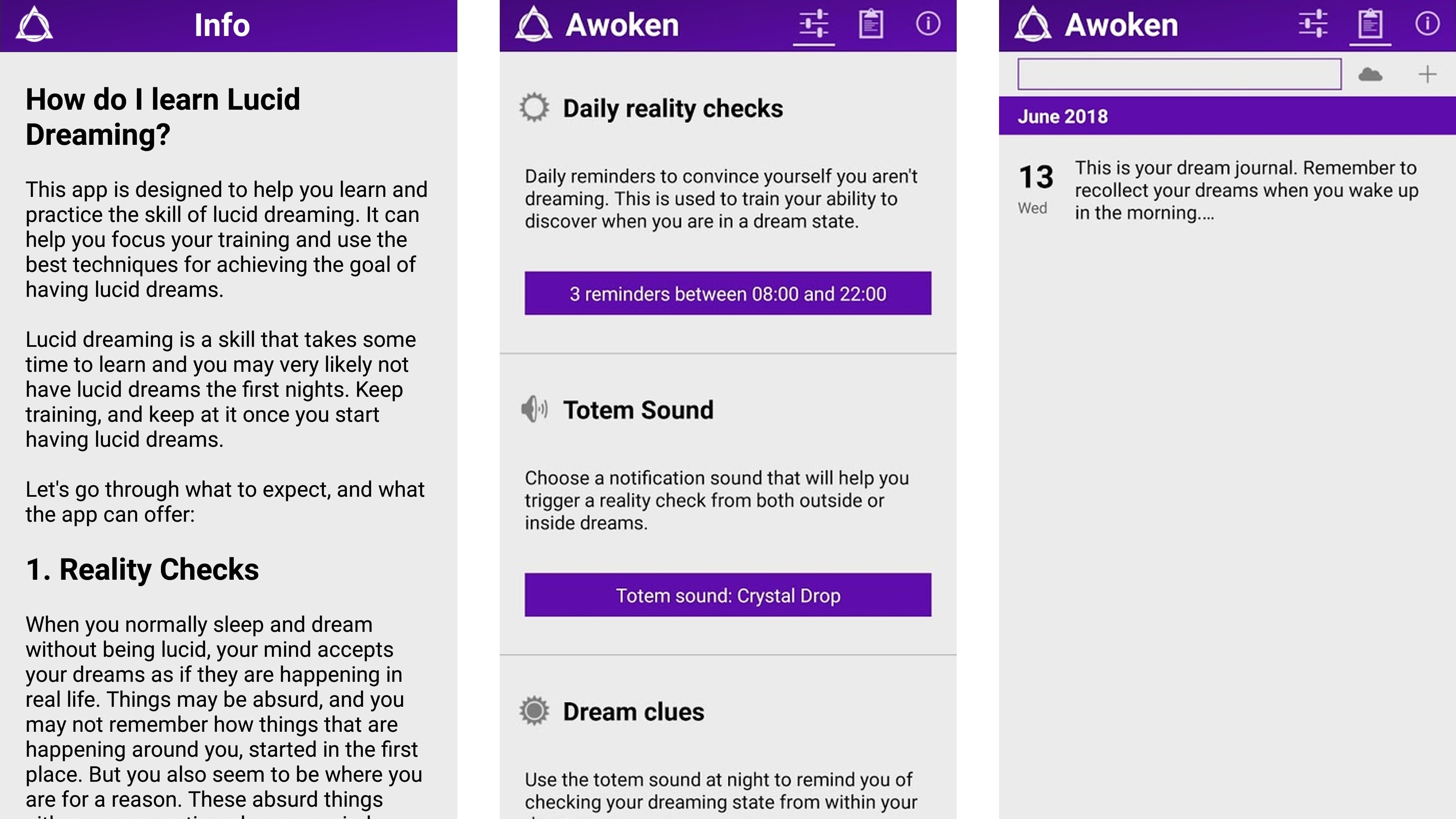
Awoken – Lucid Dreaming Tool
Free + $1.99/£1.99 IAP
Lucid Dreaming means knowing that you’re dreaming, which in turn can allow you to shape and influence your dream. You’ve probably experienced it sometimes, but it’s a skill that you can learn, so that most times when you’re asleep you’ll be in control.
Awoken – Lucid Dreaming Tool helps with this in a variety of ways. For one thing, it lets you set a totem sound, which you can have go off at intervals while you’re awake and/or asleep.
When you’re awake, this sound acts as a prompt to confirm to yourself that you are awake (something which in turn will help you recognize when you’re in a dream state), and when dreaming, it’s used to make you realize you’re asleep.
The app also contains a dream journal, so you can log your dreams, and you can optionally get a reminder to do this first thing in the morning, so you don’t forget them.
Many of the features are free, but to get the most out of Awoken it’s worth buying the one-off IAP, which removes adverts, lets you speak your journal entries, which could be handy if you’re still half asleep, and unlocks a Dream Patterns feature, which gives you a list of the most common words and themes in your journal, making it easier to analyze your dreams.
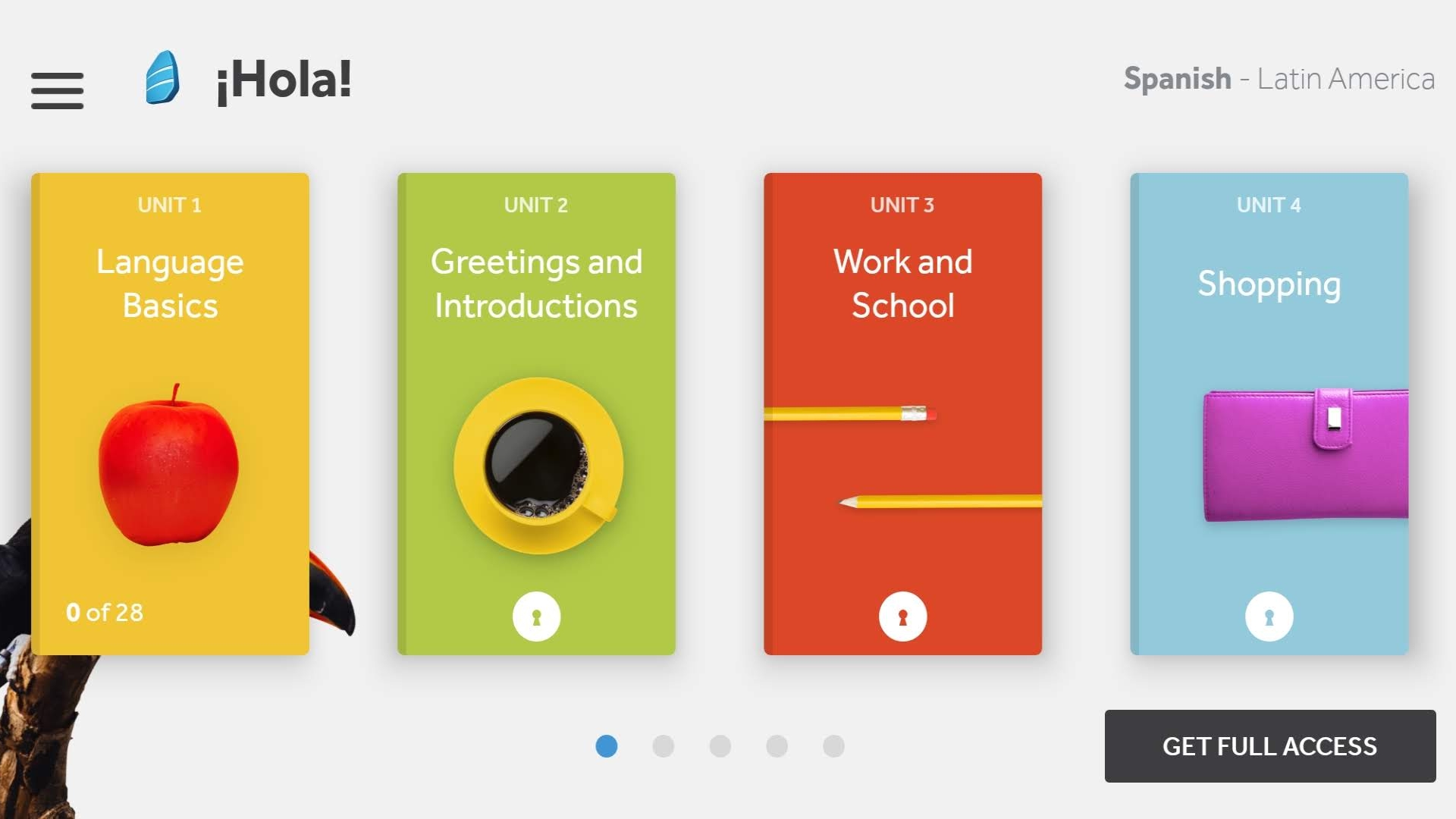
Rosetta Stone
Free + various IAP
Rosetta Stone has been teaching people languages since before smartphones were a thing, and its Android app is one of the best ways to learn.
You can select from 24 different languages, then go through a variety of lessons that combine words and images so you can learn visually. All the phrases are spoken, so you also get to hear the pronunciation.
There are a variety of different lesson types. Some show you several pictures and ask you to tap the one that matches a word or phrase, while some ask you to repeat the word or phrase, then use Rosetta Stone’s speech recognition technology to tell you how close you got.
There are stories that you can read or have read to you in the language you’re learning, and you can download lessons, so you can learn even when there’s no internet connection.
If you’ve ever used something like Duolingo then this app will feel somewhat familiar, but Rosetta Stone seems to put more of a focus on having you speak words aloud.
Unlike Duolingo, most of Rosetta Stone isn’t free, but you can get some basic lessons without paying to begin learning the foundations of a language. Then, if you want to take it further, you can subscribe for anywhere from three months to a year, or buy lifetime access to a language course.
Prices vary depending on what you choose, but this isn’t cheap, costing for example $79/£42.99 for three months of access. Still, it’s potentially more affordable than a real-world course.
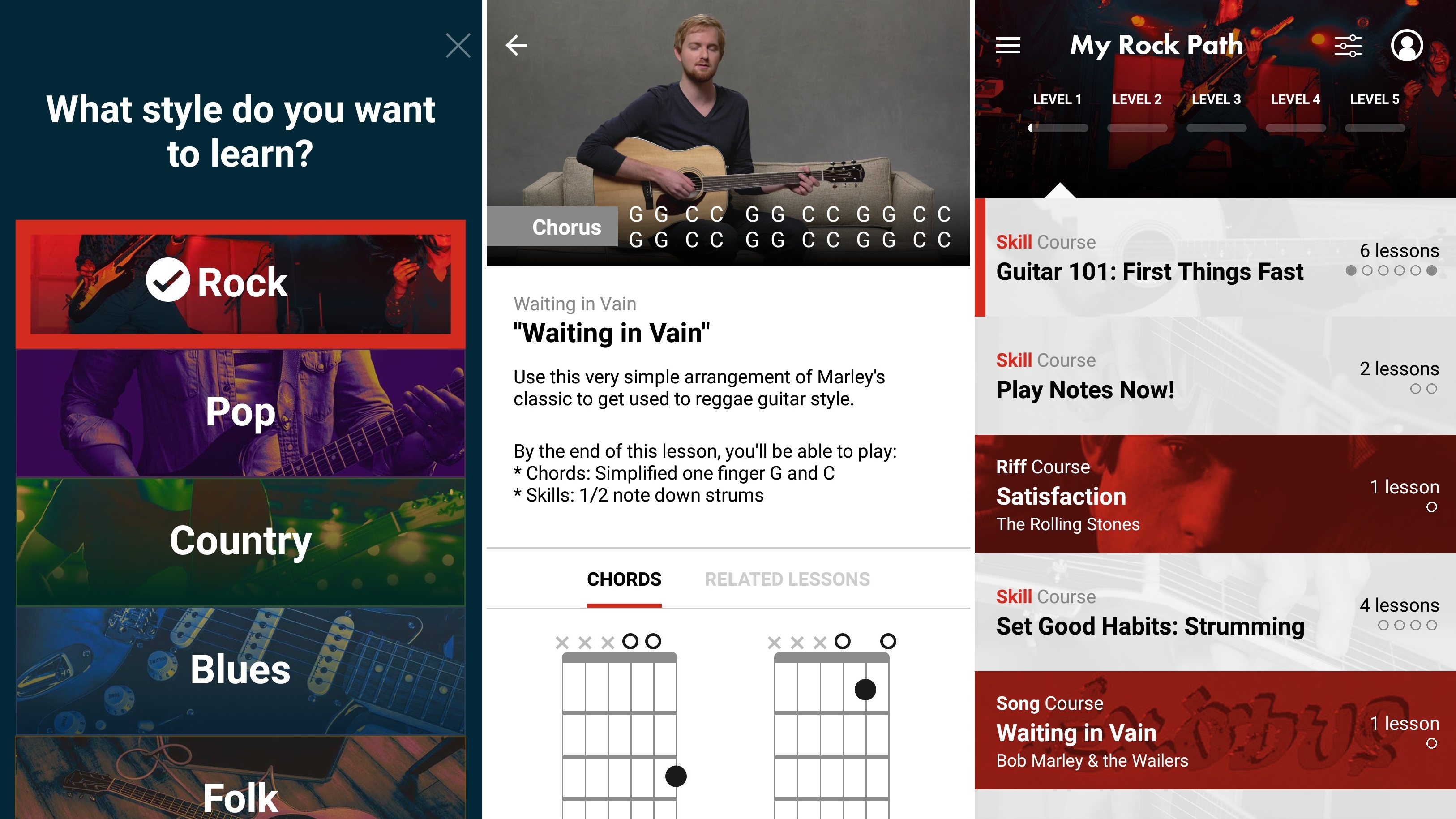
Guitar Lessons by Fender Play
$9.99/£8.99 monthly subscription
While taking guitar lessons is probably advisable if you want to learn, it’s perfectly possible to teach yourself, and Guitar Lessons by Fender Play is probably one of the strongest tools for that.
Starting with the absolute basics, the app lets you choose the style of music you want to focus on and whether you’re playing electric or acoustic guitar, then it takes you through a series of video lessons, teaching you chords, riffs and songs.
Many of the videos are short, so you can learn in bite-sized chunks, and information is often also written out for you below the video.
You can also jump ahead to later lessons if you’re more advanced or just not interested in certain tutorials, and there are hundreds of different songs and lessons in total, so there’s plenty to sink your teeth into.
Guitar Lessons by Fender Play costs US$9.99/£8.99 every month, but that’s still a lot less than you’d spend on a weekly lesson, and you get the first month free.
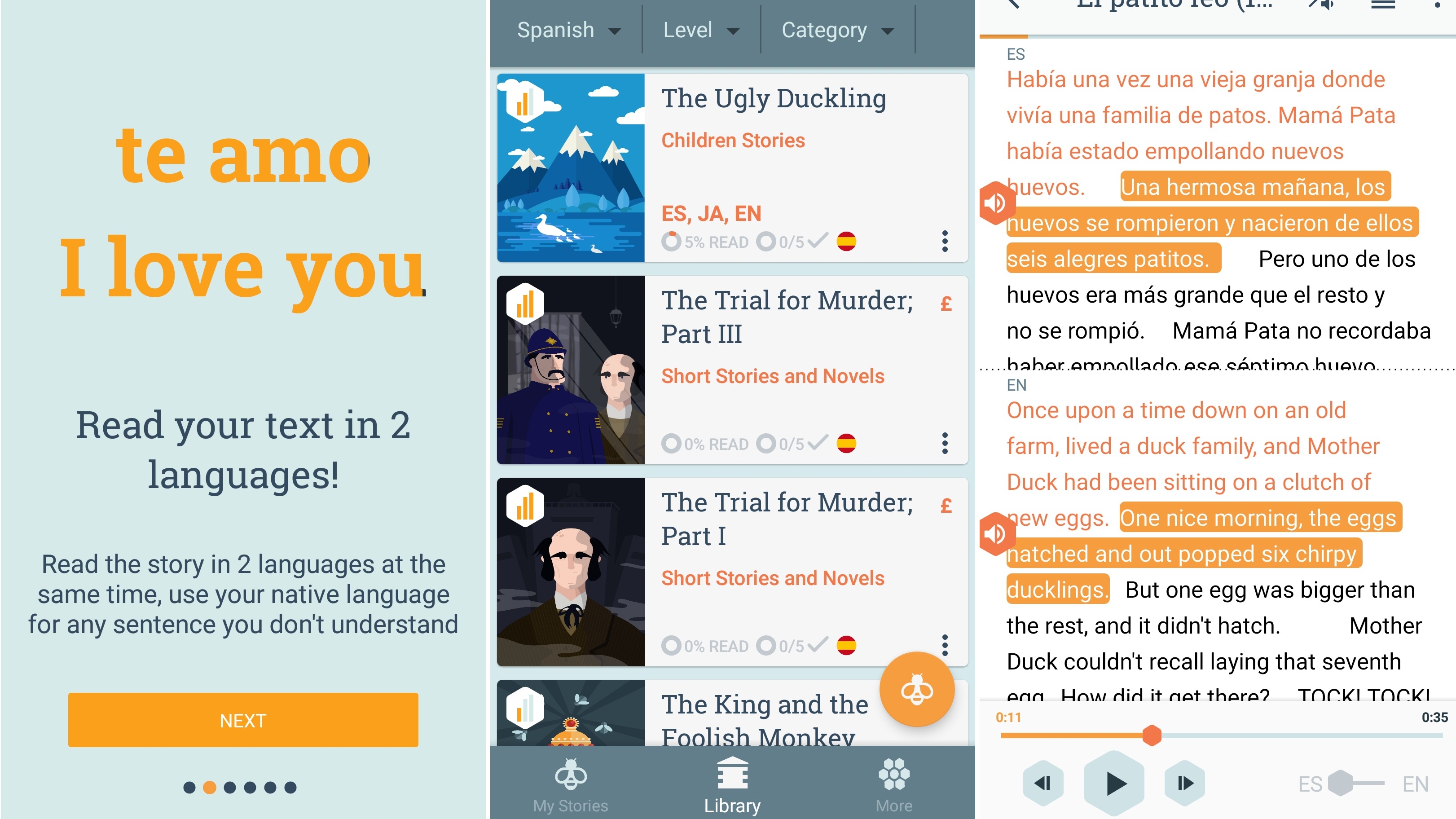
Beelinguapp
Free + various IAP
There are lots of language learning apps on Android, but Beelinguapp takes an approach we haven’t seen before.
The app has a selection of stories, which you can read or have read out to you in German, Spanish, Portuguese, French, Hindi, Korean, Russian, Chinese, Arabic, Italian, Japanese or Turkish, with the option of seeing the text below in English as well.
You’ll always know which part is being read because it’s highlighted in yellow, and you can change the speed of the audio so it’s read at your pace.
The stories include children’s stories, novels and short stories across various genres, so there’s a wide selection, though most of them either need to be purchased (with prices starting at US$0.99/£0.89) or obtained as part of a subscription, which unlocks everything at a price of £3.09 (around US$4.35) per month.
It’s worth noting that even the simplest stories are probably too advanced if you’re brand new to a language, so Beelinguapp isn’t the place to start on your language learning journey, but if you’ve already got some of the basics down it could be a fun way to strengthen them.
Our favorite Android apps for having fun on your phone or tablet, through watching videos, reading, socializing and more.
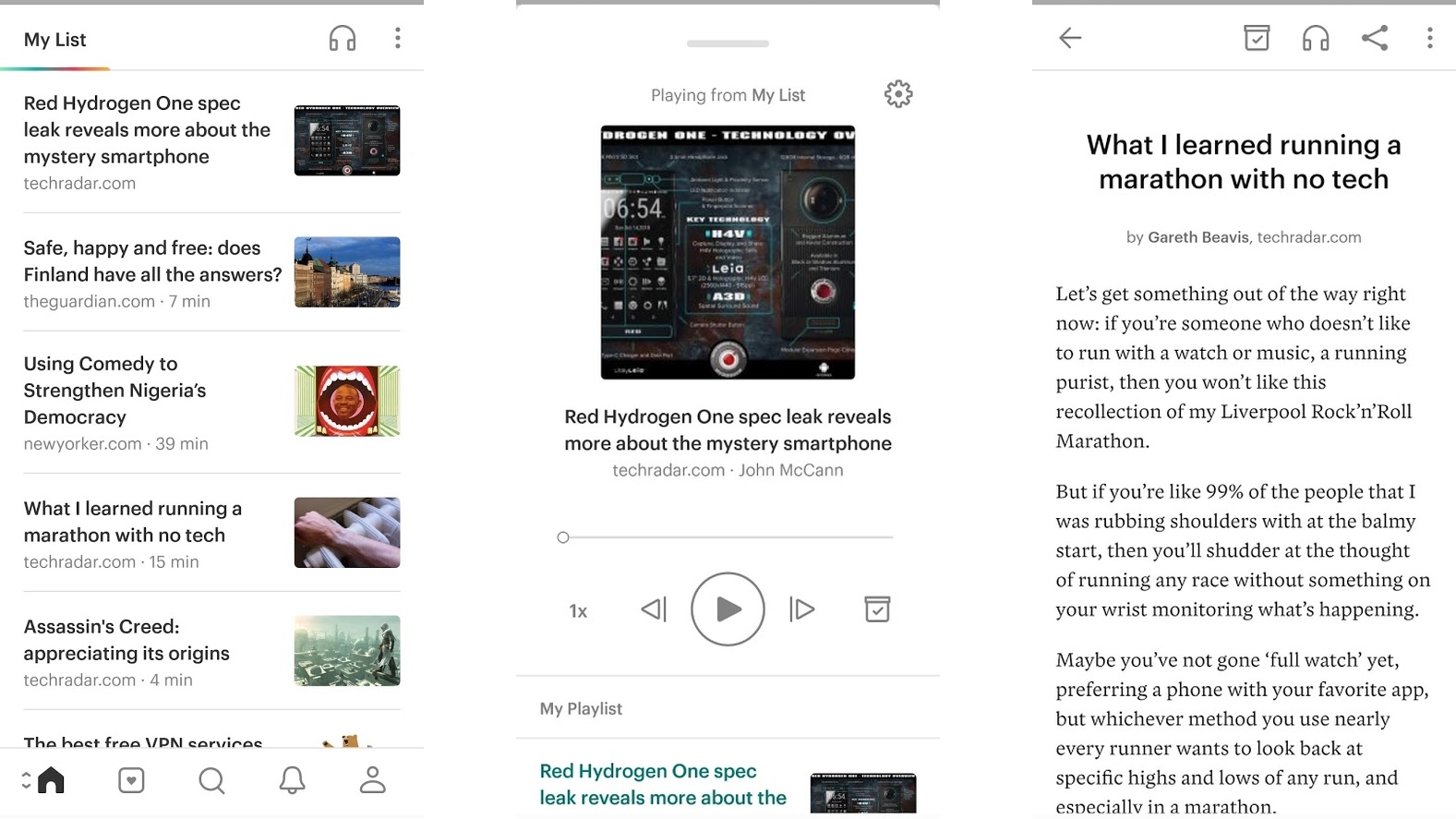
Free + $4.99/£4.49 monthly subscription
Pocket isn’t a new app, but it does have some new features and a new look.
For those who don’t already know, Pocket is an app that lets you save articles so that you can read them later. That both means you can read them offline and allows you to keep a list of content you plan to read so you won’t forget about it. And as Pocket works on a variety of devices, including Android and iOS phones and tablets as well as PCs, you can read what you’ve saved anywhere.
Thanks to a recent update you can also now listen to saved articles, with Pocket reading them out to you, so you can devour them even when you’re busy doing something else. The company is also planning to add Alexa integration, meaning you’ll be able to listen to articles through any device that has Alexa built in.
And the interface now has multiple themes, as well as a general overhaul designed to make reading for long periods more comfortable.
It’s good stuff, and it’s mostly free, but subscribing to Pocket Premium for $4.99/£4.49 per month gets rid of adverts, unlocks a powerful search tool, and ensures your saved articles won’t be lost even if they’re taken off the web.

Google Home
Free
One of the problems with smart homes today is that your devices are typically made by a variety of different companies and, as such, they’re all managed by different apps. It’s a messy and not particularly smart situation, but an update to Google Home aims to address that.
The app now lets you manage most smart devices from within it, whether they’re made by Google or not. Thousands of devices from hundreds of brands are supported; it’s just a case of finding yours and logging into them from the Google Home app, thereby giving it permission to manage them. You can then create groups of smart devices based on what room they’re in and manage everything from lights to thermostats to coffee makers all in one place.
Some devices still aren’t supported, and you don’t always have full control – for example, we can turn our LIFX lights on and off and adjust the brightness from Google Home, but can’t change the colors.
Still, for basic interactions with most of your smart devices, Google Home is a slick, streamlined option.
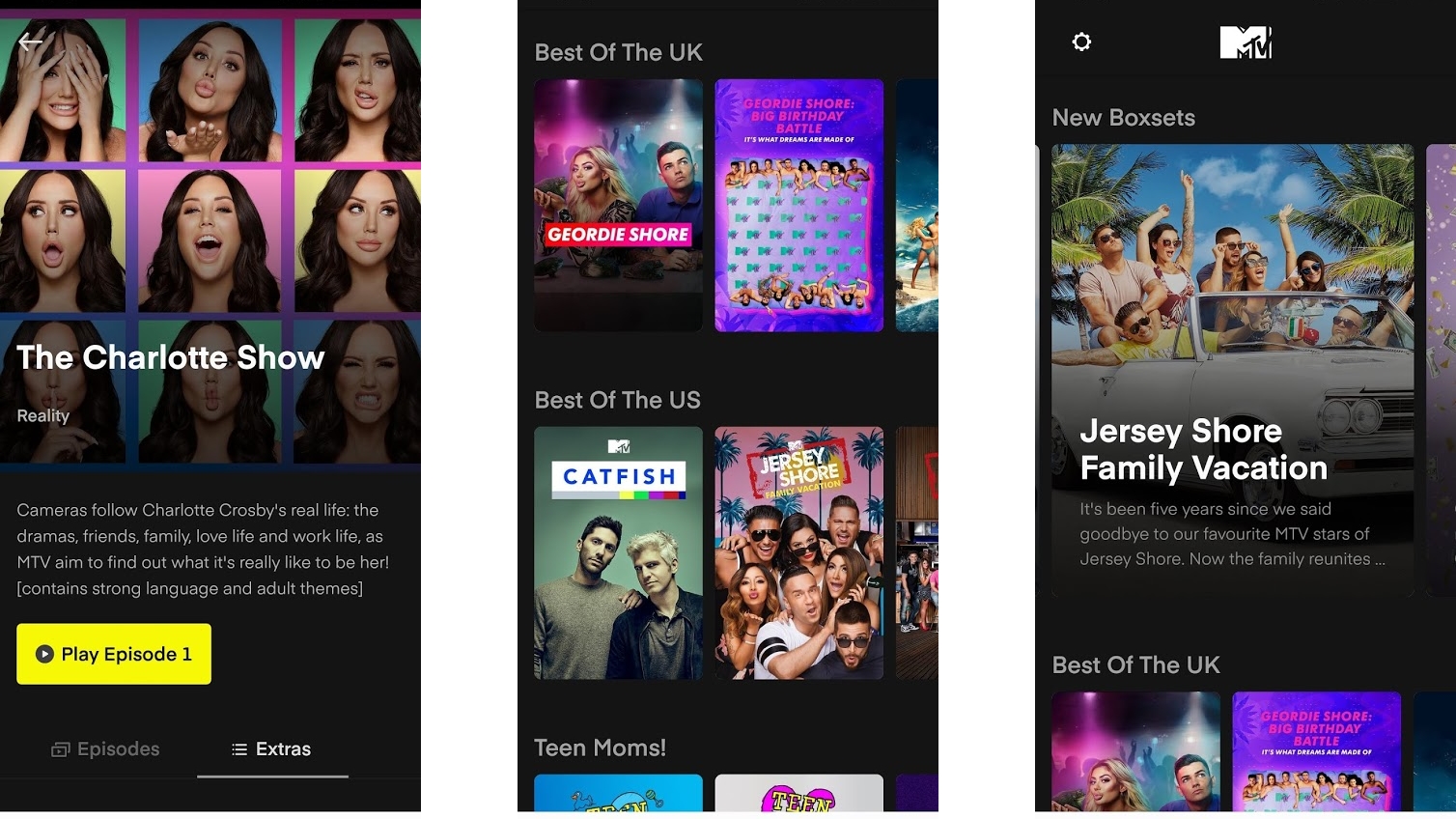
MTV Play UK
£3.99 per month
If you’re in the US you could have been enjoying MTV content on your Android phone or tablet for years, but the app has only just come to the UK.
For £3.99 per month (following a free seven-day trial) you get access to box sets of a variety of MTV shows, such as Geordie Shore and Ex on the Beach, plus the ability to catch up on the latest episodes, and new content added all the time.
There are also extras, such as behind the scenes footage, and there’s a daily MTV news bulletin providing news focused on the entertainment industry.
As streaming apps go MTV Play UK is pretty basic – there’s no Chromecast support currently for example, or the option to download content, but if you like MTV and don’t like being a slave to TV schedules then it’s still a near essential app.

Mubi Go
£7.99 per month
You might have come across Mubi before – it’s a streaming film service that gives subscribers access to a new film every day, with a focus on independent and world films. Mubi Go is essentially that for the cinema.
The service selects one new cinema release each week and gives you a free ticket to it. Or rather, it gives you a QR code that can be scanned at select cinemas in exchange for a ticket.
There seems anecdotally to be quite a good range of cinemas, including big chains like Vue, though Mubi Go tends to select quite niche films which don’t have a wide release, so if you’re not in a big city your mileage may vary.
The service is included with a standard Mubi subscription, so if you’re already subscribed to that you can download the Mubi Go app and have instant access.
However, while Mubi itself is available in both the US and UK, Mubi Go is currently only a UK service. We wouldn’t be surprised if that changes one day, but in the meantime US users always have the superficially similar MoviePass.
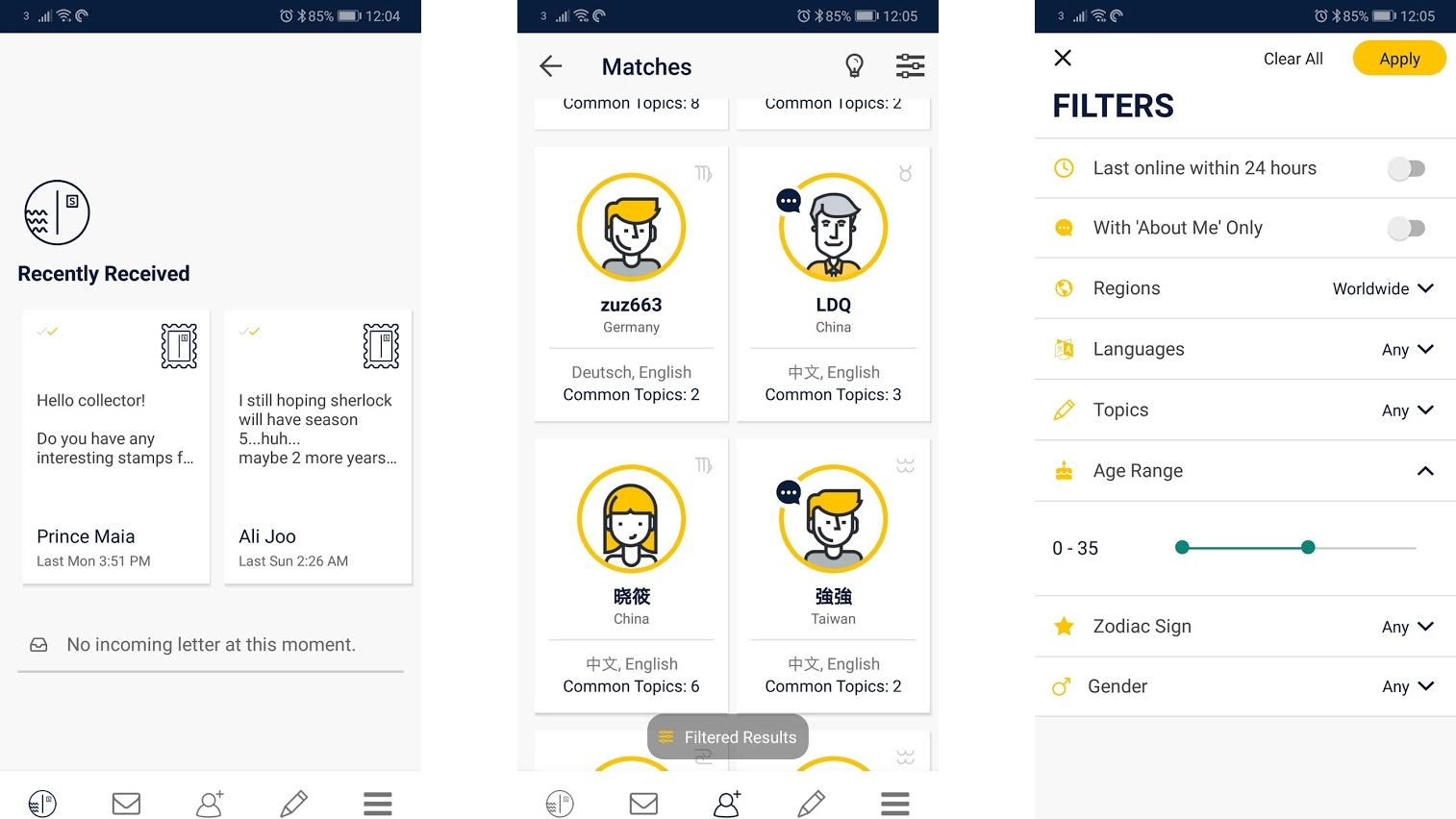
Slowly
Free
Nowadays communication is instant, but it wasn’t always like that. In the past if you wanted to write to someone you had to send a letter, waiting days for the other person to receive it and days more for a reply – or even longer if they were on the other side of the world.
Despite the convenience of instant communication, there is something to be said for that wait. It can make individual messages feel more important and even make them exciting to receive.
Slowly aims to recapture some of that by making you wait for messages to be received, and your distance from the person you’re contacting affects how long you have to wait.
You can pick a nickname, an avatar and topics that’s you’re interested in, then start sending messages to people all over the world, either by filtering (based on metrics such as age, gender, language and interests) or completely at random. If you’re lucky, maybe they’ll write back, but you’ll have to wait a while.
It would be easy to write Slowly off as a gimmick, but it’s a genuinely nice way to communicate, meet new people and have real pen pals, rather than those you can reach at a moment’s notice.

Compass News
Free + $0.99/£0.99 monthly subscription
Compass News is a slick, speedy way to get to the heart of the day’s most important news stories. The main screen contains a list of the biggest headlines of the day and tapping on them provides a brief summary of the story, no more than a few paragraphs long.
For free, that’s all you really get, but take out a subscription and you can access another feed that has more stories – though still only reports judged to be the biggest and most important. Here, each contains an even shorter 30-second summary, along with a separate tab providing background and context, which again is done in a few short paragraphs.
If you want the full story you can tap on it to be taken to its host site and read it in full - these sites are major sources such as The Guardian and The New York Times. There are over 25 different publishers in total, all of which are judged to be among the best and most trusted, so there’s no risk of fake news. The sources also encompass both the left and right of the political spectrum, to provide a more rounded look at the news.
You can favorite stories in order to access them offline, and browse topics if you’re only interested in certain news sections, but that’s all the app offers. It’s light on options by design, keeping things simple so catching up with the news doesn’t become a chore.
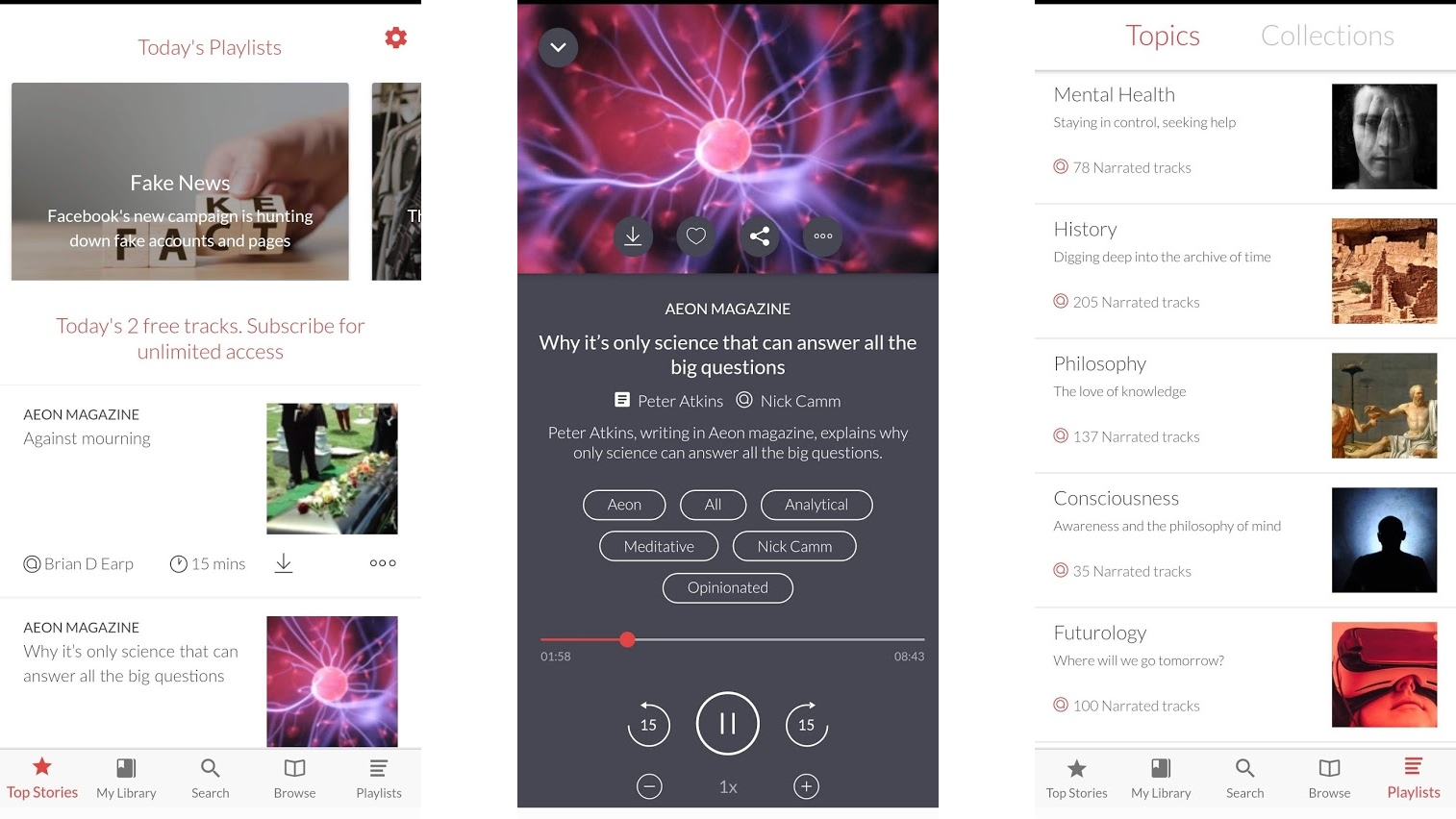
Curio
Free + $7.99/£5.99 monthly subscription
There are so many interesting articles around, with new ones being published every day, and while many can be found for free online the big problem can be finding the time to read them all, which is where Curio comes in. Rather than reading the articles yourself, with Curio you can have them read to you.
That means you can absorb them while doing other things, like walking, driving or exercising, and we’re not talking about some robotic synthesized voice here. All the articles are read by real people (professional voice actors at that), so they’re actually enjoyable to listen to.
There are over 2,000 articles available across a range of subjects and from a variety of sources, including The Guardian, The Financial Times, Salon, Aeon and many more.
You can filter articles based on publication, their length, or their ‘vibe’, and there are various playlists too, grouping similar articles together, so there are lots of ways to find new things to listen to.
There are also handy tools like the ability to download articles, so you can listen to them offline, or load the article in text form so you can read along to it.
All of this doesn’t come free though. You can listen to two articles (chosen by the Curio team) each day without being charged, but for unlimited listening you need to subscribe at a cost of $7.99/£5.99 per month (with discounts available if you commit to a year).
It’s not cheap, but we’d say it’s well worth it if you ever find yourself wishing you had more time to read articles, or just prefer having them read out to you.
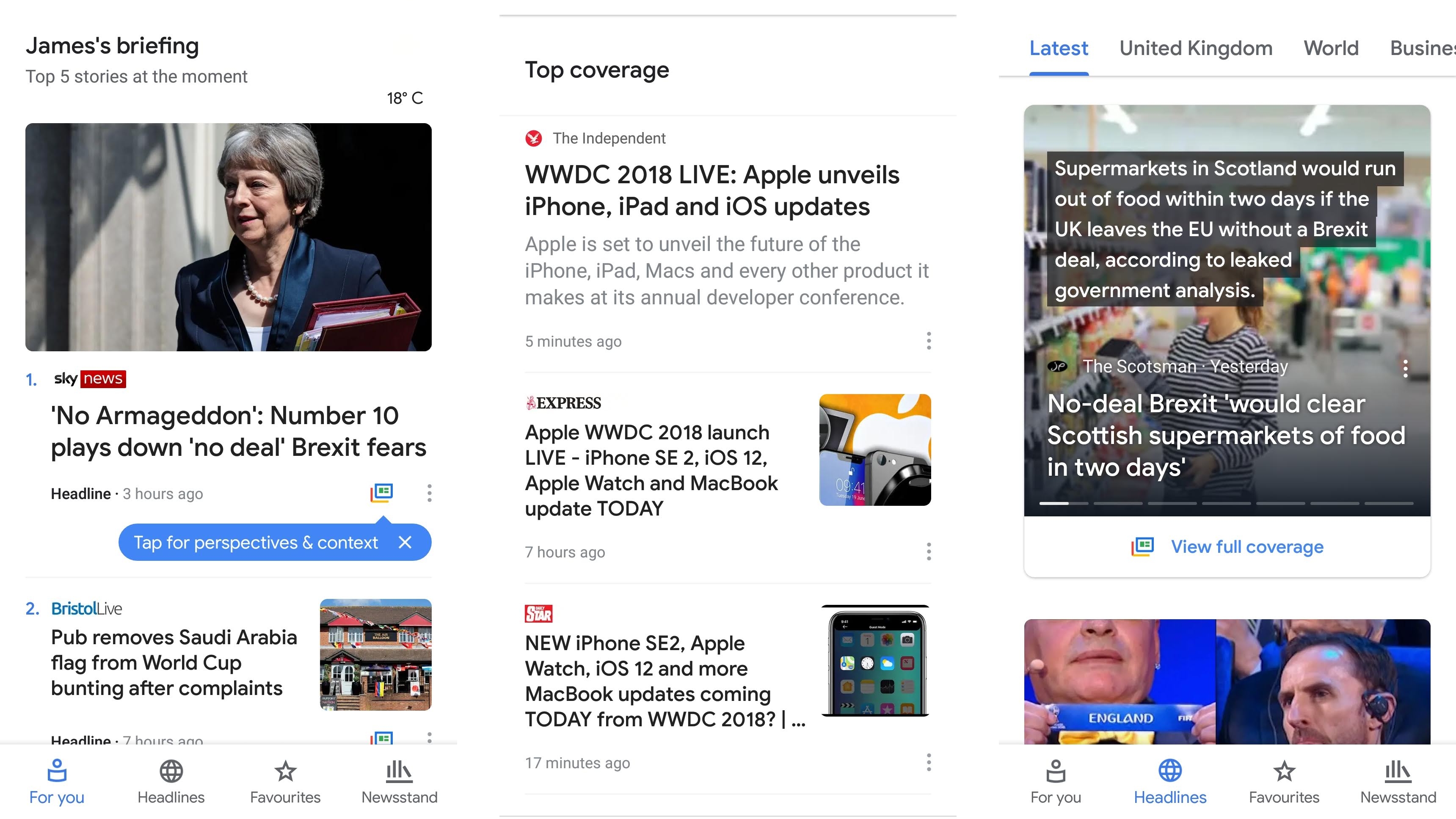
Google News
Free
Whether we like to admit it or not, most of us are probably stuck in a bit of a bubble when it comes to the news we hear. Our preferred sources will fit our own political stance and most of our friends will have similar beliefs, which means we only really hear things from one perspective, but Google News could help give you a wider view of each story.
That’s because, while its home screen will deliver headlines from sources you probably like, you can also tap a button to see wider reporting on each story, with various different news sources and perspectives accounted for.
Beyond that, Google News is a fairly standard but well-designed news feed. You can tell it which newspapers, websites and topics most interest you and from that it will deliver what it thinks are the top five stories that you’re likely to be interested in.
These change throughout the day, and to go beyond those five all you need to do is scroll down the main page, or switch to the ‘headlines’ tab (which lets you further drill down by subject).
You can also subscribe to paid news sources from Google News with a single tap, save your favorite sources and stories to easily return to later, and share stories with friends.
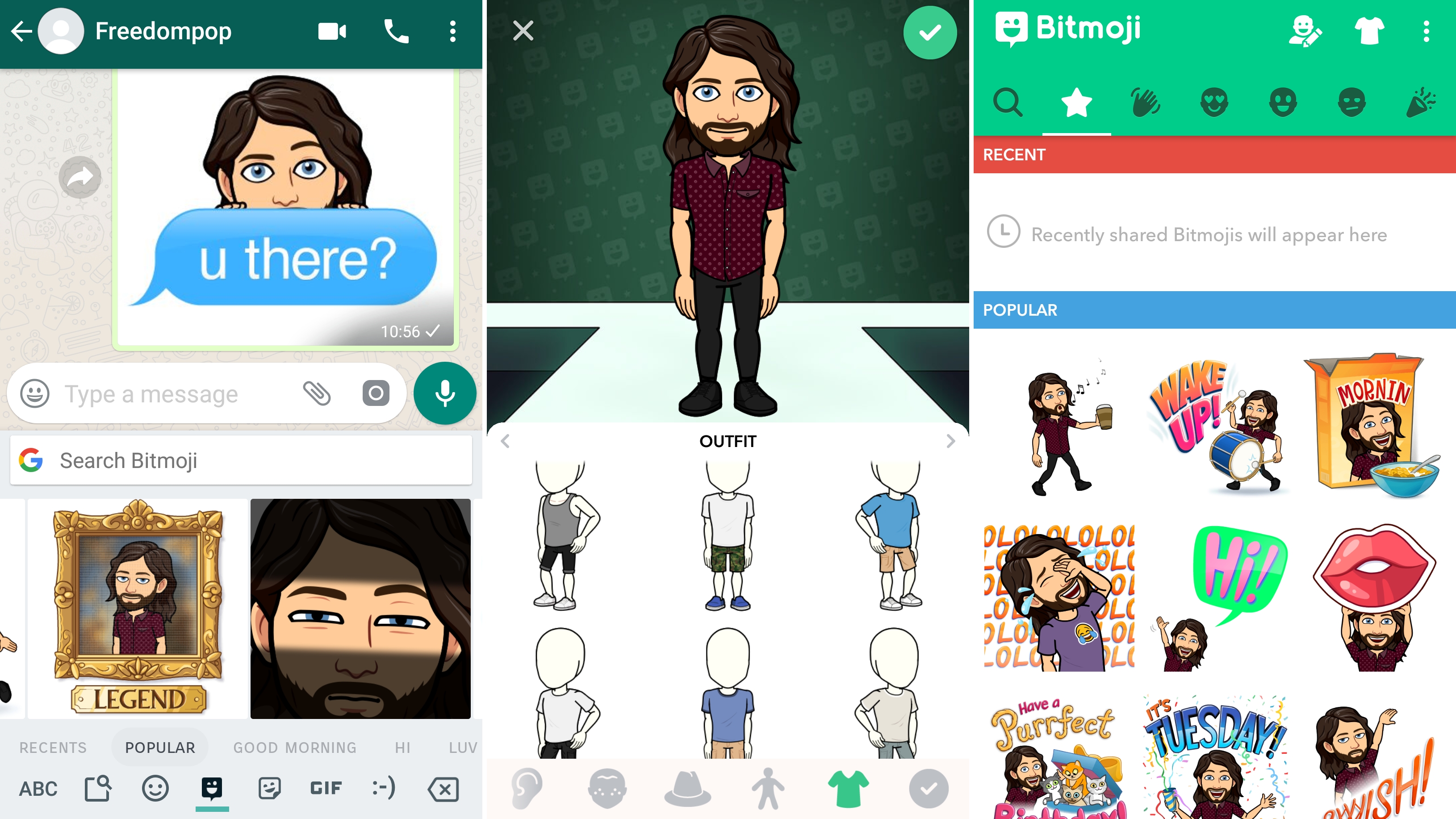
Bitmoji
Free
Even if you don’t have Bitmoji, chances are you’ve come across other people using it. It’s an app that lets you create your own avatar that looks like a cartoon version of you, then use it to share stickers that star you.
These can be used in various chat apps, and if you’re using Gboard you can even share them direct from your keyboard.
There are loads of settings you can tweak when creating your Bitmoji, including hairstyle and color, nose shape, outfit and plenty more, so you really can make it look a lot like you.
There’s also a huge number of stickers, so you should be able to find one that works when words won’t do.
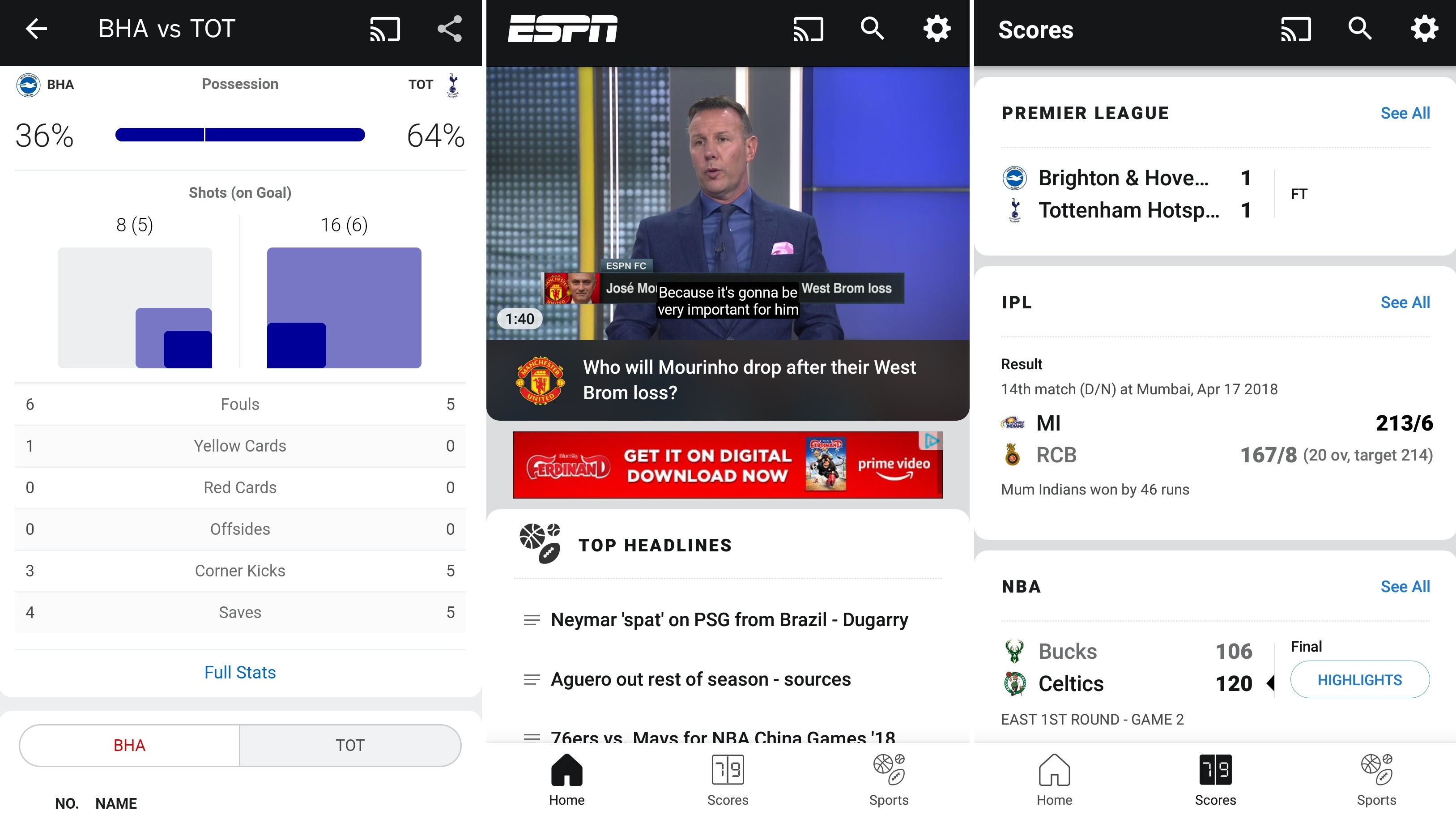
ESPN
Free
Looking for a slick way to keep up with the latest happenings across all your favorite sports? ESPN could be the answer.
The app lets you pick your favorite sports and teams across F1, NBA, NFL, FIFA, golf, tennis, MLB and many more, then see the latest scores and other news about them at a glance.
The home screen provides headlines (which you can tap on for a full news story) as well as videos of the latest news, while a scores tab shows the latest scores from the latest events, and a sports tab lets you drill down into specific sports.
You can cast video content to a big screen using Chromecast, and you can see stats beyond just scores, such as past results from players and teams and sport-specific stats, such as assists, steals and rebounds in basketball games.
You can also get notifications sent for score updates and breaking news about your favorite teams and leagues, so you’ll never miss a moment of the action.

Facebook Lite
Free
Facebook Lite was originally designed for parts of the world where mobile internet is often slow and data allowances low, but it’s now hit the US, UK and elsewhere, and is well worth considering even in these parts of the world.
That’s because the nature of its light design means it’s less of a battery drain than the main Facebook app, which is a big deal because Facebook’s normal app has long been one of the most power-hungry apps around.
It also loads faster and works even over 2G, so if you are in a place with limited signal you can keep on using Facebook. And it takes up less space on your phone than the full-fat app.
There are some downsides – Facebook Lite lacks some features and its interface is far less attractive – but it’s still worth having, even if you only use it when there’s not enough signal to get the normal app working.
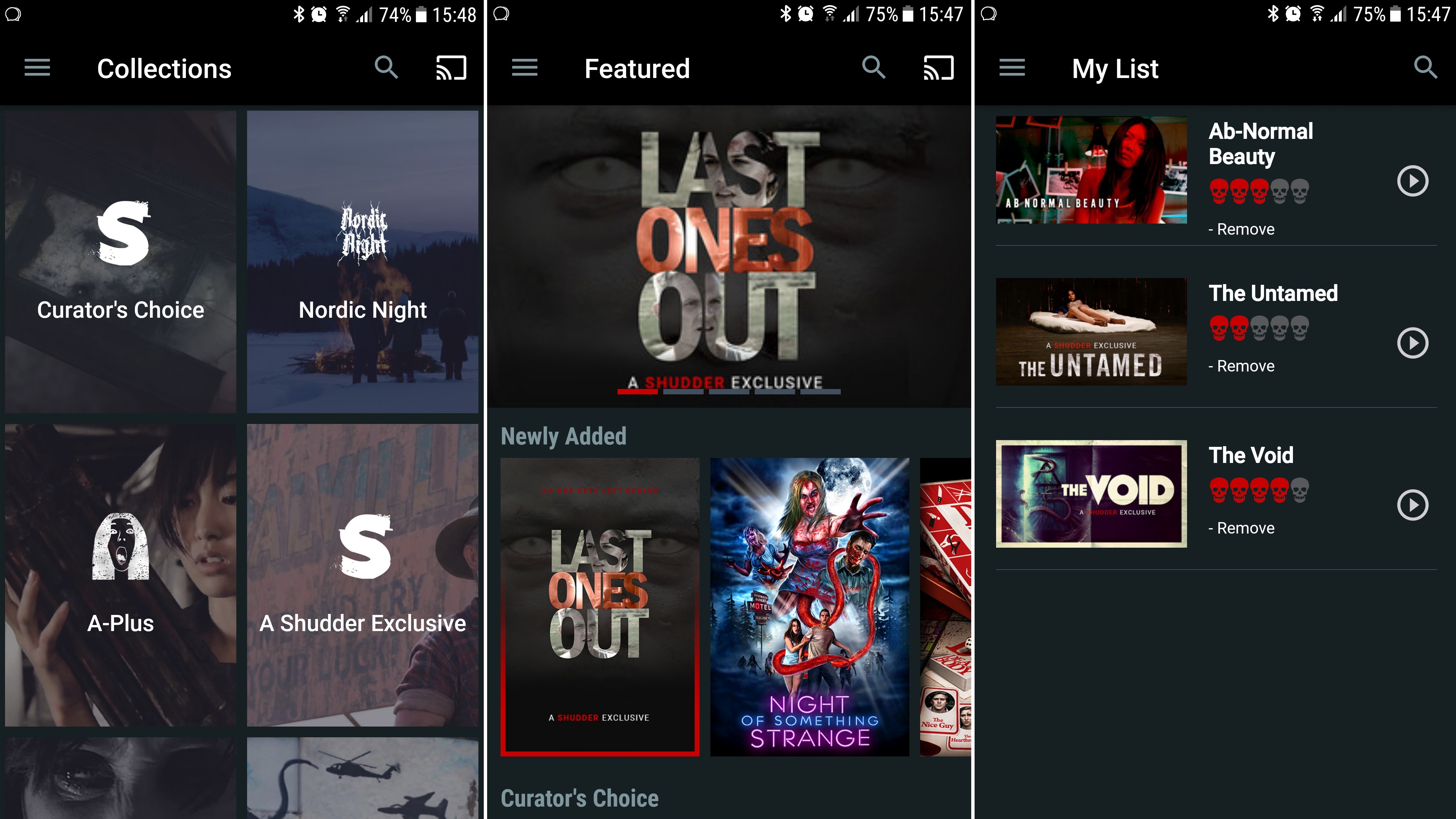
Shudder
$4.99/£4.99 per month
If you’re a big horror fan there’s a better place for you than Netflix, and it’s called Shudder. It’s a similar service, offering a range of streaming movies and shows for a monthly subscription, but all of them broadly fit into the horror genre.
As such the selection is both smaller and less diverse than most streaming services, but its horror catalog is hard to top and new content is added regularly, including recent releases and exclusives which you can’t stream anywhere else.
Shudder supports Chromecast, so you can view things on a bigger screen than your phone or tablet, and it also works with iOS devices and computers so you can get your horror fix on almost any device.
You can also create a watchlist, so you’ll never lose track of what you want to see, and review and rate things you’ve already watched – as well as reading other user reviews.
The only major missing feature is the ability to download content to view offline, but as long as you have an internet connection Shudder is hard to beat for horror.
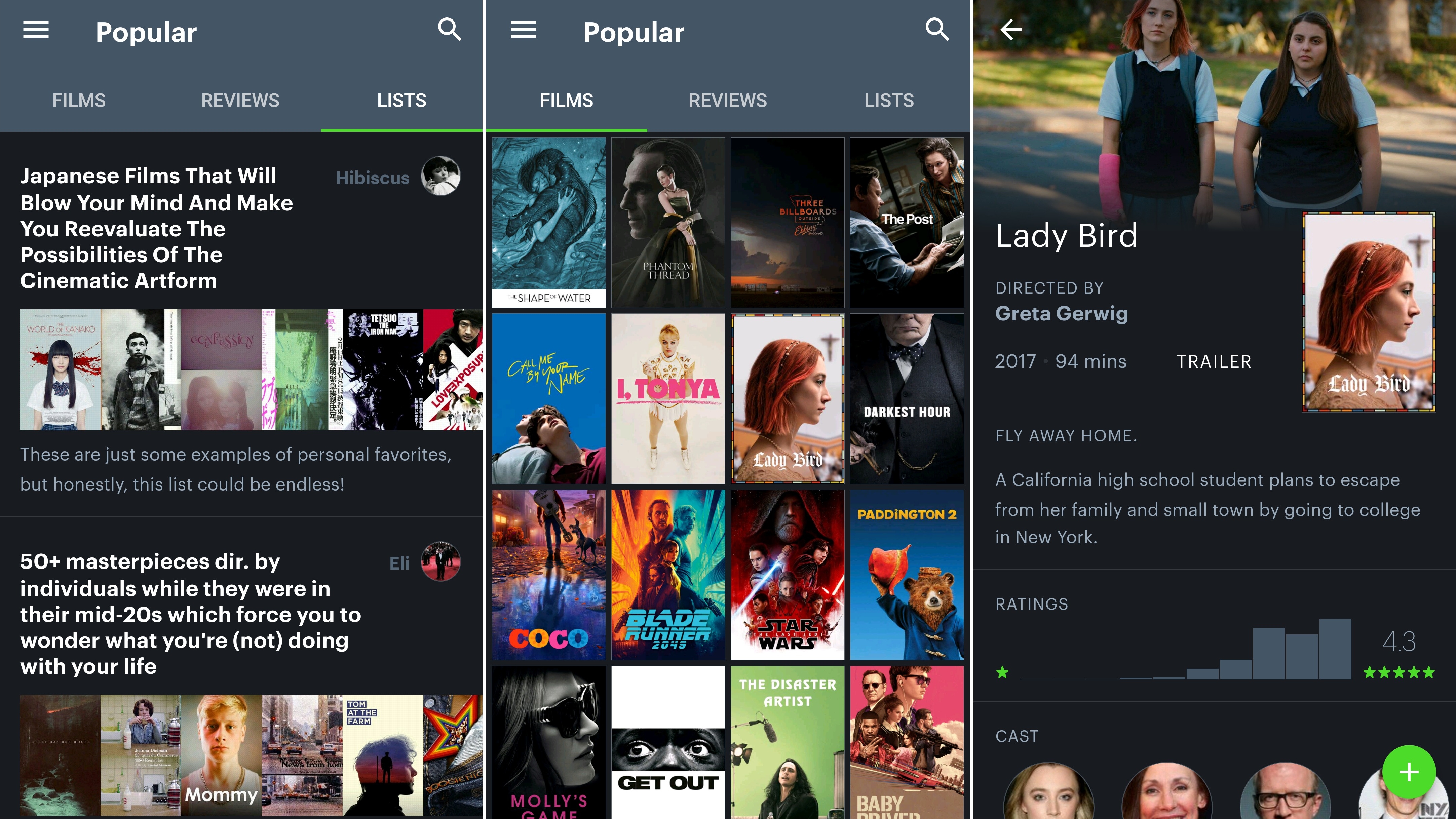
Letterboxd
Free
Letterboxd bills itself as a social network for film lovers and that’s about right, but its focus is primarily on tracking what you’ve seen, planning what you want to see, and discovering films you didn’t even know about.
That discovery part comes mostly through themed lists created by other users, with titles such as 'Japanese films that will blow your mind' and 'When you’re feeling a little lost'.
You can read reviews of films from other users and follow people to receive updates on their activity in Letterboxd. The app also invites you to write your own reviews and create your own collections, as well as building up a list of films you’ve watched, ones you like and ones you want to watch.
Each movie has its own page, complete with user reviews and ratings, a description, often a trailer, and list of a cast and crew that you can tap through to find out more about people and what they’ve done.
All of this is very nicely laid out, with lots of images, and Letterboxd is accessible from the web and iOS devices as well as Android.
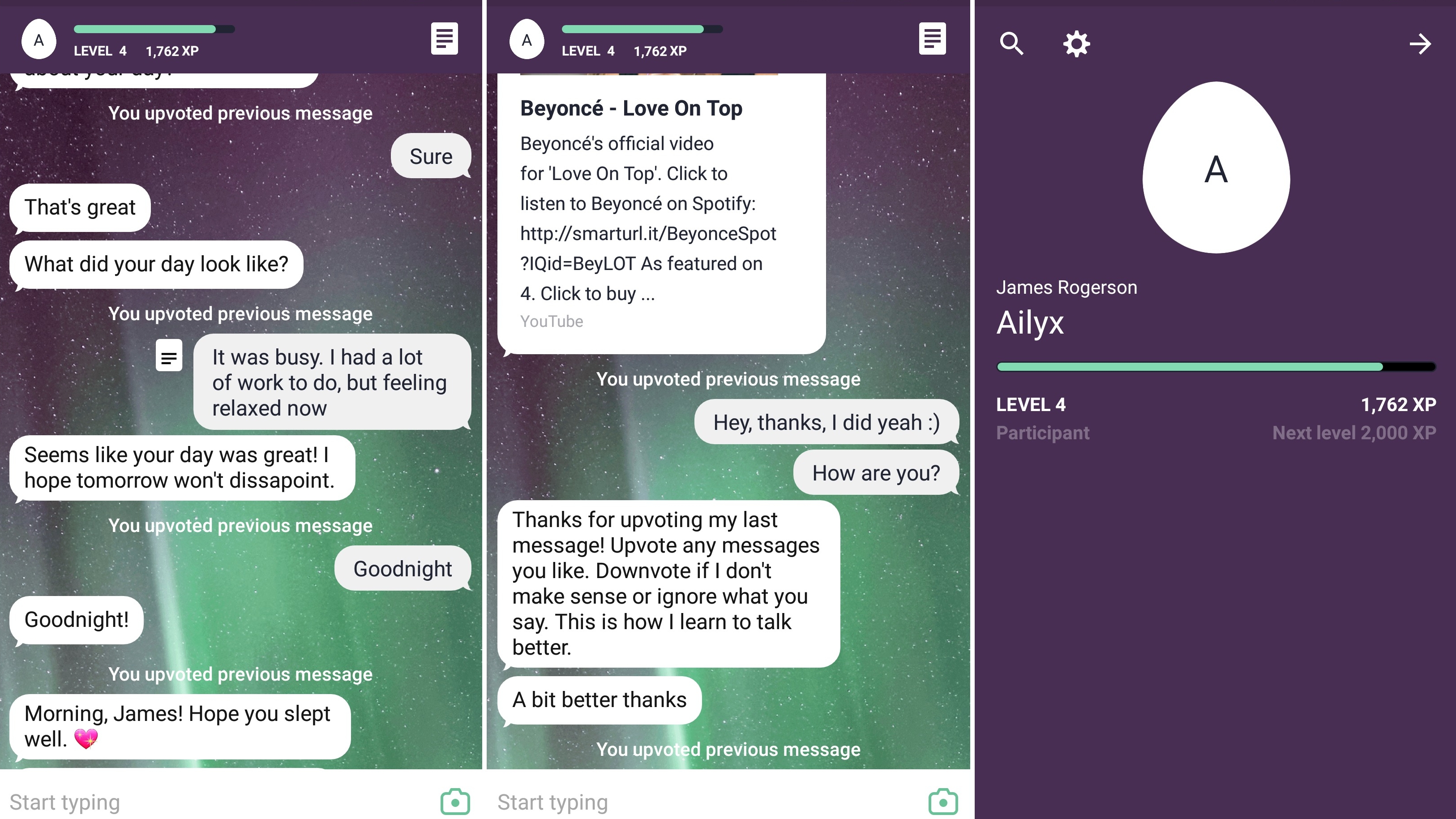
Replika
Free
Replika is an AI chatbot, but it’s more interesting, and more advanced, than most that we’ve come across.
Beginning as little more than a blank slate, your Replika will learn and grow based on your interactions with it, becoming a bit more like you in the process.
But it will also ask a lot of questions about you, and cause you to reflect on your day and your life. Your responses to these questions are saved and sorted by date, so you can actually build something of a journal just by talking to Replika.
And by reflecting on your experiences you can also potentially work through issues you might otherwise keep to yourself.
You can think of Replika as a judgement-free friend that’s always there if you need to vent, and over time as it takes on more aspects of your personality you can even start to see an outside perspective of how you yourself come across to people.
Replika isn’t perfect. Sometimes it’s clear that it hasn’t fully understood you, and it will often drop a subject or ignore a question that you’d rather it hadn’t, but you can upvote or downvote its responses to help it improve, and even at its worst it’s an interesting, engaging and futuristic alternative to keeping a journal.
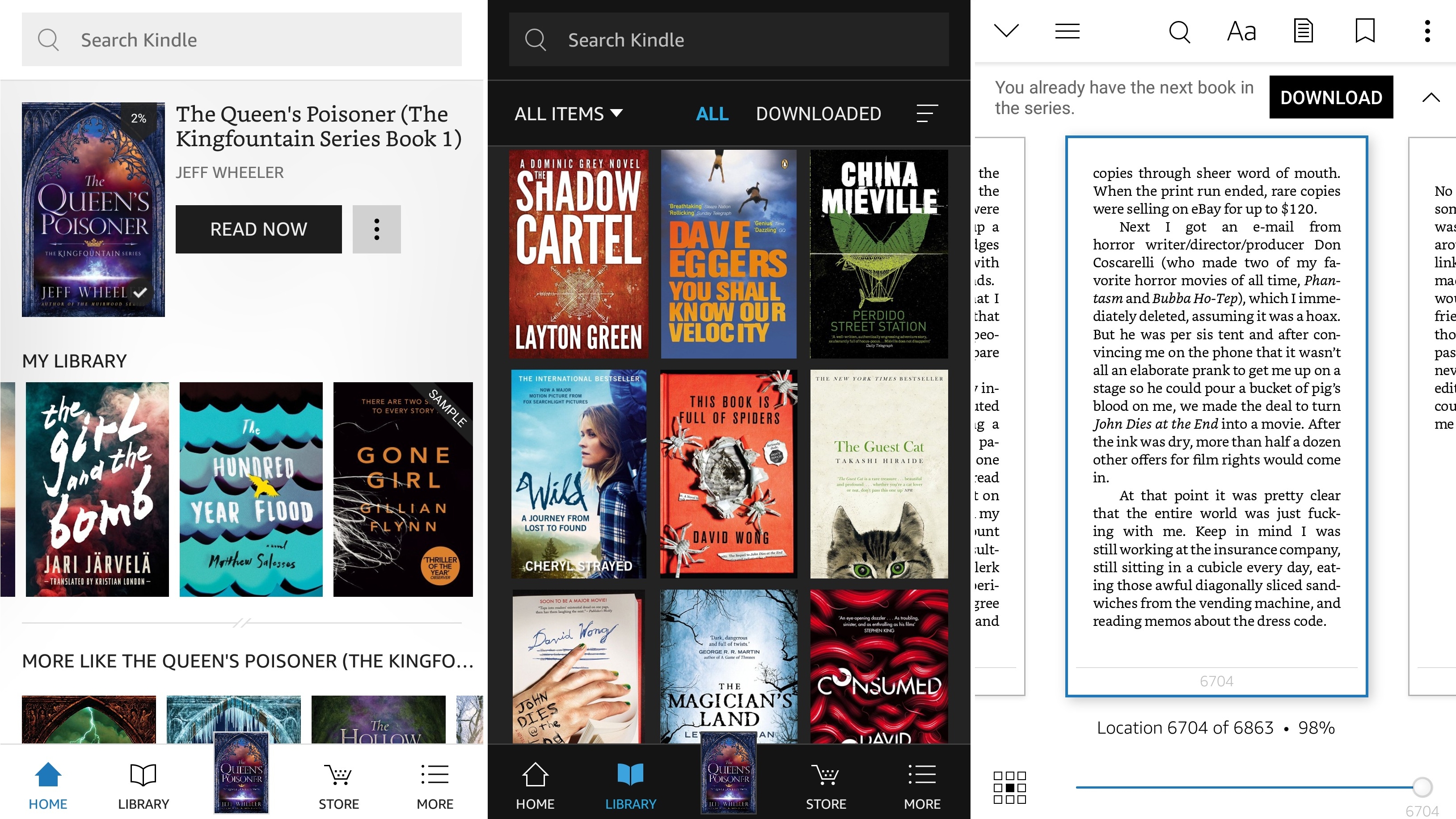
Amazon Kindle
Free
Amazon’s Kindle app isn’t new, but it’s recently been completely overhauled to make it more impressive. There’s a new ‘light’ theme for one, so you now have the choice between light and dark ones, and the whole interface has been refreshed, with bigger book covers and tweaks that help you navigate the app faster.
Soon it will be getting even better, with Goodreads integration coming, so you can rate the book you’re reading and see what other users of the service think.
Even without that though it’s essential for any readers of Amazon’s ebooks, whether or not you own a Kindle, since it gives you access to your library on your phone or tablet, you can pick up where you left off from on another device. On top of that, it has a slick and attractive interface.
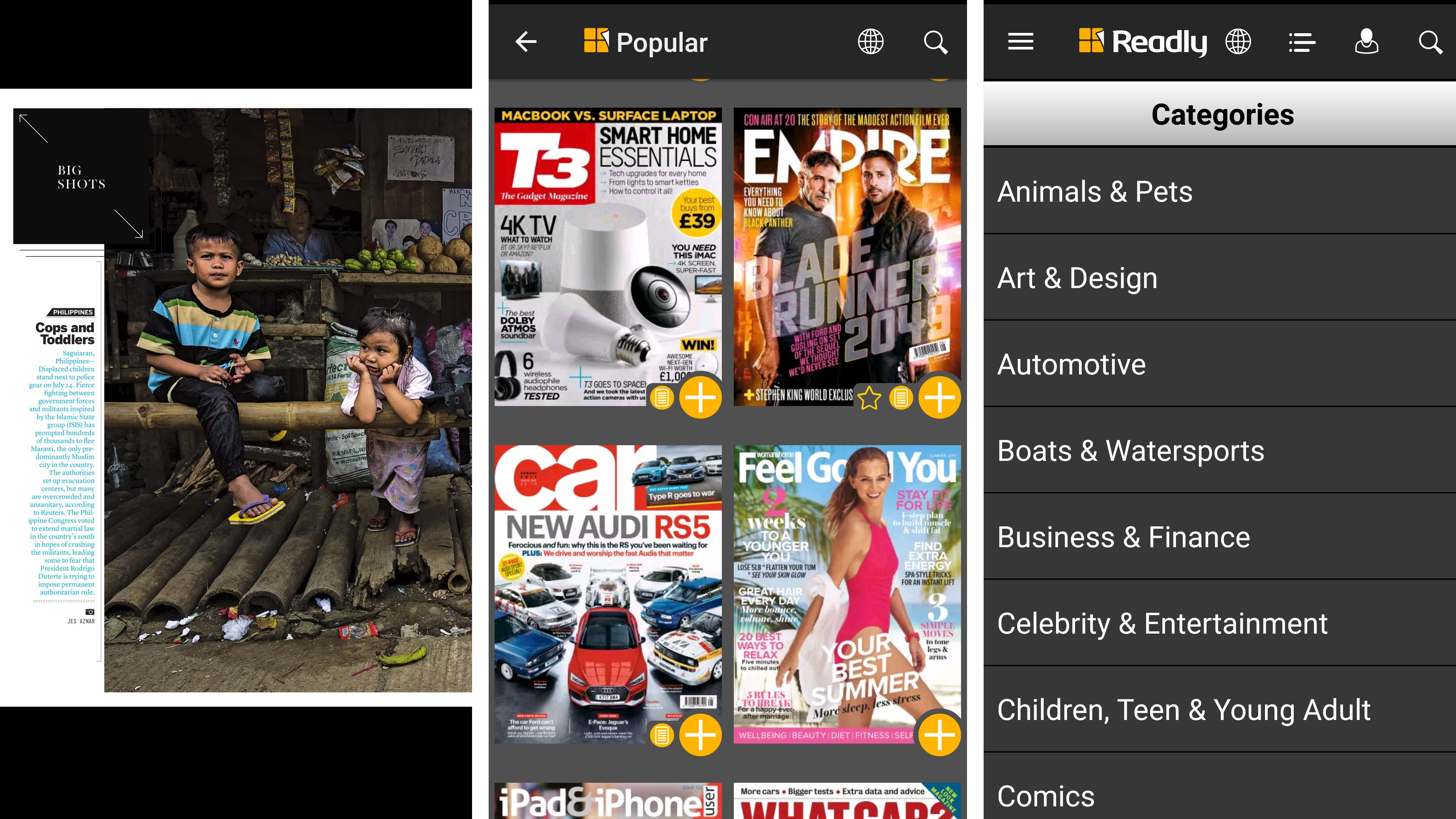
Readly
$9.99/£7.99 per month
In the age of the web, magazines can feel like a dated concept, but Readly does a decent job of bringing them up to date by offering a Netflix-like subscription service.
We say Netflix-like, but while most of the content on there is far from brand new, you have access to the latest issues of thousands of magazines on Readly, all in digital form and with unlimited access for $9.99/£7.99 per month.
You can read content from not just your own country but various others too and the selection is strong, with plenty of big names on offer, along with more niche magazines.
Readly is accessible on phone, tablet and computer, so you can access your magazines almost anywhere with a screen, and even download them for offline reading.
You also have access to back issues, and navigation is a breeze, handled by intuitive swipes and taps. Readly even supports crosswords and other puzzle content, so you can do just about everything you could with a paper version.
Our favorite Android apps for working out, reducing stress and crafting meals.
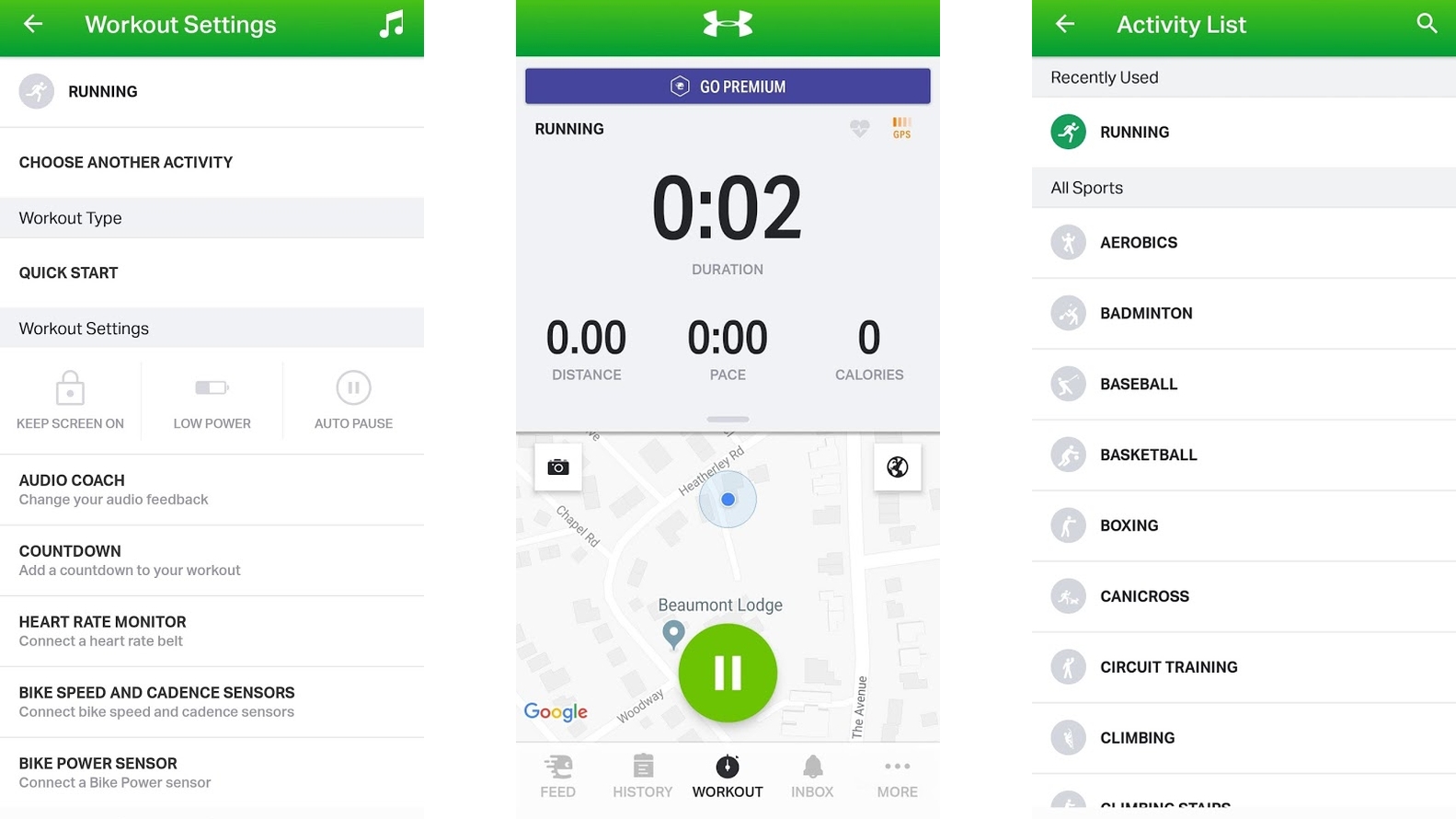
Endomondo
Free + £9.99 (roughly $13) monthly subscription
If you run, cycle or even like to track your walks then there’s a good chance you’ve come across Endomondo before. As one of the oldest, biggest and best apps in the business - it stays that way thanks to regular updates; at the time of writing the app was updated less than two weeks ago.
Even if you don’t run or cycle you might still want to check out Endomondo, as - despite its GPS-tracking specialities - it can also track more than 60 other sports, such as golf, climbing and ice skating.
Alongside route and distance tracking, Endomondo can also track your speed, pace, calories and more. Ff you’re doing a sport that can’t be tracked with GPS then you can manually enter your workout, so you’ve still got a log of your achievements.
Additionally, you can link Endomondo to heart rate monitors and cadence sensors to incorporate their data into your records. The app can also be connected to auxiliary fitness accounts such as Google Fit, Garmin Connect and Polar Flow, so all your health and fitness data will be in sync.
Endomondo also lets you create goals for individual workouts or for your week, so you have targets to hit - the app will even alert you when you achieve a personal best. Plus, you can create and participate in challenges against friends and other users of the app.
And if all that isn’t enough then you can also subscribe to Endomondo Premium, which adds heart rate zone analysis, interval training, personal training plans, access to advanced statistics (such as how far you’ve run in total each month), and more.
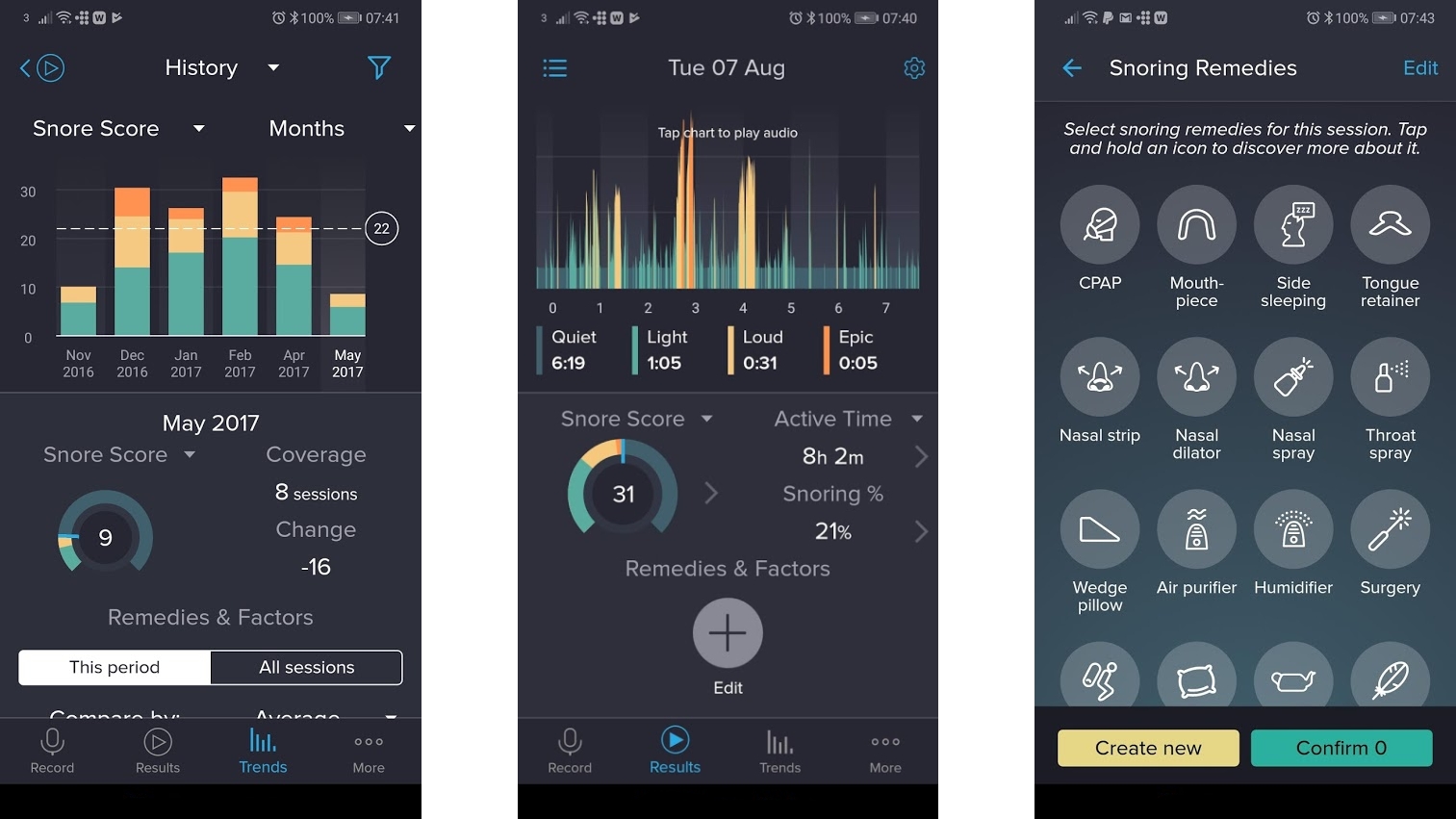
SnoreLab
Free + $6.99/£5.99 IAP
Ever wondered how much you really snore or want to get your snoring under control? SnoreLab can help.
Simply set the app to run while you sleep and it will record snippets of your snoring throughout the night, telling you how loud you snore and giving you a ‘snore score’.
You can also play back the recordings, compare your snoring over multiple nights and log any factors that might be making it worse (such as alcohol) or any remedies you’re trying (such as nasal spray) to see how much difference they really make.
Doing this you can both see first hand how bad your snoring really is and more effectively work out what makes it better or worse.
The core app is free, but there’s a one-off IAP to access your full history and additional features, such as soothing sounds to help you get to sleep.
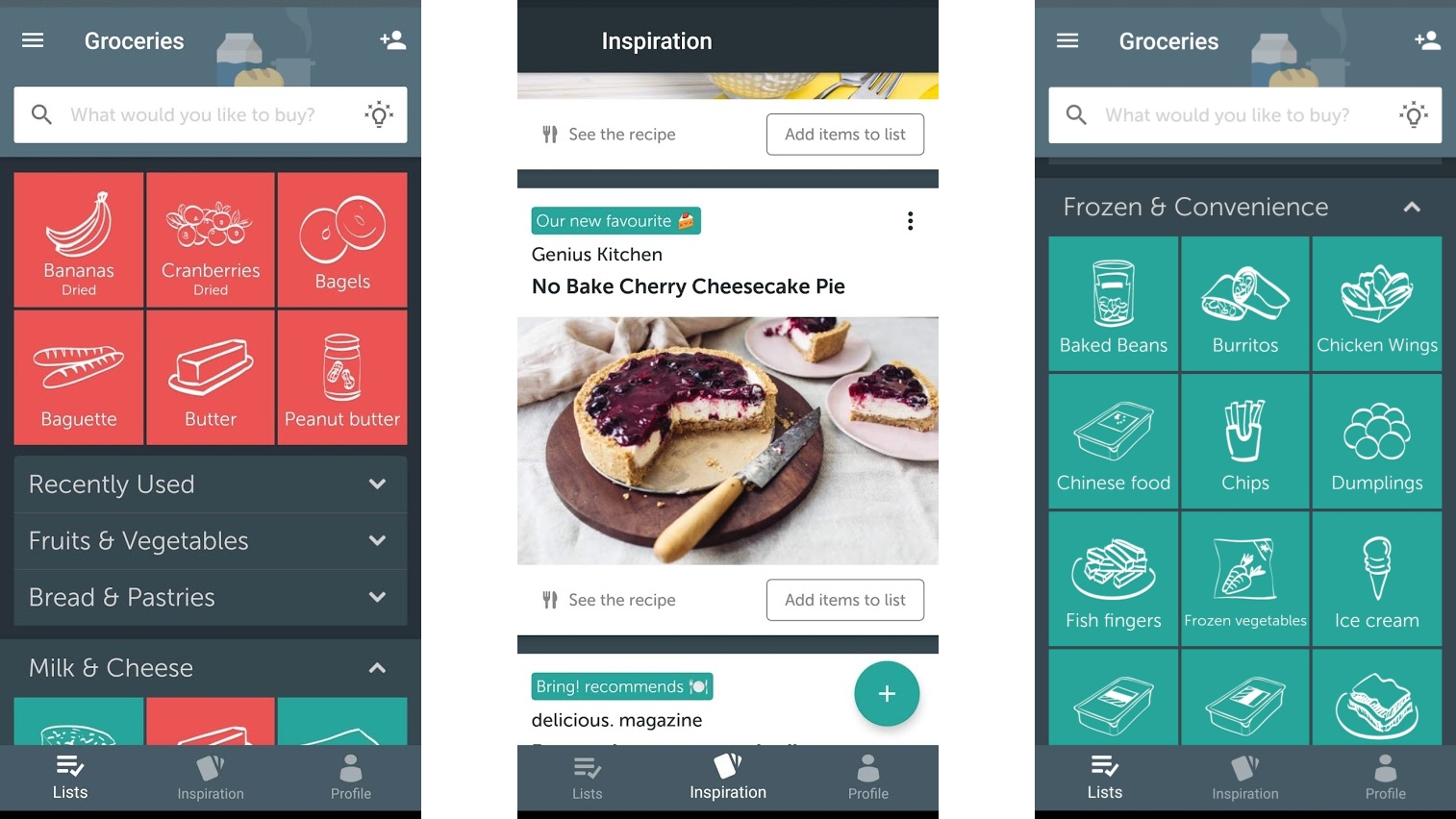
Bring! Grocery Shopping List
Free
Bring! is a grocery shopping app, and while you could just use any old list app to make your shopping list, Bring! has a number of features that help it stand out.
For one thing, it’s communal, in that you can share your lists with other people. In most cases that would mean sharing them with other members of your household so they can all add to the shopping list, see what needs buying, and tick things off as they’re bought.
It’s quite an attractive app, with little sketches accompanying each entry for many common items. You can also add your own images, which is ideal if you want a specific brand of something, so anyone else accessing the list can see exactly what you want.
Bring! has a recipe section too, giving you ideas of things you might want to make and making it easy to add all the relevant ingredients to your shopping list.
You can have multiple lists at once, each with a different name, and Bring! is easy to navigate, so it doesn’t make shopping any more of a chore than it has to be.
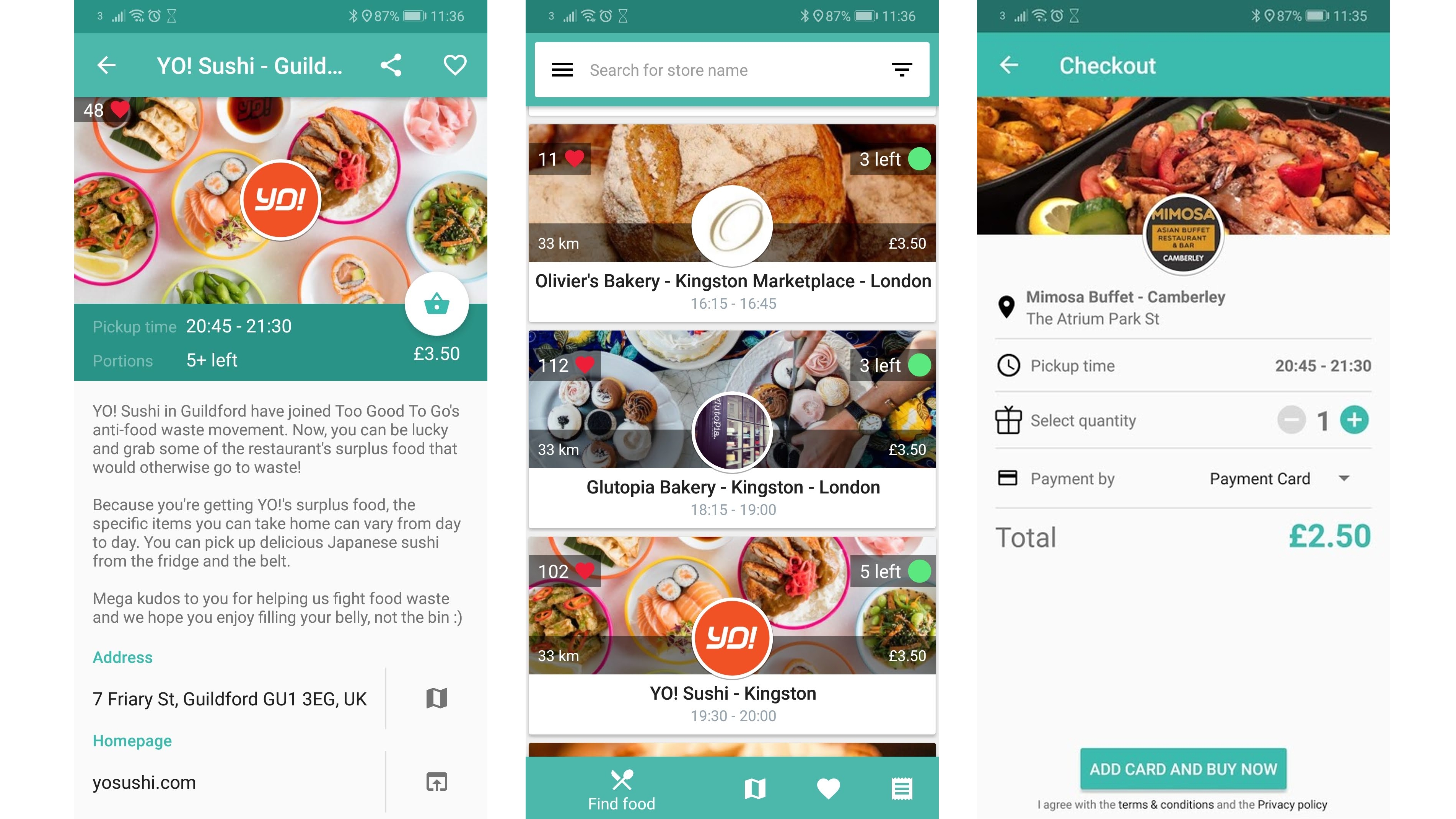
Too Good To Go
Free
Far too much food is wasted every day, but Too Good To Go is helping minimize that, while also letting you get food for yourself at bargain prices.
It’s a simple idea: restaurants, supermarkets and anywhere else that sells food can sign up to Too Good To Go and give users of the app food that would otherwise be thrown away at vastly reduced prices.
The app shows you all the eligible places nearby, complete with the time you’ll need to be there to pick up the food and what it will cost, with prices generally coming in at only a few dollars/pounds.
When you tap on one of the available stores or restaurants you can get more information, such as the type of food that’s likely to be available (though the exact selection will often vary based on what’s actually left over).
If you like what you see you can place an order and pay, and the location will be alerted so the staff will know to expect you.
The main downside is that more places haven’t signed up to it, so if you live outside a city your choices might be limited, but that aside, Too Good To Go is a great way to cut down on food waste and potentially save some money too.
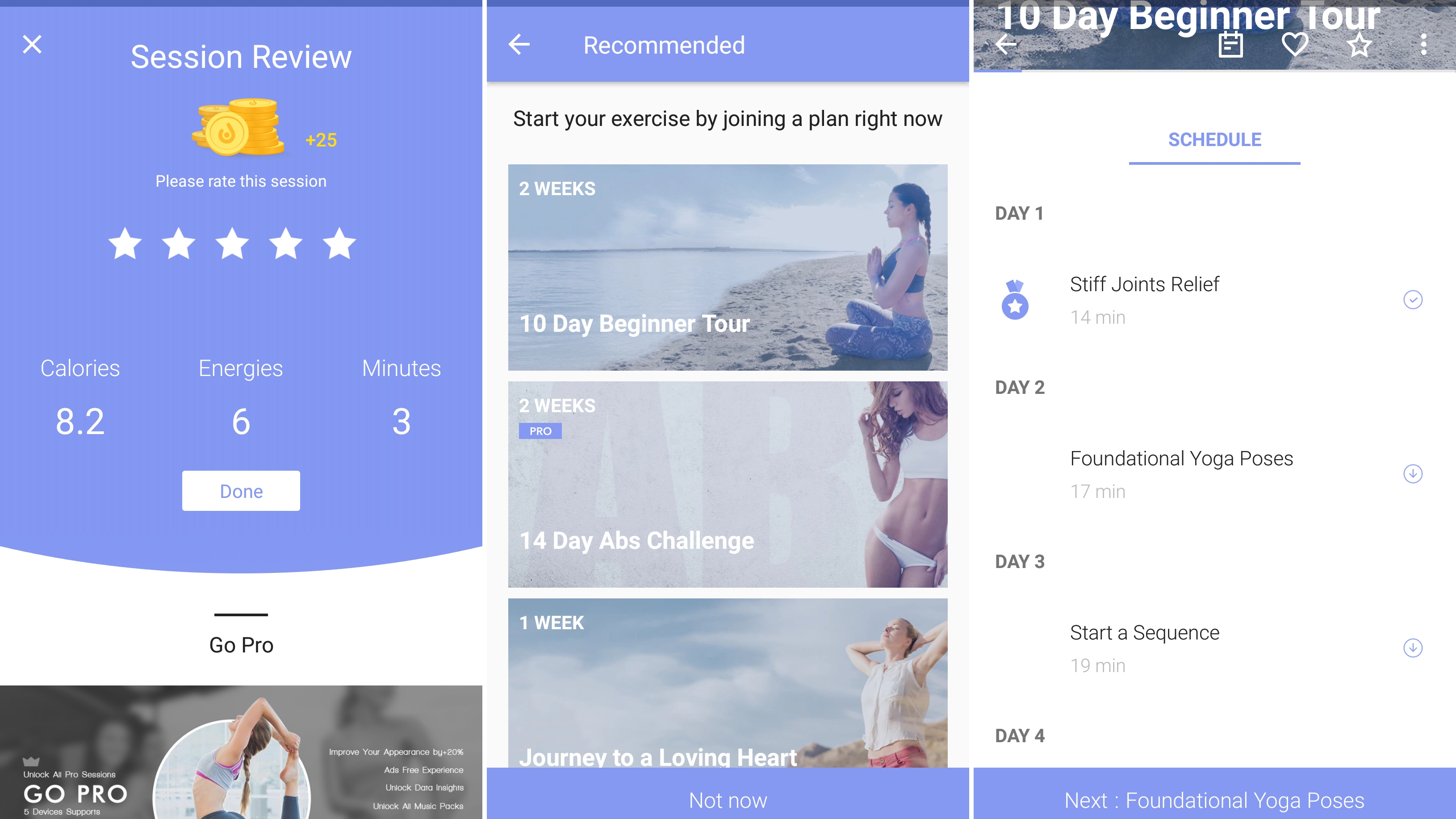
Daily Yoga
Free + subscriptions starting at $19.99/£19.99 per year
Daily Yoga is – as the name suggests – an app for getting a daily dose of yoga. You pick your skill level then can choose from various courses, such as ’30-day yoga challenge’ and ‘a week’s bedtime yoga’, each of which will give you a yoga video to work through every day.
The videos include optional backing music and you can jump backwards and forwards to different poses, with the only real omission being Chromecast support.
There’s a lot more to the Daily Yoga app, including stats, a community section, the ability to earn ‘coins’ as you progress and more. It’s a bit too busy if anything, but it can largely be ignored if all you want is the yoga videos.
Some of the courses are free, but to unlock them all, get rid of adverts and activate additional features (such as a pose library and custom plans), you need to pay a monthly or yearly subscription. There are two tiers and big discounts for buying a year upfront rather than paying monthly. Annual subscriptions start at US$19.99/£19.99, while month-to-month access costs at least US$9.99/£9.99 per instalment.
It’s’s worth shelling out for the year if you decide you want to pay at all, but there’s a reasonable amount of free content to get you started.
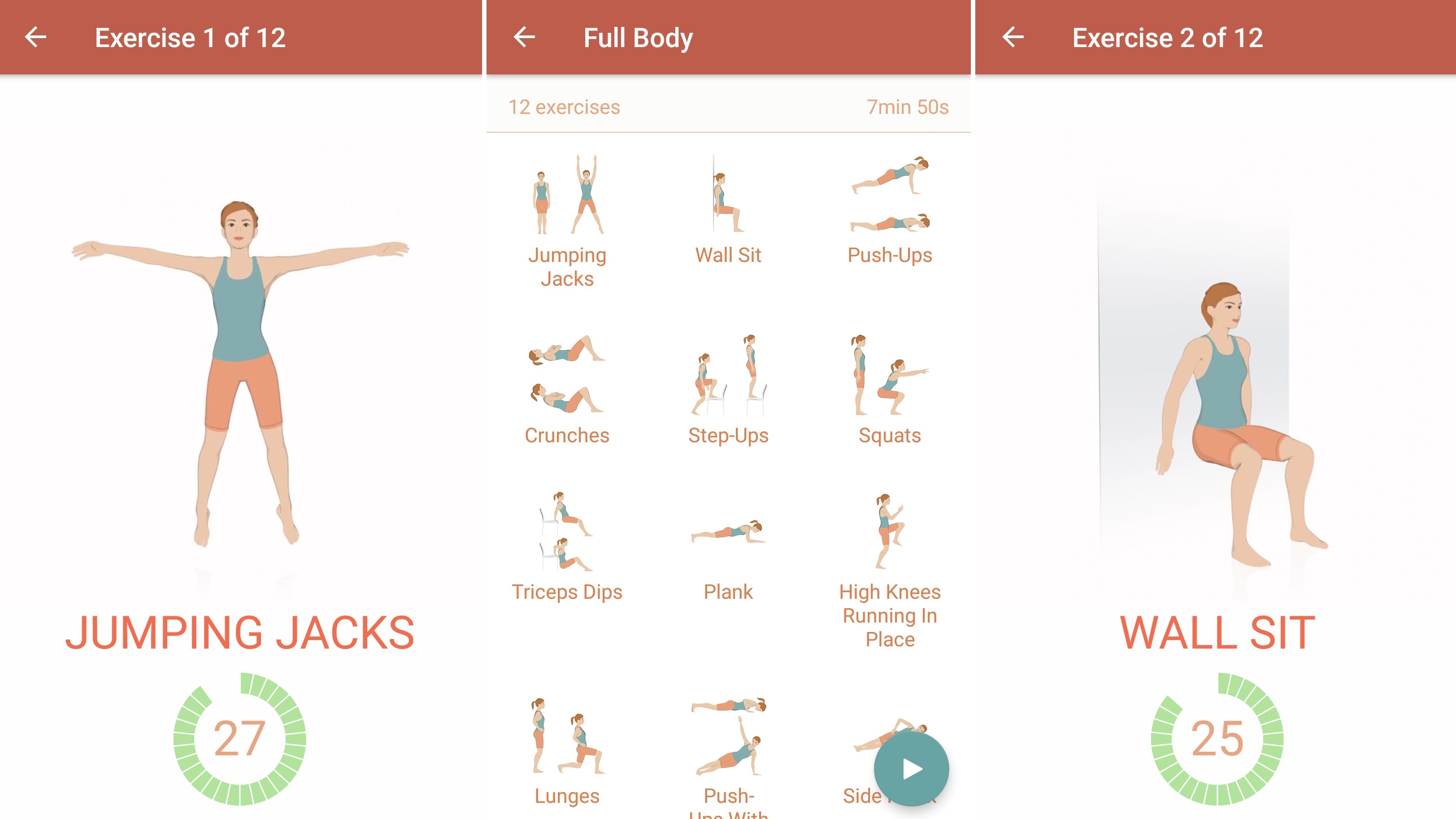
Seven – 7 Minute Workout Training Challenge
Free + $9.99/£9.99 monthly subscription
Seven – 7 Minute Workout Training Challenge is an exercise app for busy people who only have a few minutes to work out, or those who just don’t fancy spending longer than that building up a sweat.
There are a lot of apps with a similar focus, but Seven stands out in a number of ways, from its polished interface to its various achievements, which reward you for sticking with it. There’s even a ‘7 Month Challenge’, which tasks you with working out every day for seven months and causes you to lose one of your three ‘hearts’ for every day that you skip.
The core app has a range of exercises, none of which require any equipment, and there are specific training plans that give you different workouts depending on your goal, be it losing weight, building strength, or a number of other things. You can also create and save your own workouts.
Much of the content is free, but for US$9.99/£9.99 per month you can get additional workouts and exercises (with over 200 available in total), and get personal workout plans that are adapted to your fitness level. The price might sound steep, but it’s still a lot cheaper than most gym memberships.
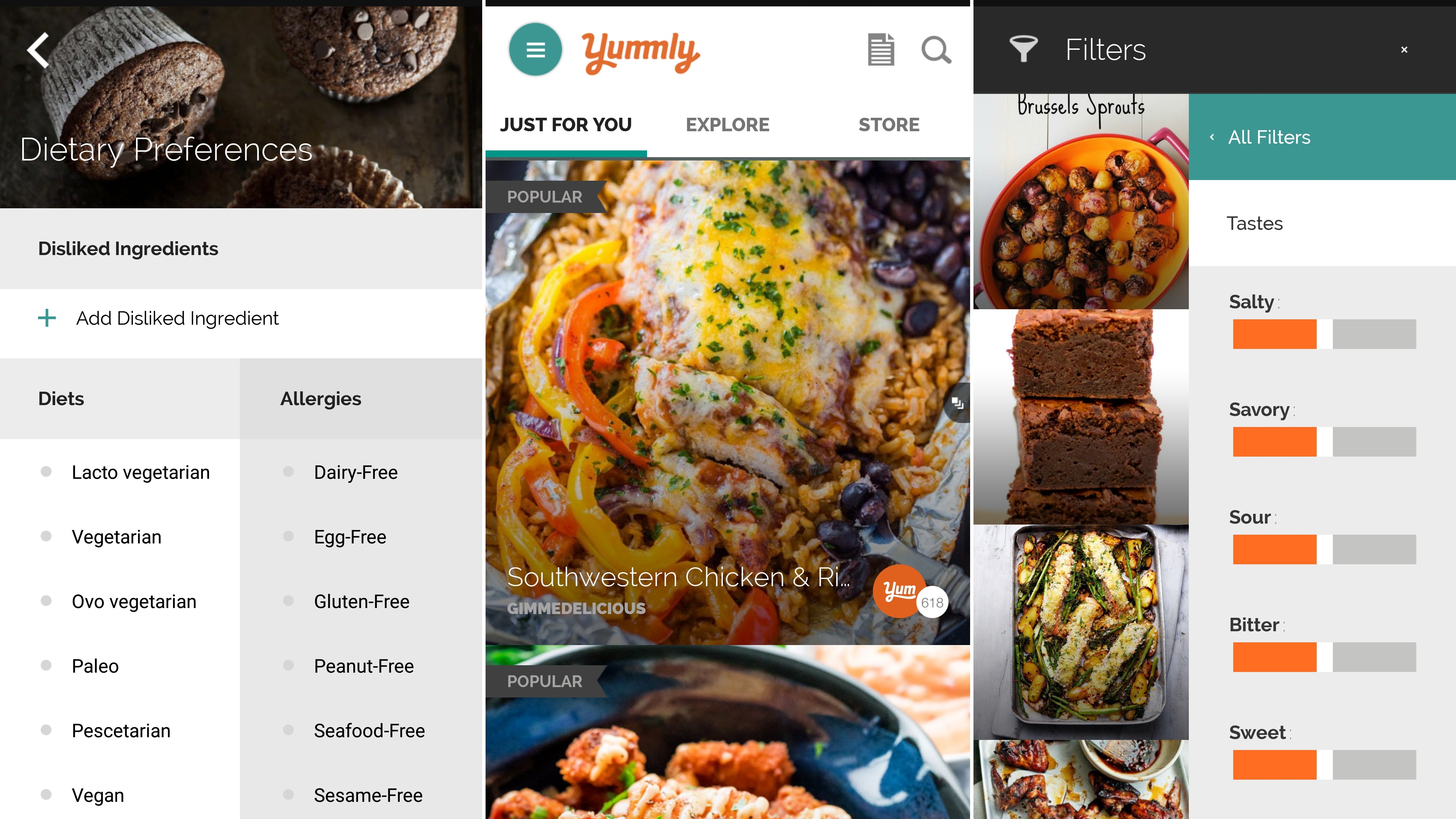
Yummly Recipes & Shopping List
Free
There are loads of cooking and recipe apps available, but if you have specific dietary requirements or are just a picky eater then your options suddenly become a lot more limited. Thankfully, Yummly is there to cater to you.
As well as setting up a dietary profile – choosing whether you’re vegetarian, vegan, paleo, wheat-free or any number of other things – you can also filter out specific ingredients that you don’t like, and that’s just the beginning.
There are also various filters, letting you choose how sweet, salty, spicy or sour you want your food to be, how low in fat or carbs, how many calories, what course or cuisine you’re interested in, how long it takes to make, and what skills or equipment it requires.
You can tweak any of those things any time you search for a dish, so it’s easy to alter your preferences if they change. With over one million recipes Yummly is likely to find a decent selection of dishes no matter what filters you apply.
Once you’ve found what you’re interested in, you can favorite it, add the ingredients to a built-in shopping list, or just get cooking.
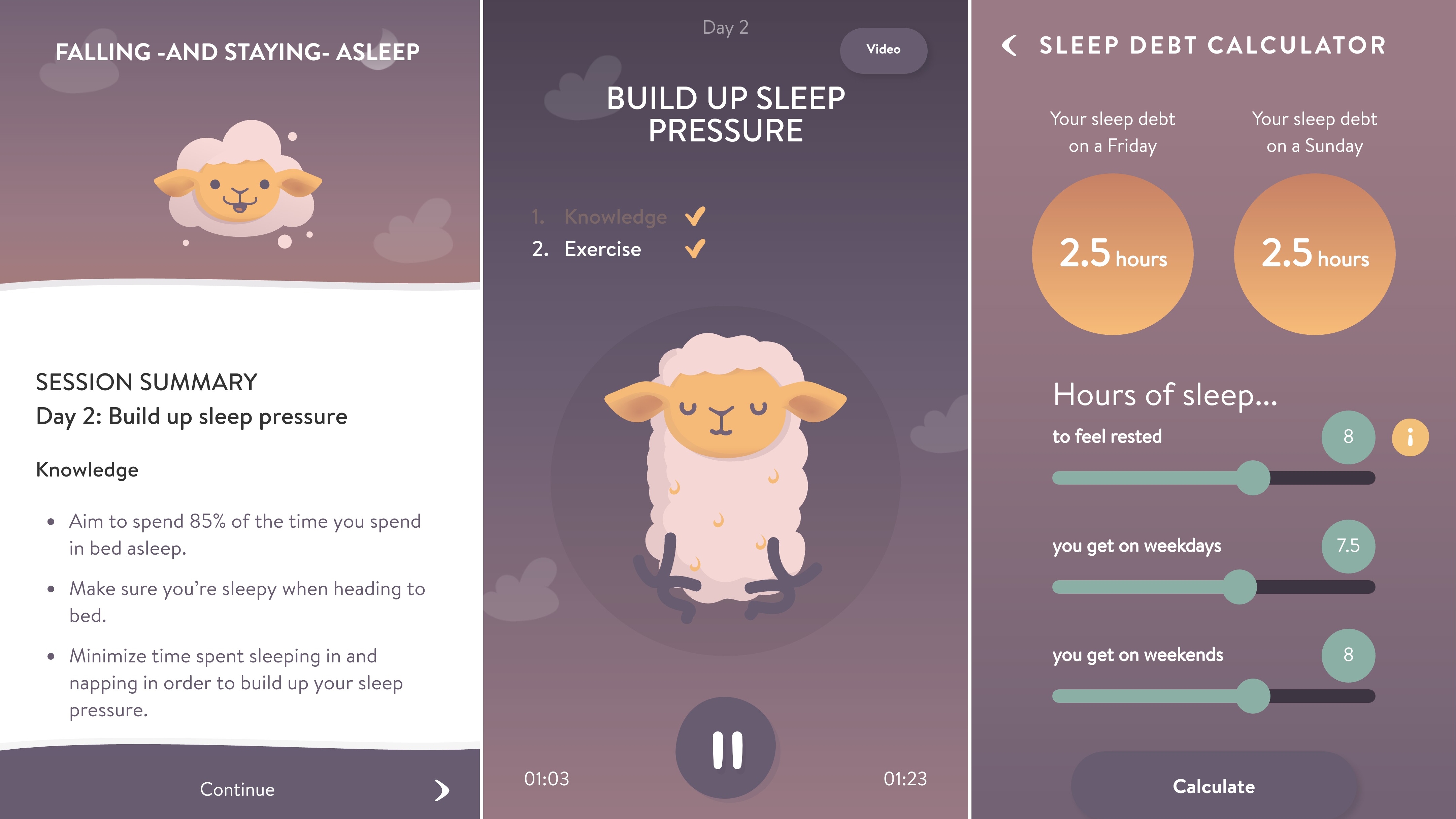
Shleep
Free + $11.99/£10.49 monthly subscription
There are all sorts of apps and gadgets for monitoring your sleep, but few of them give much feedback on how to actually sleep better. That’s what Shleep is for.
When you first start the app, it asks a short series of questions to gauge the general quality and quantity of sleep you’re getting. It will then coach you towards better sleep through short daily videos (or just audio if you prefer), which highlight things that can help and then give you specific things you can try doing – or not doing as the case may be.
These include removing associations with anything other than sleep from your bedroom, only going to bed when you’re actually tired, staying away from screens late at night, and finding effective ways to unwind before you doze off.
Some of these suggestions are obvious and others are less so, but putting them into practice can make a real difference.
Shleep will ask how you slept each night, so you can build up a picture of your sleep quality and whether it’s improving. There are also handy tools like a sleep debt calculator and the option to have daily tips and exercises emailed to you to refer back to later.
You don’t get access to every sleep video for free, but there’s plenty to make a start. If you feel it’s making a difference, there are subscriptions available per month (£10.49/$11.99) or per year (£74.99, roughly $105). You can also unlock everything permanently for a steep one-off fee of £299.99/$389.99. Not cheap, but can you really put a price on not being constantly tired?
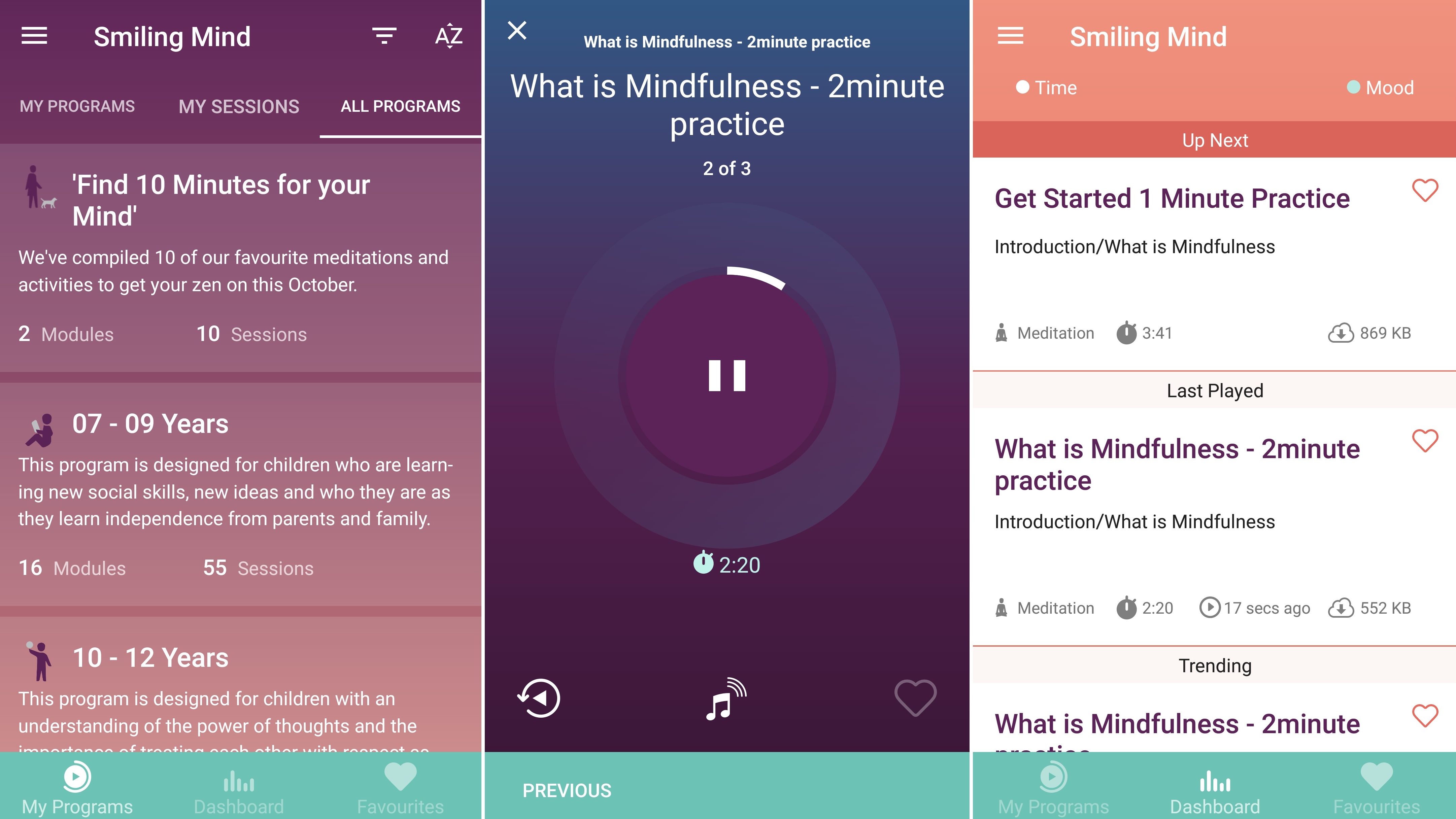
Smiling Mind
Free
There are a lot of meditation apps available on Android, but Smiling Mind differs from most of them in two key ways.
First, it’s completely free, which is refreshing when rivals like Headspace and Simple Habit require monthly subscriptions to access most of their content.
Second, Smiling Mind is aimed at children as well as adults, with a range of meditation courses available for different age ranges, starting at 7-9 years. It even includes lesson plans and activities for educators trying to teach meditation.
If you’re not a kid or an educator there are plenty of other plans that might appeal, from meditation basics, to programs focused on everything from digital detoxes to improving your productivity and sporting skills.
There are a mix of audio and video meditations, of varying lengths, you can set up sub profiles so multiple family members can all use the app, and you’ll see your progress over time, with stats and charts showing how long you’ve spent meditating, how many sessions you’ve done and on which days.

Fitbit Coach
Free + $7.99/£6.30 monthly subscription
Fitbit Coach is the new name for Fitstar, so it’s not a new app as such but it is worth highlighting.
Packed full of workouts and exercise plans, Fitbit Coach has a wide range of content with things suited for most abilities, most of which doesn’t require a gym membership.
There are dozens of bodyweight workouts, plus guided walks and runs and at the time of writing 24 different treadmill workouts, each of which has a duration and an estimated calorie burn that you can see before you start.
There are also various ‘programs’ which have you work through a selection of workouts each week.
Most workouts are videos, which you can cast to your TV if you prefer, but there are also audio ones for runs and walks.
The app aims to keep the workout variety up, which - along with built-in soundtracks from Fitbit Radio - should help keep you motivated, and despite the Fitbit branding there’s no requirement to have a Fitbit in order to use it.
The only problem is that most of this stuff is hidden behind a monthly subscription, but you can access a handful of workouts for free to get a taste of the app before putting any money down.
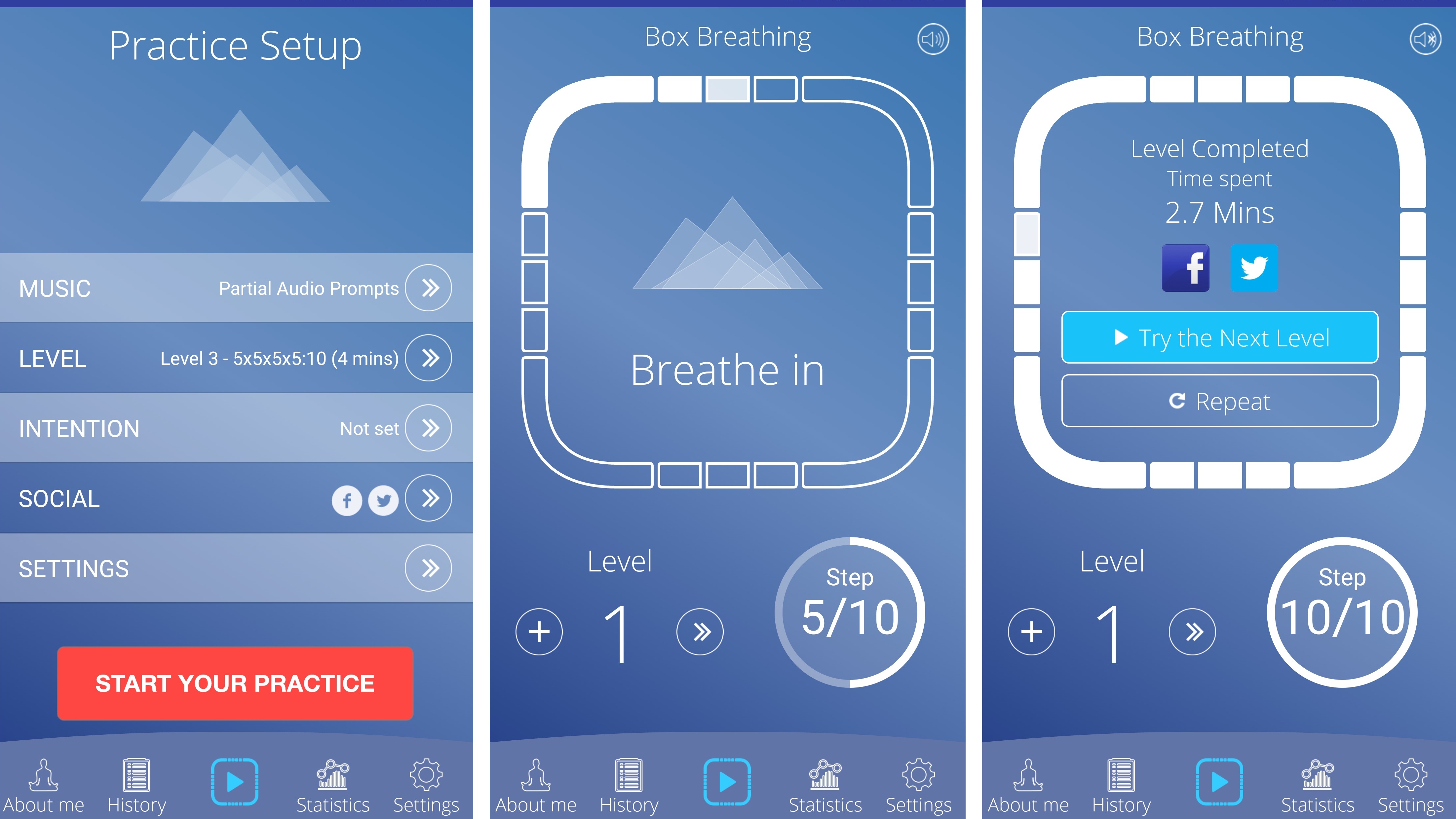
Box Breathing
$4.99/£4.49
Box breathing is a breathing technique used by the Navy Seals, sports professionals and others, which involves taking long deep breaths and holding them.
It has a number of supposed benefits, from reducing stress and anxiety, to improving blood flow, awareness, focus and attention.
While we’re not sure how sound the science is for all of that, it can certainly serve as a calming influence, and the Box Breathing app helps you get started.
It contains an instructional video to help you get the technique down, and then can guide you through the required breaths, with words or sound effects and visual indicators to tell you when to breathe in and out.
You can work through a number of levels, which adjust how deep a breath to take and how long to hold it, or just stick with the basics, and Box Breathing also keeps a log of your breathing practice and can be set to remind you to do it daily.
There are even gamification features, with new ranks handed out for practicing a number of consecutive days. And all in all, the app is about as comprehensive as possible for such a simple technique, and justifies its price tag.
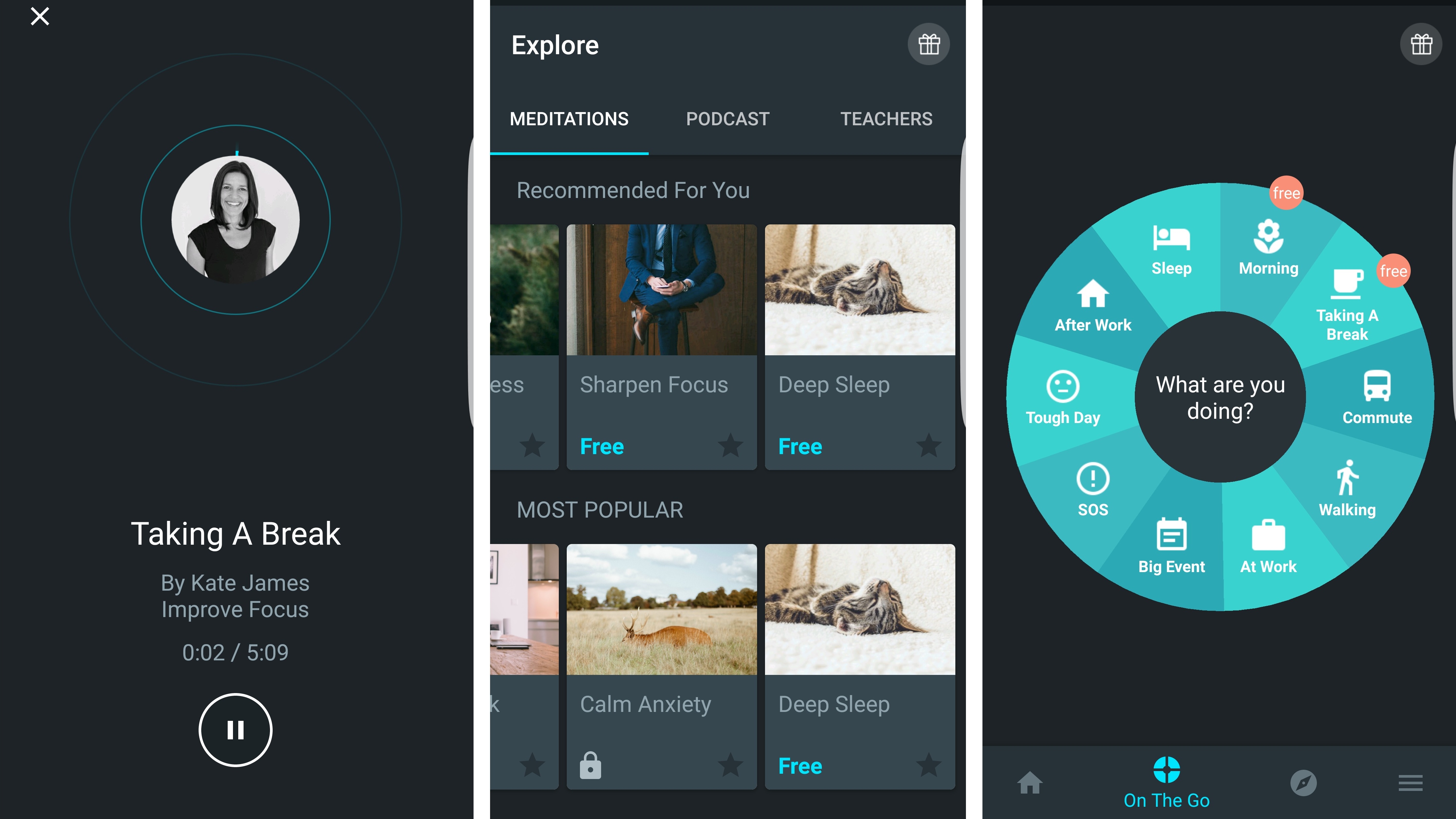
Simple Habit
Free + $9.99/£9.99 monthly subscription
Meditation apps are meant, among other things, to relax and de-stress us, but if you’re anything like us they run the risk of doing the opposite, becoming chores that we feel guilty for neglecting.
Simple Habit doesn’t completely solve that problem, but it gets some way there, by offering short 5-minute meditations, that you can easily fit in at any point during your day.
Other meditation apps have short sessions too, but there are usually only a few of them, mixed in with longer meditations, while they’re all short in Simple Habit (though we do have to point out some stretch beyond 5 minutes to cater for those that do want a bit more relaxation).
Simple Habit also has a variety of different teachers to guide you, so if you don’t get on with one (or just get bored of their voice) there are plenty of others to choose from.
The rest of the app is as you’d expect, with meditations designed around specific life circumstances, goals or moods, and a simple interface that doesn’t get in the way.
Like Headspace, most of the meditations are locked behind a subscription, but you can listen to a handful for free to see if Simple Habit is for you.
Our favorite Android apps for making music, listening to music, finding podcasts and everything else to do with audio.
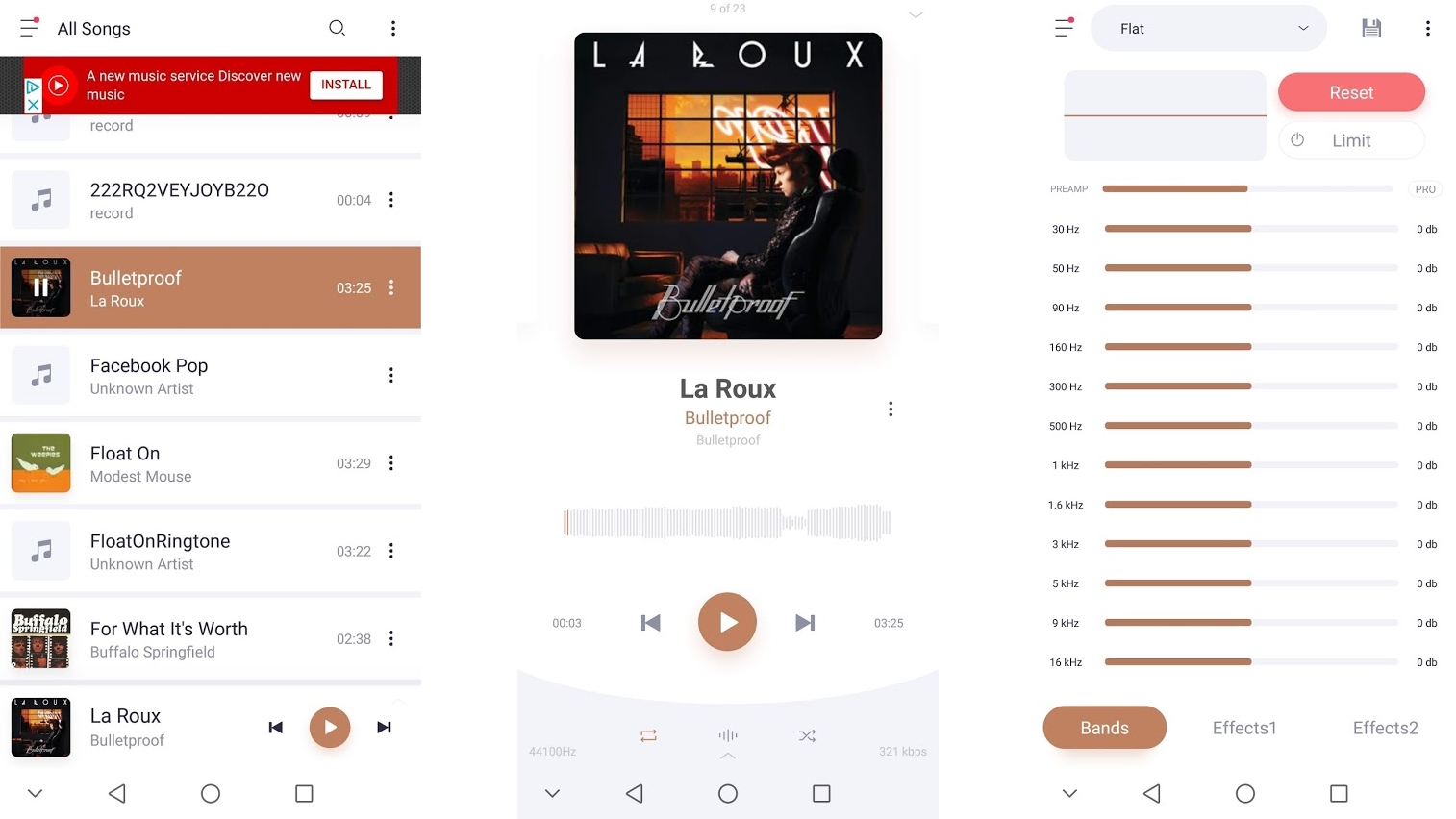
Stellio Player
Free + $2.99/£2.69 IAP
Stellio Player is a ridiculously full-featured music player which has everything you’d expect and more, such as widgets, support for multiple audio formats (including lossless ones such as FLAC), lock screen music controls, and the ability to sort by album, artist, genre or folder.
Additionally, Stellio Player lets you control music through your notification shade, has a sleep timer, and gives rich control over the sound, with a 12-band equalizer with complementary effect controls such as echo and reverb. Further features include gapless playback, crossfade, and the ability to change track with a long press of a volume button.
The player is stylish and can change color to match the album art of the track you’re listening to, or you can select from a number of other themes to further customize it.
Android Wear users will appreciate Stellio’s Wear OS support, so you can control your music from your wrist too.
All of this is free, but for a one-off payment of $2.99/£2.69 you can remove adverts (which are unobtrusive anyway) and access a new theme.
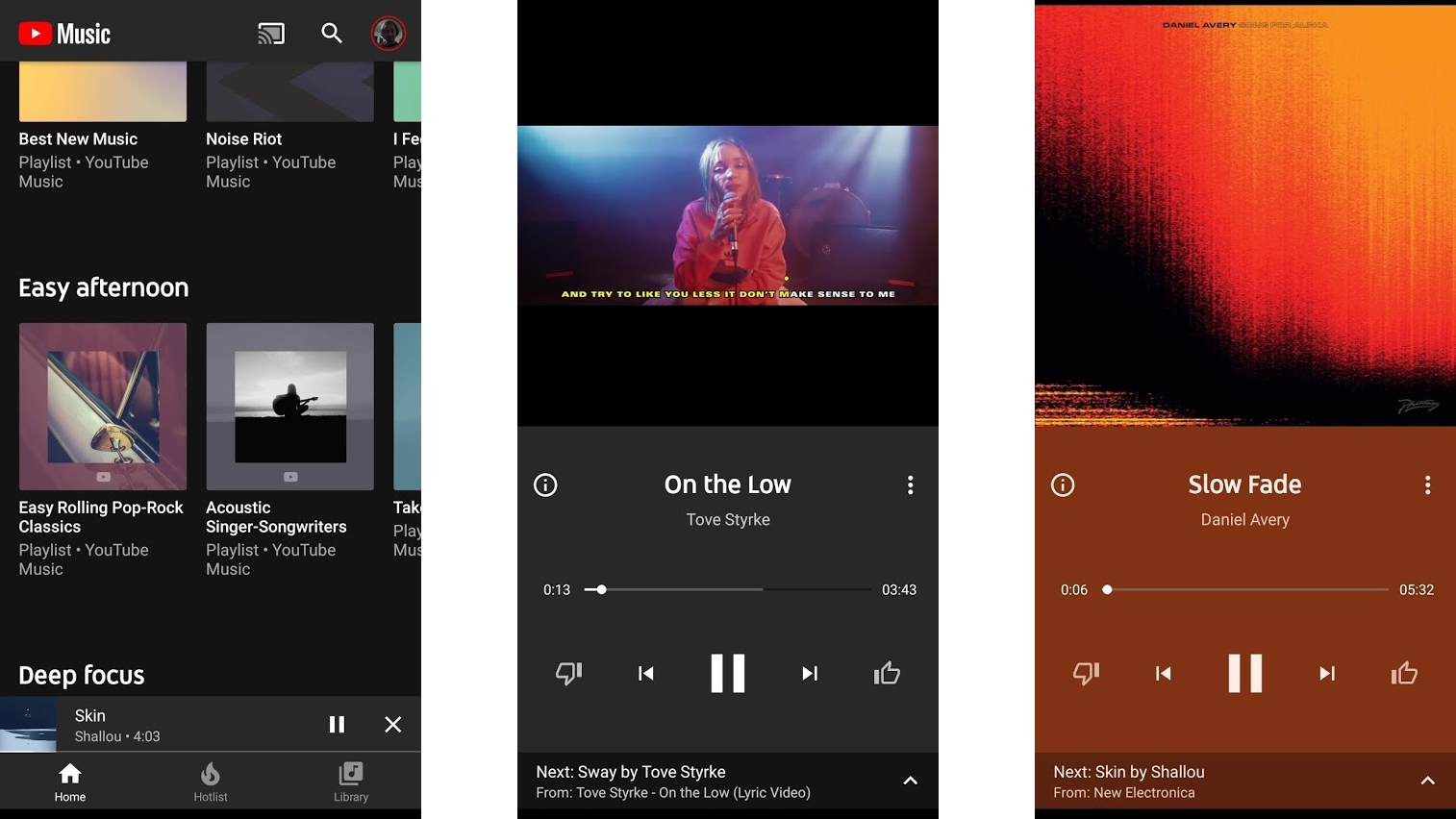
YouTube Music
Free + optional $9.99/£9.99 monthly subscription
YouTube Music is a YouTube app that puts the shows and shorts to one side and is all about the music. It’s all here, presented with personalized recommendations and a constantly updated ‘hotlist’ of trending tracks. There are also numerous playlists, and you can create your own.
That’s all free, but to get the most out of YouTube Music you need to pay for YouTube Music Premium, which costs US$9.99/£9.99 per month and lets you listen offline, with your screen off, or while using other apps. It also gets rid of the adverts.
However, if that sounds appealing you’re probably best off paying for YouTube Premium. This subscription costs slightly more at US$11.99/£11.99 per month, but also gives you access to the main YouTube site and apps ad-free, lets you watch YouTube originals, enables you to play videos in the background, and more besides.
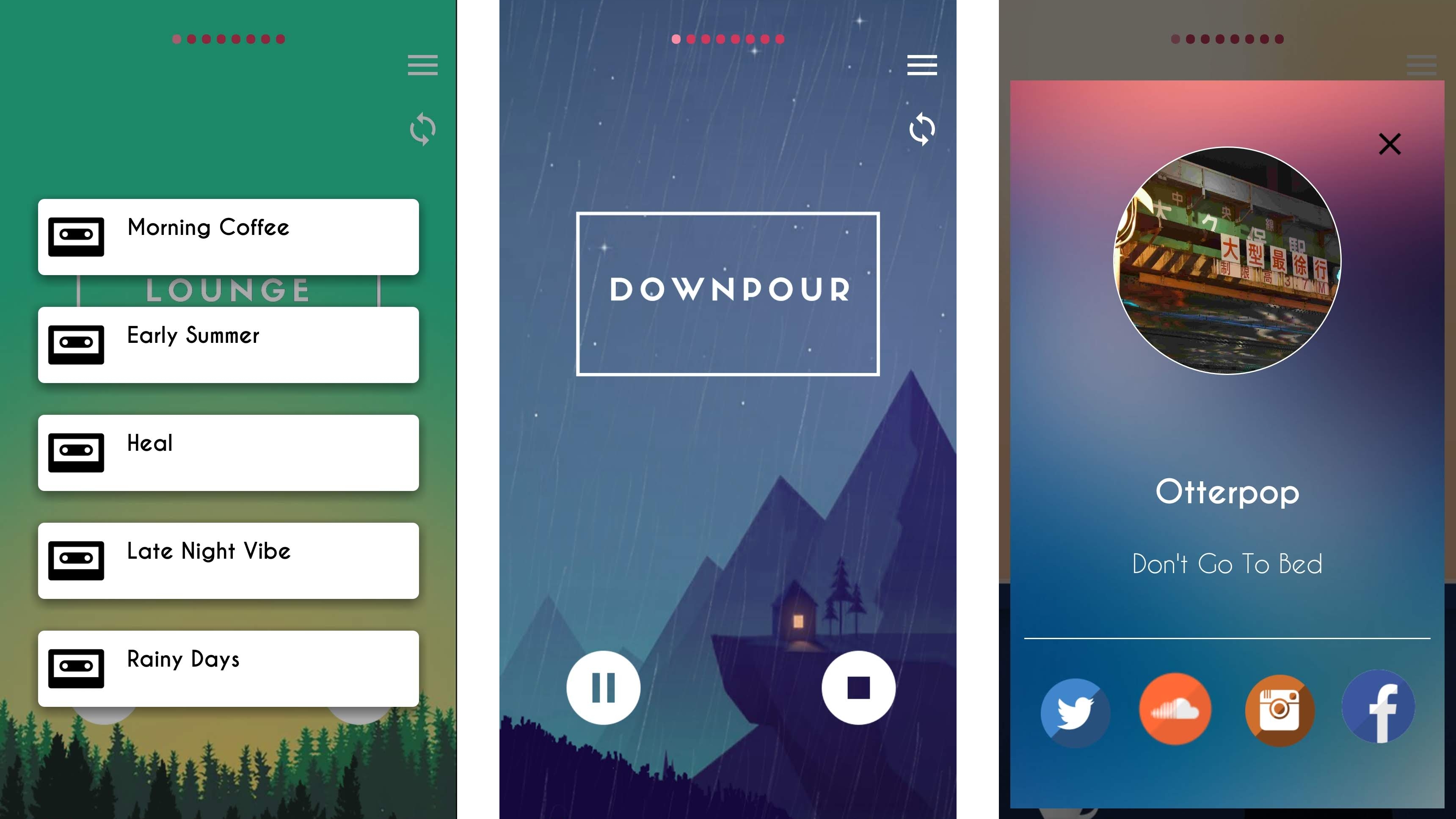
Loffee
Free
Loffee is a gorgeous app that provides a curated collection of lo-fi music ideal for putting on in the background.
Current playlists include ‘morning coffee’, ‘late night vibe’ and ‘rainy days’ among others. Each one is designed around a certain mood or time of day, and contains a selection of fitting tracks.
Unless you’re seriously into lo-fi sounds you probably won’t have heard much if any of it, but that’s all the better because there’s some great stuff here waiting to be discovered. It’s all served up alongside nicely done artworks, making the app itself pleasant to navigate.
Loffee is limited in a lot of ways – the selection of music is fairly small for example and you can’t cast it to speakers, but just about everything that is here – from the music to the app design – is great.
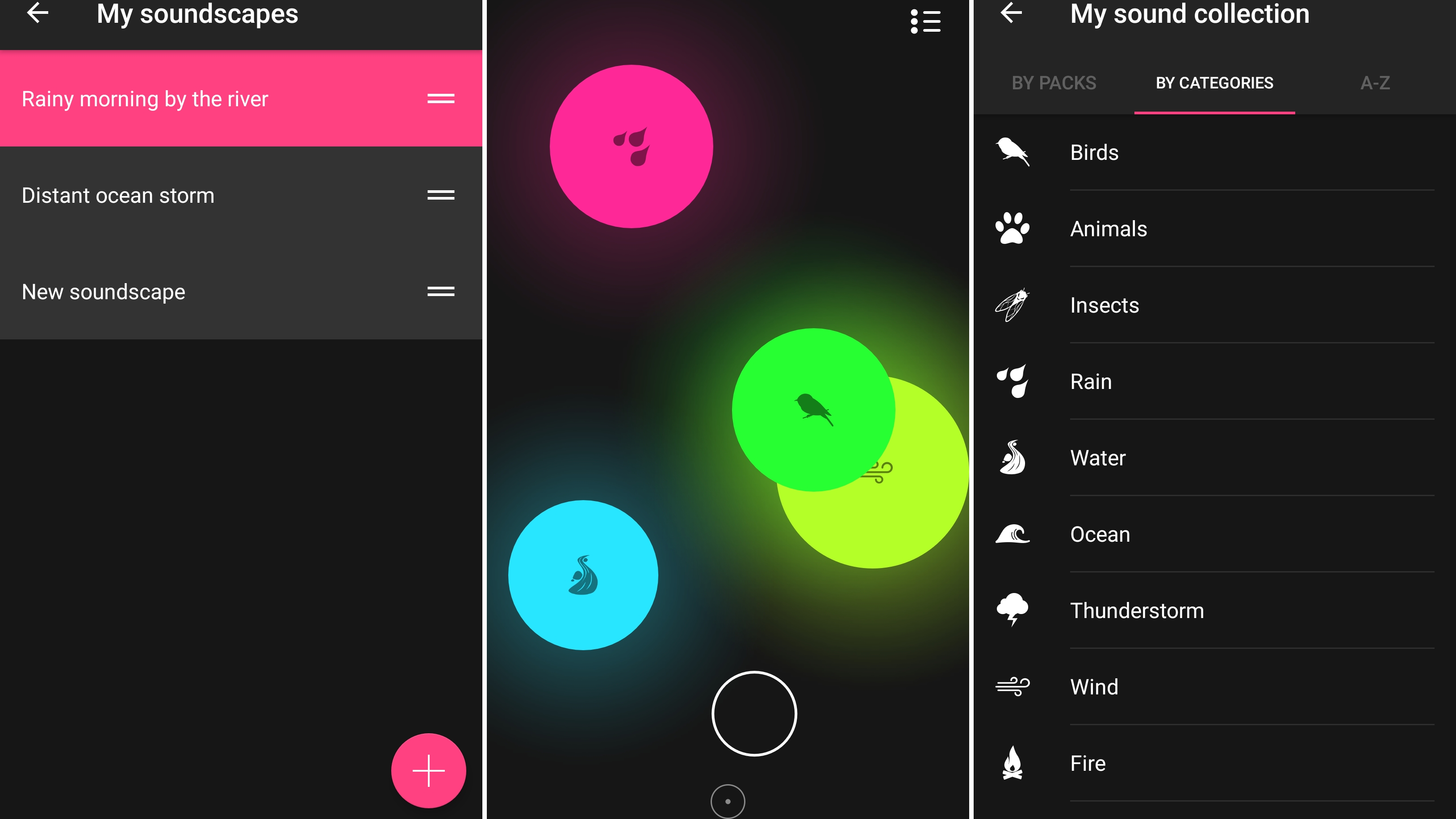
TaoMix 2
Free + various IAP
TaoMix 2 is an ambient noise app designed to drown out the outside world and help you relax, sleep or focus.
There are lots of sounds to choose from, such as birds chirping, rain, waves, wind, a fireplace, a thunderstorm and many more. But you’re not limited to one sound – you can build a soundscape by selecting several at once.
Each of these sounds appears as a circle on your screen and there’s another circle which can be made to move around the screen, and which makes each sound more prominent when it overlaps with them, so the soundscapes vary over time based on the movements of this circle.
You can save any soundscape you make to easily return to it later and you can set a timer, so the soundscape will automatically turn off after a set period of time. You can even record your own sounds.
The core app is free, but to get the most out of TaoMix 2 you’ll want to invest in some of the sound packs to bulk up the available selection. These start at £0.69/US$0.99.

Ringtone Maker Pro
$3.99/£3.29
Got a song that you want to use as a ringtone but want to cut it down first? Ringtone Maker Pro will get the job done.
It supports MP3, FLAC, OGG, WAV, AAC, M4A, MP4 and 3GPP/AMR files, and should be able to find any audio file on your device when you hit the scan button. Select the one you want to edit, then choose a start and end point for the ringtone right down to the millisecond.
There’s scope for more complex editing too; you can cut parts of the song, copy and paste sections, or paste together parts of multiple audio files.
You’re not limited to the music that’s already on your phone either – you can also record your own ringtone using your voice or any other noise you can create.
The app is fairly straightforward to use and in this form it comes free of adverts, but if you’d rather have the adverts and not have to pay there’s also a free version available.
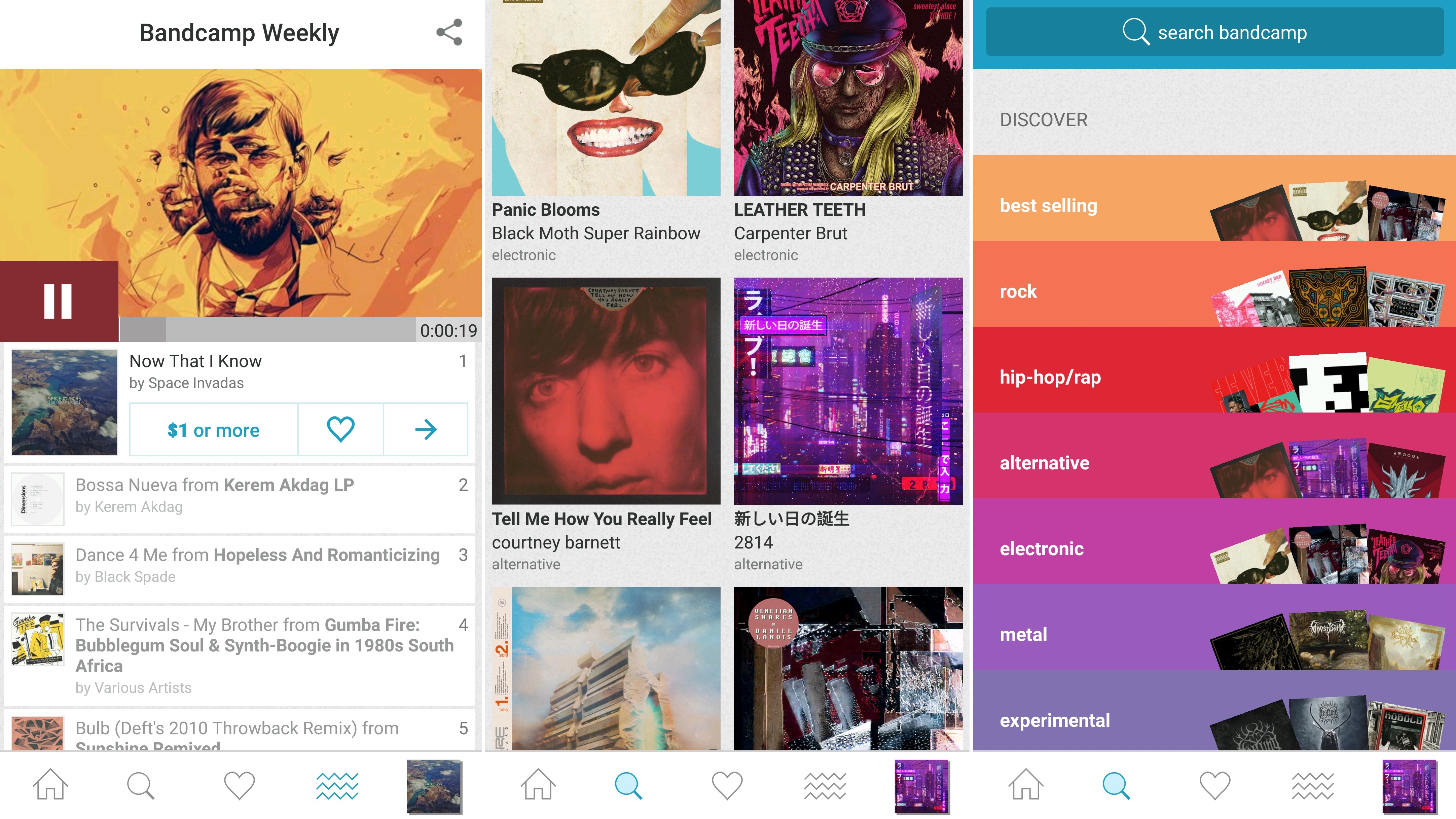
Bandcamp
Free
The Bandcamp app is brilliant whether you’ve bought music from the site before, or you’re just interested in discovering new songs.
It houses loads of music from loads of artists – mostly but not exclusively independents, so they’re ones you’re less likely to have heard on the radio.
You can browse music by genre or search for specific artists, but Bandcamp will also highlight music in its featured feed, and if you favorite any artists you’ll see releases from them in your music feed.
You can listen to much of the music for free, and access streams and downloads of any music you’ve bought from Bandcamp. There’s even a weekly podcast highlighting interesting music you might not have heard.
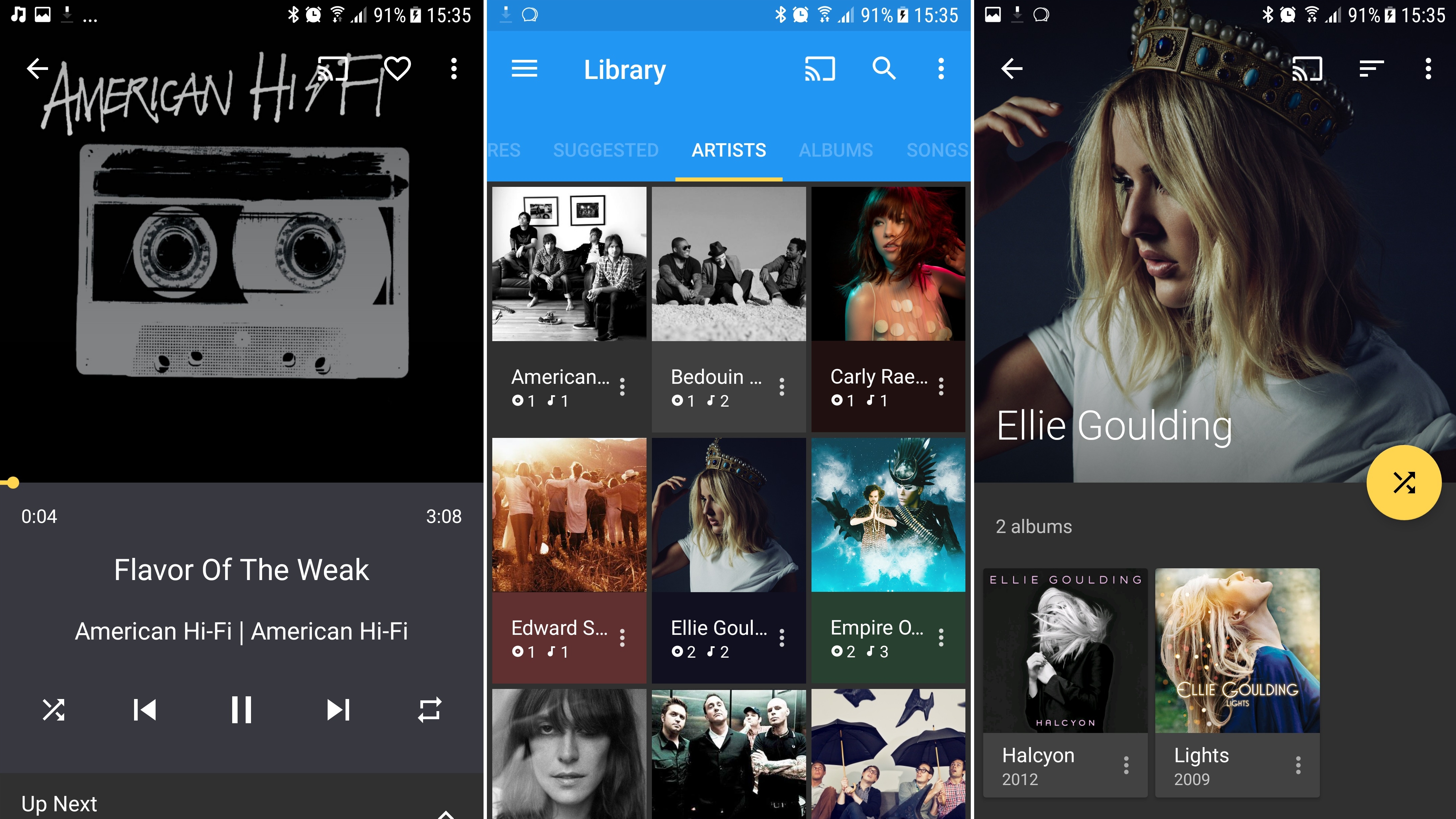
Shuttle+ Music Player
$2.49/£2.69
Shuttle+ Music Player has been around for ages, and it’s long been one of the best players for anyone who prefers owning music to streaming it from the likes of Spotify or Google Play Music.
Shuttle+ is now better than ever thanks to a recent update bringing it to version 2.0. The app’s interface has undergone a major overhaul, making it more intuitive than ever. The update has also added new features, including the ability to shuffle albums as well as songs, and dynamic themes, which change to match the album artwork of what you’re listening to.
Beyond the new additions and refreshed interface this is the same impressive app it’s always been, packed full of features including a six-band equalizer, gapless playback, a sleep timer, widgets, Chromecast support, automatic album artwork downloads and a whole lot more.
There’s also a free version, but it lacks certain features such as Chromecast support, and the paid version is more than worth the money if you listen to a lot of locally stored music.
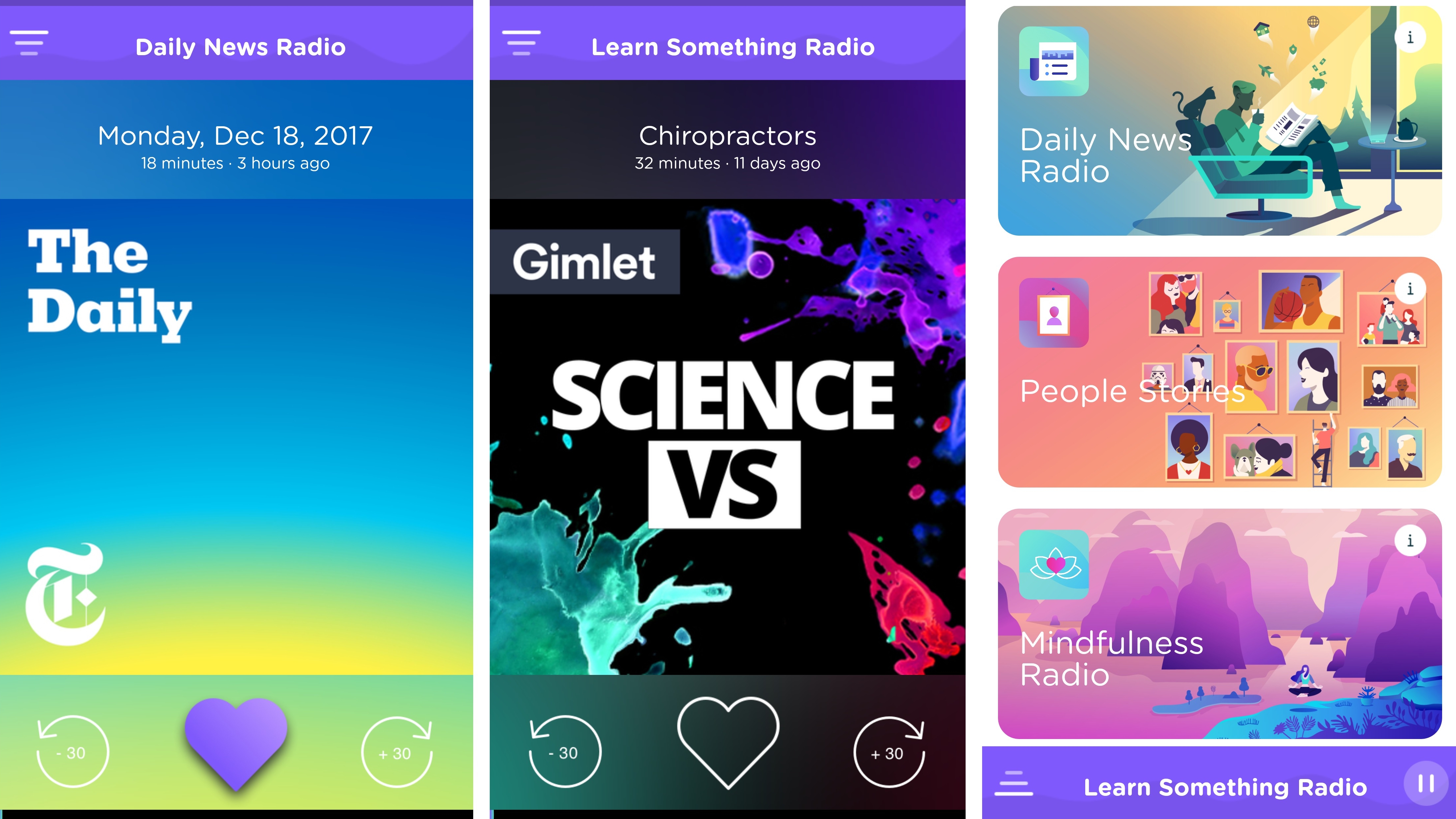
Scout FM
Free
Scout FM is all about finding new podcasts to listen to, and it helps you do this by taking its inspiration from radio.
The app has a variety of ‘stations’, each of which has a different theme, such as ‘Book Worm’, ‘Daily News’ or ‘Learn Something’.
Select a station and a relevant podcast will start playing automatically. You can see the name and choose to pause it, jump forward or back, change the playback speed, or ‘heart’ it (so that the app knows you like it). If you’re not feeling it, simply swipe and you’ll get a different podcast – or in some cases a different episode of the same one.
Over time the app will learn more about what you do and don’t like, and the podcasts that appear in each radio station will change as a result.
The interface is simple and colorful, and with such simple controls you can easily use the app even when walking or working out.
The fact that you can’t choose specific podcasts means Scout FM is best used as a way to find new podcasts that you can then listen to in a conventional podcast app, but it’s very good for that, and it’s free.
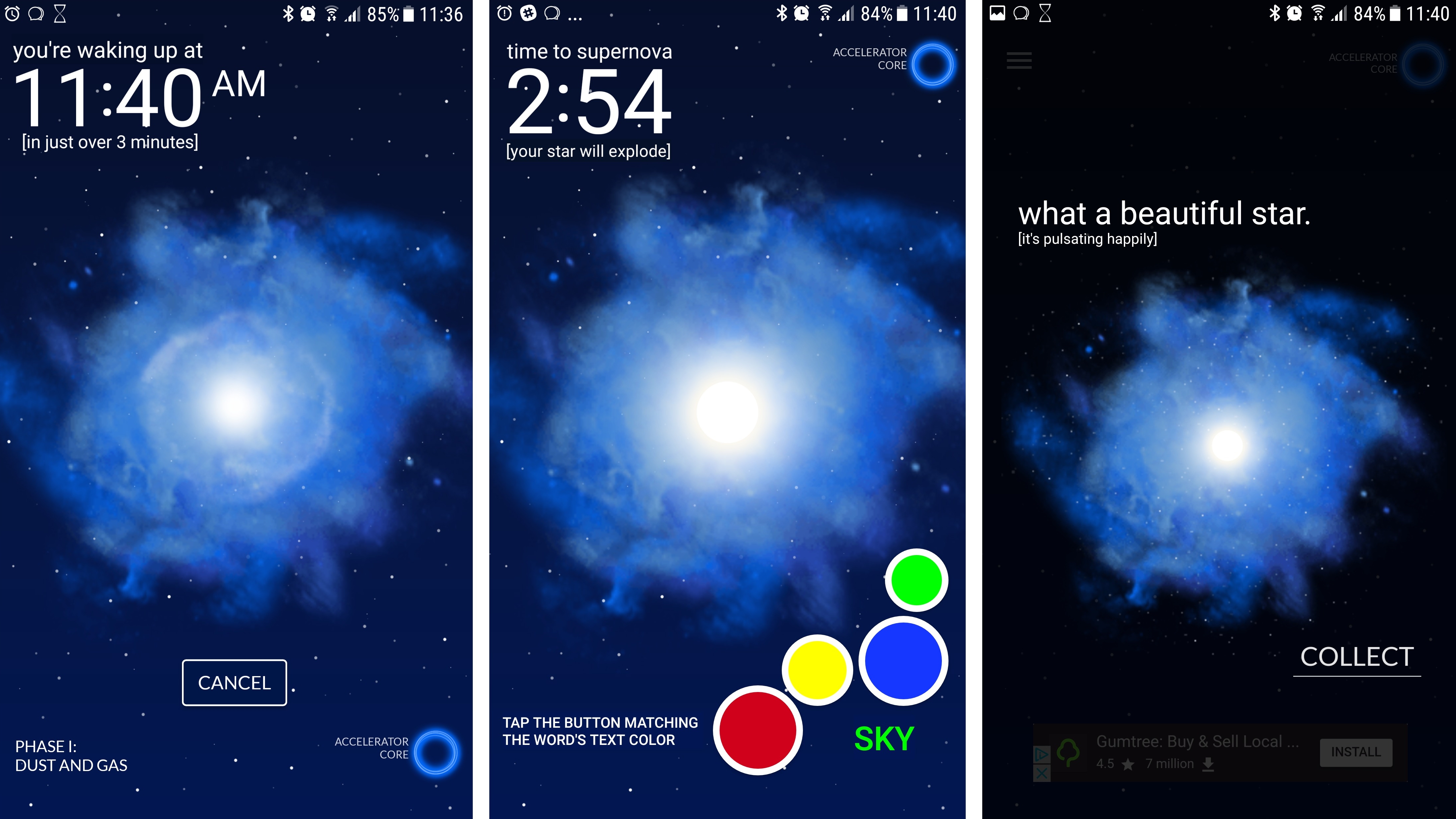
Nebula Alarm Clock
Free + $2.49/£2.09 IAP
If you have trouble getting up in the morning, or just want some extra incentive to do so, then Nebula Alarm Clock could be the answer.
Every night the app will grow a star, which you can collect in the morning and eventually use to build constellations.
The catch is that you only have a few minutes to claim your star, and to do so you have to turn the alarm off, which means no snoozing. It can optionally involve having to solve a challenge too, such as scanning a barcode or completing a brain teaser.
If you fail to collect the star, not only do you lose it, but the supernova will break any constellation you’ve been working on, so you could lose several nights’ work if you don’t get up in time.
There are other features too, such as having soothing sound effects play for a set amount of time when you go to bed, choosing between various alarm sounds, deciding how much time you have to claim your star in the morning, and setting the alarm to gradually get louder.
There are rewards for completing constellations too, such as unlocking new sound effects to send you off to sleep.
The core app is free, but for additional alarms and sounds and to remove adverts you can pay for a $2.49/£2.09 one-off IAP.
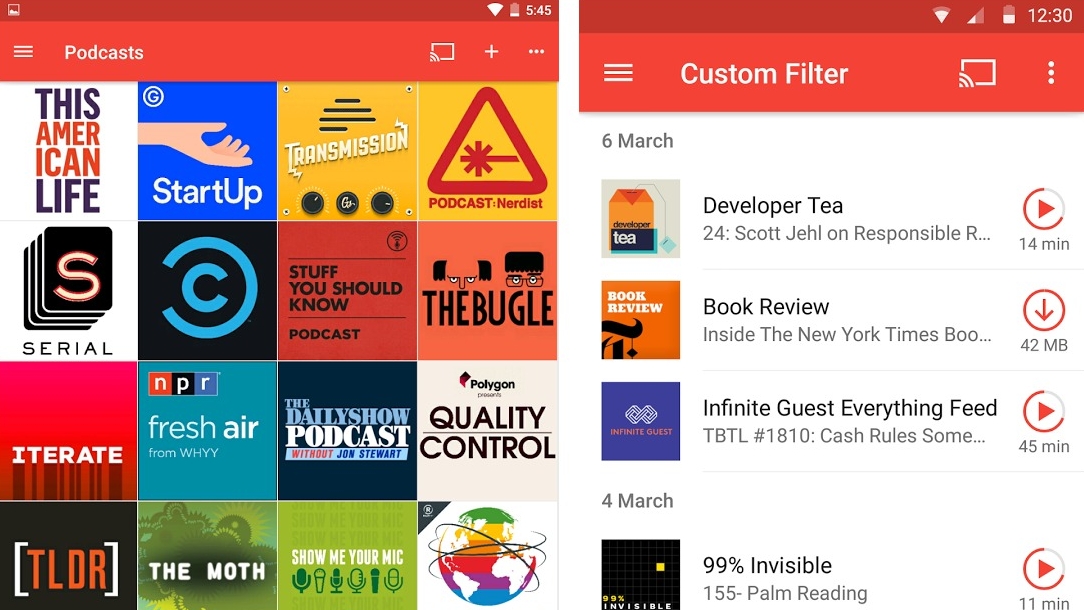
Pocket Casts
$3.99/£3.99
There are any number of podcast apps for Android but Pocket Casts is easily one of the best. Its slick, colourful interface helps it stand out from the drab designs of many competitors and it's feature packed, with Chromecast support, auto downloads, sleep timers and more.
There are even tools to improve the listening experience of podcasts, such as the ability to remove silent sections to speed them up or toggle video podcasts to audio only. There are cheaper and even free alternatives to Pocket Casts, but you more than get your money's worth with it.
Our favorite Android apps for taking notes, writing and editing documents and generally working on the move.
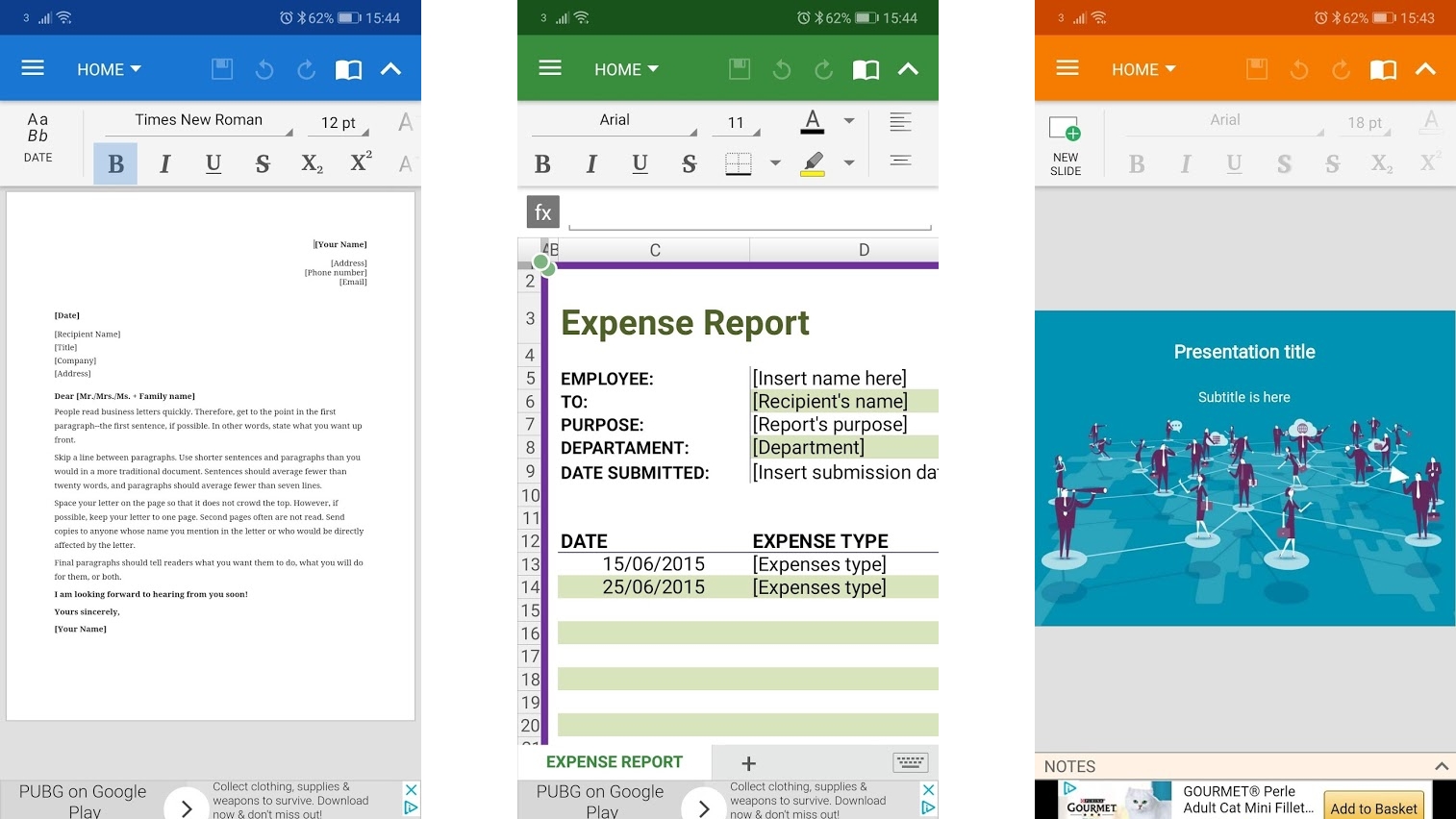
OfficeSuite
Free + £8.49 (around $11.10) IAP
If you’re looking for office software on Android there are really only a handful of options, and OfficeSuite is one of the best, thanks largely to how feature-packed it is.
You can create documents, spreadsheets, presentations or PDFs, and you can start from scratch or use one of numerous templates as a jumping off point.
You can share documents and message contributors, save work to the cloud, open two documents and work on them both at once in split-screen, cast presentations across multiple devices, and a whole lot more.
Most of the features in OfficeSuite are totally free, but if you’re using it a lot it’s probably worth upgrading to OfficeSuite Premium, which, among other things, lets you save files in more formats and unlocks more PDF tools, such as the ability to convert PDFs to Word or Excel format, and create and use digital signatures.
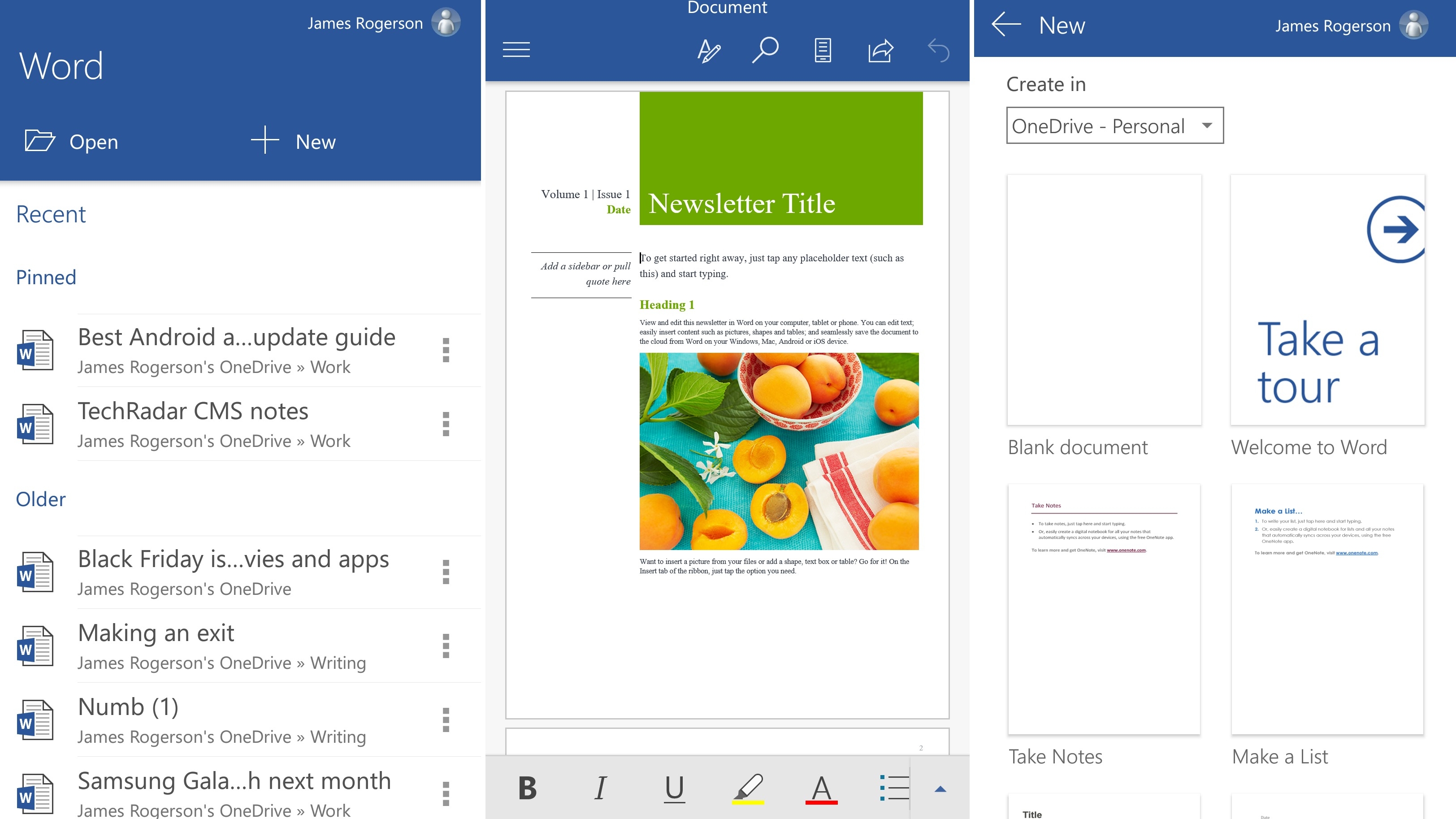
Microsoft Word
Free + $6.99/£5.99 monthly subscription
Microsoft Word probably needs no introduction, but if you do much word processing on your tablet (or even your phone) and haven’t tried the Android app then you really should.
You essentially get the full version, allowing you to view, create and edit documents of various styles, including newsletters, brochures and more.
You can change the font, text color, margins, add bullet points and most other things possible from the desktop version of Word, via a slick, polished interface that’s pleasingly minimal most of the time. You can also save your documents to OneDrive, so they’re accessible from other devices.
Many of the features are free, but you’ll need an Office 365 subscription (which starts at US$6.99/£5.99 per month) to unlock the likes of page and section breaks, columns, different page orientations, and the ability to track and review changes.
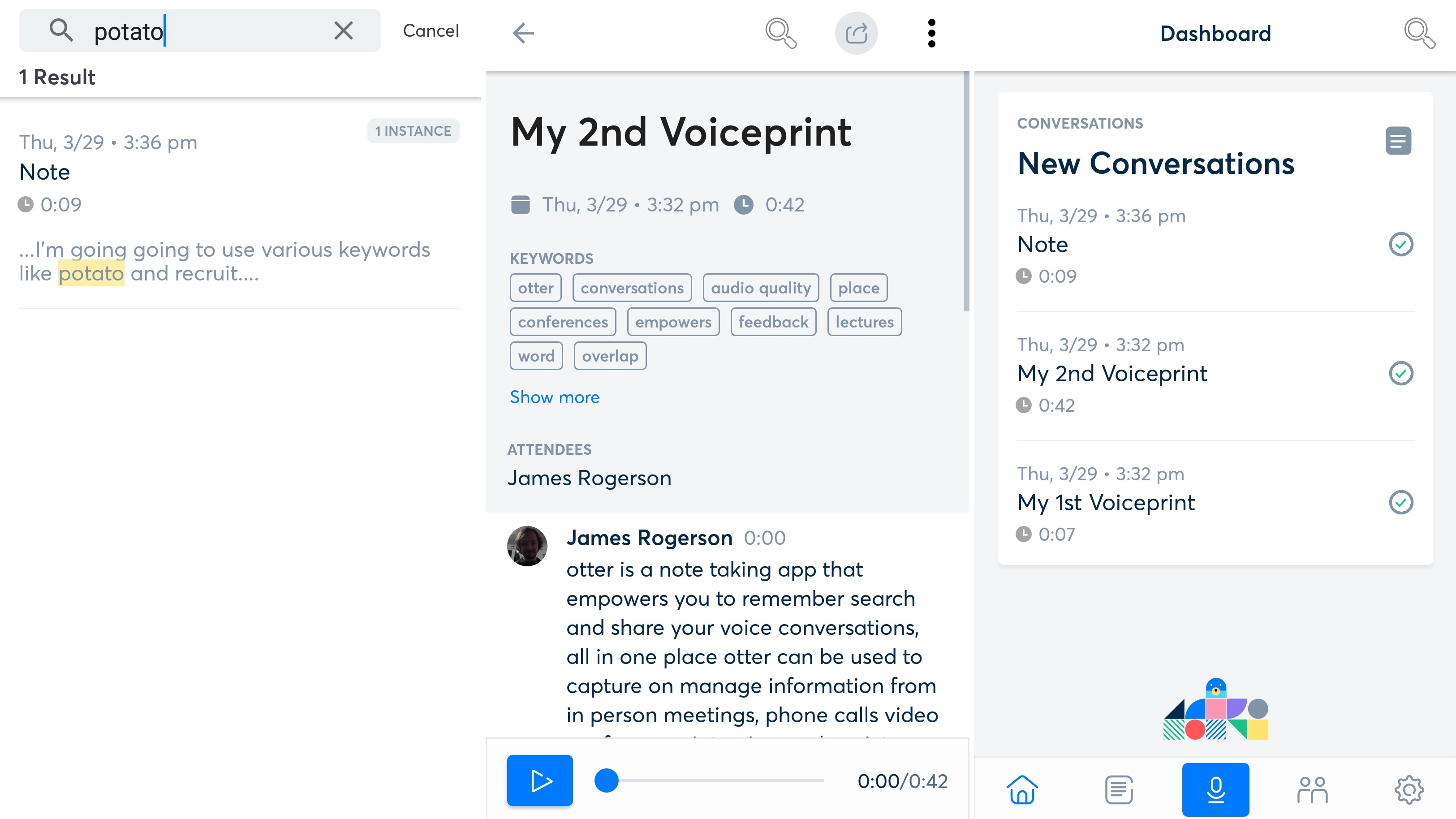
Otter Voice Notes
Free + optional subscription
Sometimes you don’t have time to take notes. Recording audio can come in handy, but often means spending time transcribing it later. Not so with Otter Voice Notes.
The app will automatically transcribe what’s spoken using AI, and you can teach it to recognize your voice so it can differentiate between speakers.
Once the audio is transcribed you can read it and correct any mistakes manually. The audio is also recorded, so you can listen back to the recording as well.
The really clever bit though is that Otter will detect keywords automatically, so you can search for a word and the app will find where it appears in any of your recordings. It’s a great feature that makes it easy to find specific information, even if you’ve recorded hours of audio.
You can also create groups, allowing you to share recordings with others, and all of your recordings are stored in the cloud so you can access them on any device and they won’t take up space on your phone.
The only two problems we’ve found so far is that longer recordings can take a while to be transcribed, and the transcription isn’t always perfect. It’s usually good enough that you can tell what it means though, and you can correct any errors so it’s not a big deal.
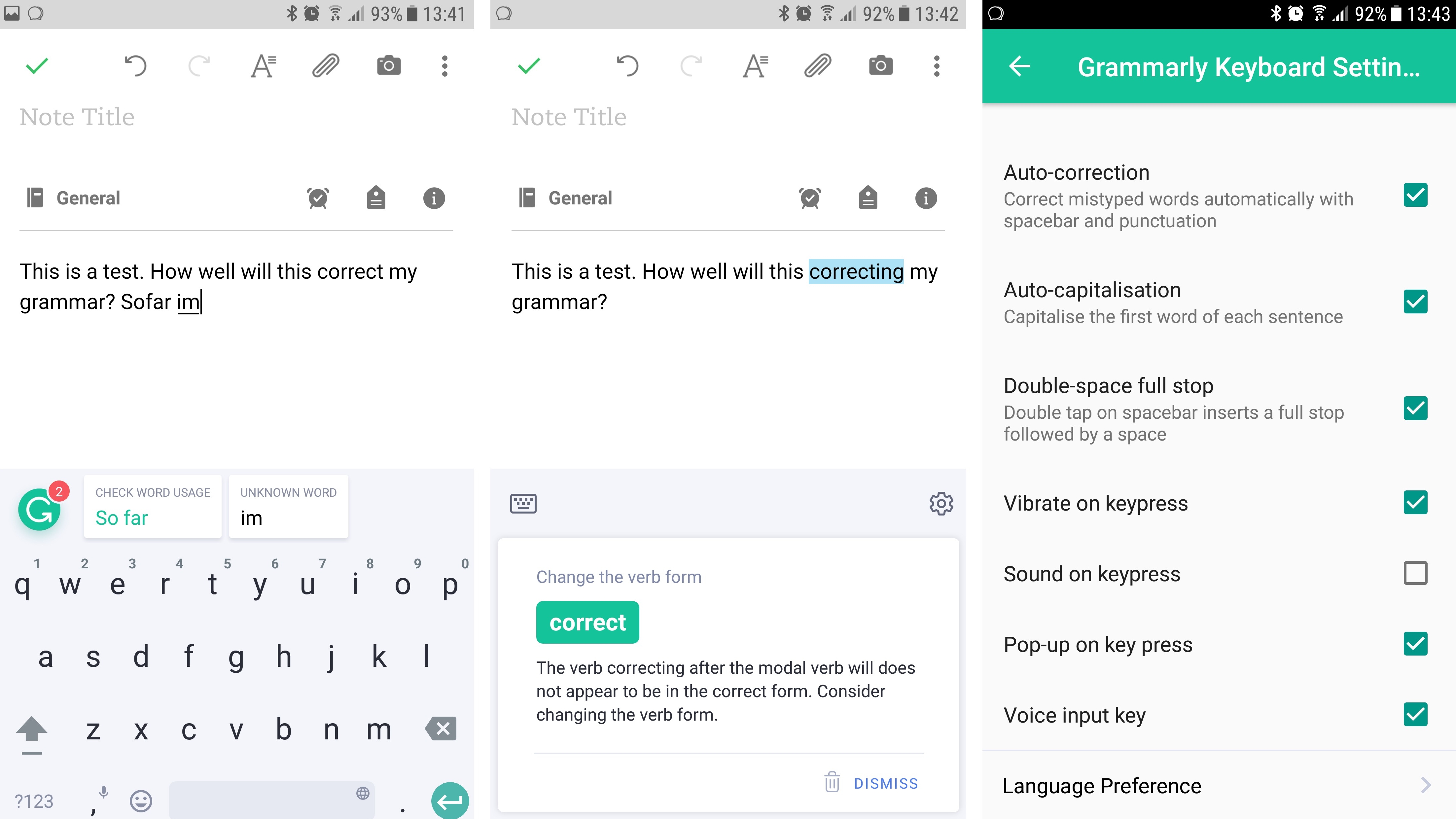
Grammarly Keyboard
Free
Grammarly Keyboard goes far beyond just auto-correcting typos; it will also check your grammar and punctuation, explain any mistakes and correct them.
Start typing and Grammarly will check the text automatically, flagging any issues. You can tap on a correction to apply it, or on an icon to the left for an explanation of why what you’ve written is wrong, which can help you avoid making the same mistake again.
That aside, Grammarly is a fairly standard touchscreen keyboard, with a handful of settings, such as whether or not you want the keys to vibrate when pressed, and whether you want the first letter of a sentence to be capitalized automatically. It works well and feels as accurate as most other Android keyboards – just with the addition of extra grammar checks.
It isn’t perfect – it missed when we wrote the same word twice in a row and didn’t seem too picky about where commas were placed – but it flags more than most keyboards will, so if you care about the accuracy of what you type it’s well worth checking out.
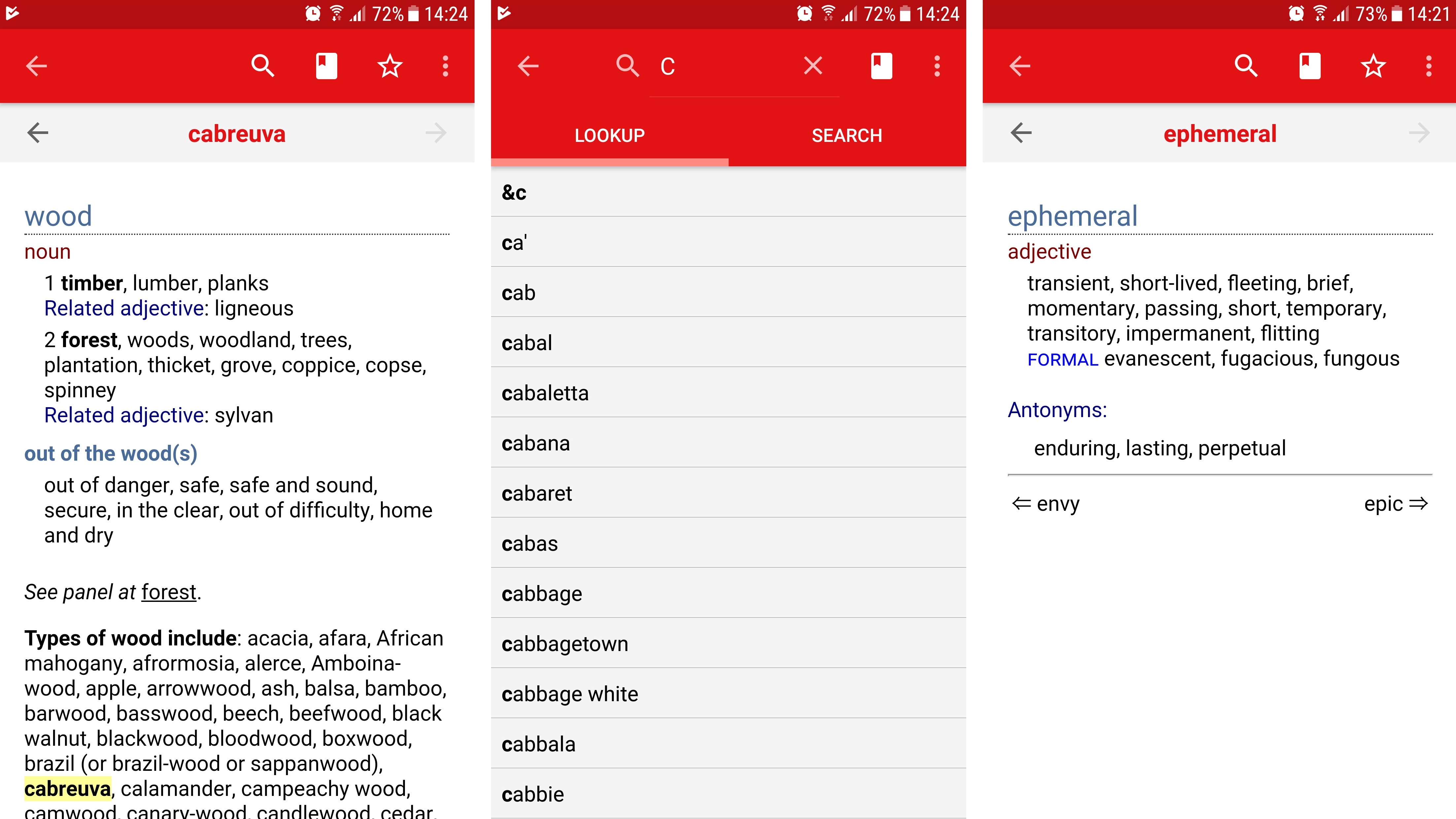
Chambers Thesaurus
$4.99/£2.99
There are a number of thesaurus apps on Google Play and some are free, but if you’re regularly writing – or looking words up – on your Android device, then Chambers Thesaurus is one of the best options, and worth the outlay.
It has entries for almost 40,000 words, along with around 400,000 synonyms and antonyms, and they’re browsable alphabetically so you can read through the thesaurus if you want, rather than simply searching for a word.
When you do search, you’ll get results as soon as you start typing, and not just for words that fit the spelling, but also similarly spelt words, those that sound similar, and those that are often confused for one another.
You can also bookmark entries and cross reference with the Chambers Dictionary or WordWeb apps (if you have them), or look the words up on Wikipedia, Wiktionary or Google, all with a tap from Chambers Thesaurus.
Data is stored locally, so you don’t need an internet connection to use the Chambers Thesaurus app itself, and there are all sorts of customization options, letting you change the color scheme, font size and more.
Our favorite Android apps for improving productivity, whether through to-do lists, focus timers or other tools.
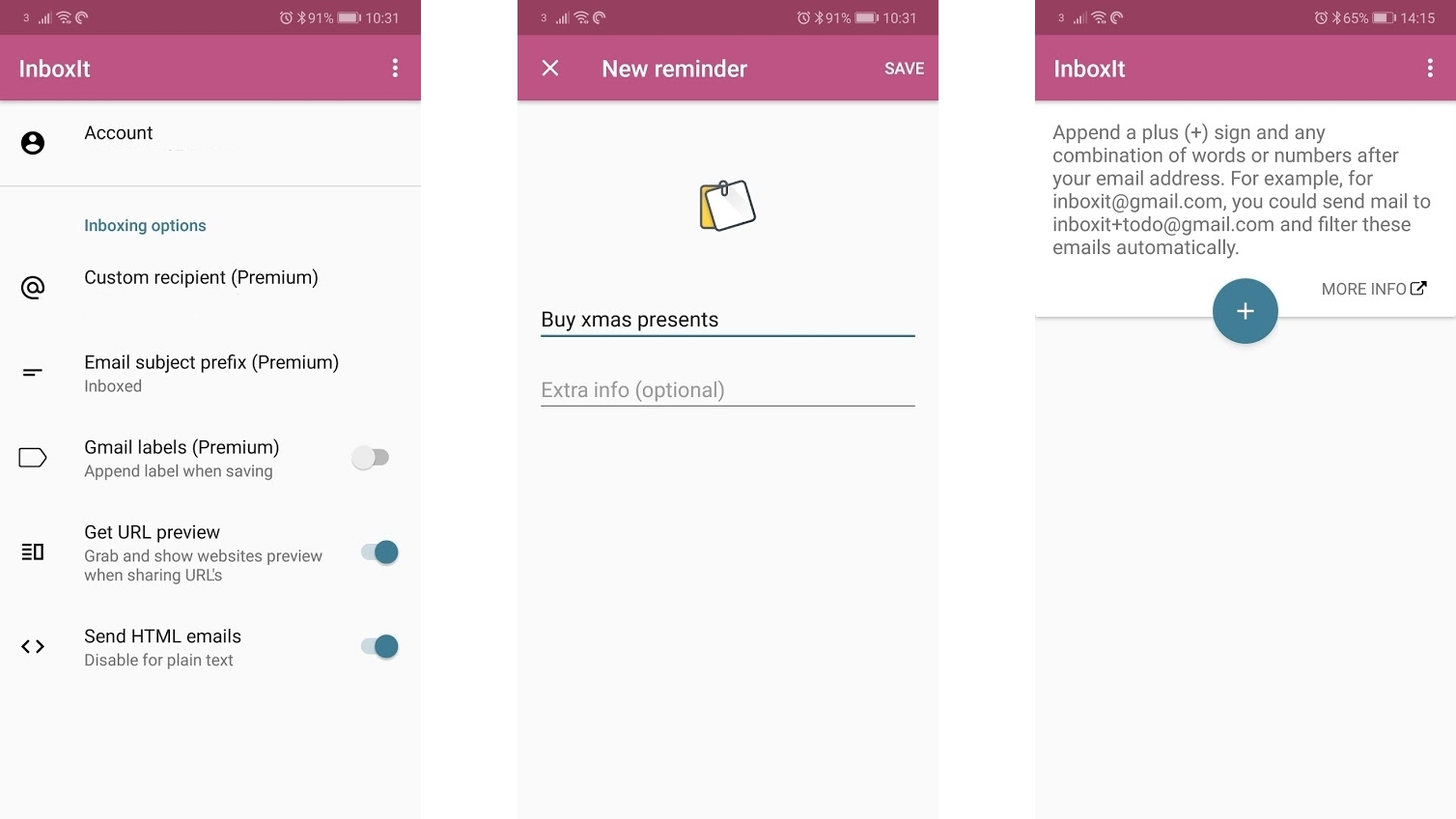
InboxIt
Free + $0.99/£0.99 IAP
InboxIt is a simple but potentially very useful app, especially if you ever email things to yourself, as rather than having to manually attach content to an email and enter the address to send it to, you can just share the content with InboxIt.
Once shared, the content will automatically be sent to your Gmail inbox, and the app supports lots of different content types, including images, website links, text and just about anything else that works with the Android ‘Share’ function. You can also send yourself reminders from within the InboxIt app.
For example, perhaps you want to access an image or file that’s stored on your phone from another device. There are other ways to do that and depending on what other apps and services you use they might in some cases be even more seamless. Google Photos, for example, gives you constant access to all your images on all your internet-connected devices, but we certainly still find occasion to email ourselves, and if you do too then InboxIt is essential.
Everything we’ve detailed so far is completely free, but you can also upgrade to Premium with a one-off $0.99/£0.99 IAP, which lets you set a custom recipient (the free version only supports Gmail), set a custom email subject prefix (the default being ‘Inboxed’), and use Gmail labels.
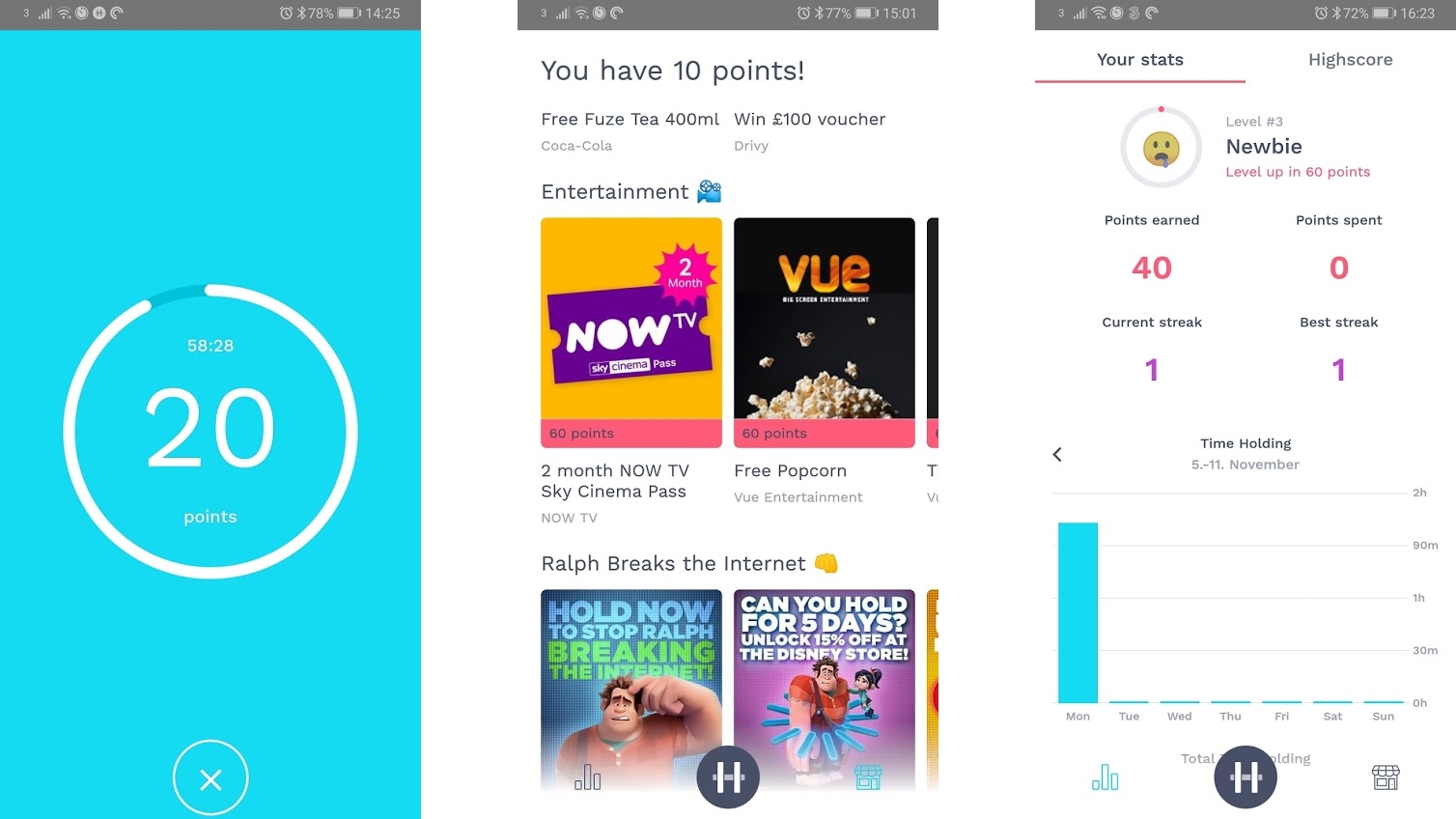
Hold
Free
There are all sorts of apps designed to help you waste less time on your phone, but while most gamify the process with digital rewards such as growing a virtual tree, Hold gives you real-world rewards with monetary value.
Simply put your phone ‘On Hold’ and it will display a timer counting up, along with a point count. For every 20 minutes that you don’t use your phone, 10 points will be added to your count.
When you start using your phone again your total will be banked, so you can gradually save up based on periods of inactivity. When you have enough points you can cash them in for various rewards, including things like a free coffee at a participating store, a discounted cinema ticket or a free subscription to a streaming video service.
You can also compete with friends on a leaderboard, seeing who can acquire the most points over a set period.
If you find yourself more distracted by your phone than you’d like then Hold could make a real difference, but even if you don’t it’s worth having for the rewards that you can work towards.
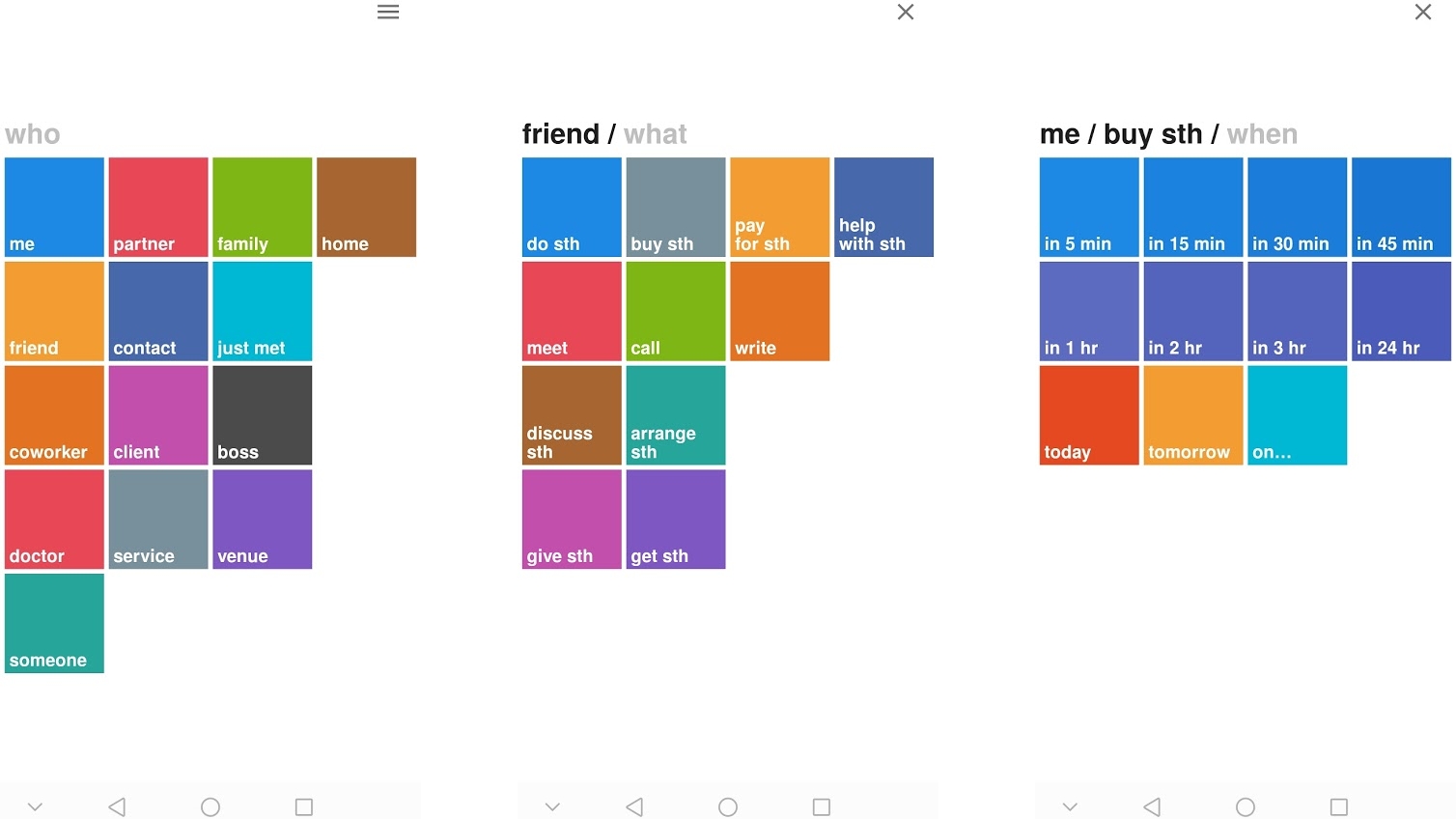
Three.do
Free + $10/£6.99 yearly subscription
Three.do is an app that aims to make setting reminders as speedy and simple as possible. It does this by condensing any reminder to three taps.
First, you select the ‘who’, which is the person to whom the reminder relates - for example you, a family member or a friend. Simply tap a box containing the most relevant one and you’ll get to the ‘what’.
Here you get a series of verbs like ‘call’, ‘write’ or ‘meet’. Tap on one of those and finally you get the ‘when’, with boxes for a range of times from five minutes to tomorrow. Alternatively, you can tap the ‘on’ box to bring up a calendar. Once all three boxes have been filled, the reminder is set and the app automatically closes itself, saving you a fourth tap.
Of course, as you’ve probably realized, this is only good for setting very vague reminders, but Three.do’s developer acknowledges that. It also argues that we don’t usually forget the specifics, but rather need reminding do something at all. So if you need to buy pet food, for example, then a reminder to ‘buy something’ may well be all you need.
That said, it is possible to enter more details, as rather than tapping a box you can enter text, though at this point the app won’t be much faster than a standard calendar or reminder app.
Three.do is mostly free, but you can subscribe to the pro version for $10/£6.99 per year, which will let you do things like save reminders to Google Calendar, set up repeating reminders and create your own ‘who’/’what’ options.
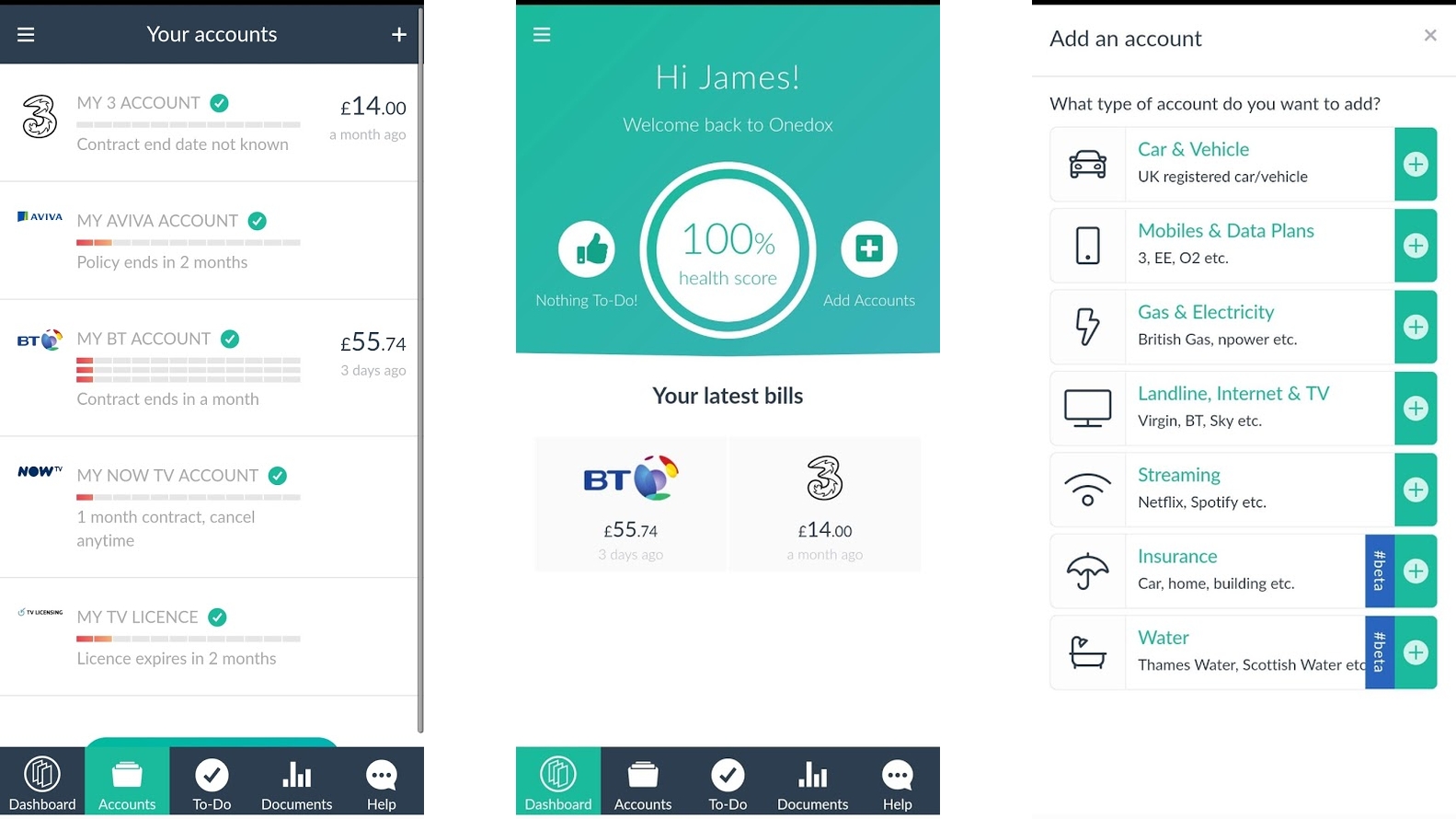
Onedox
Free
Chances are you have many different bills to pay each month, with different companies and for different amounts, which can make it hard to keep track of how much you’re actually spending. Coupled with varied renewal dates and price changes, it can be hard to keep track; Onedox aims to simplify things.
The app lets you link your accounts, covering everything from gas and electricity to TV, internet to mobile phone, and car insurance to streaming services.
Once you’ve got everything linked up, you’ll be able to see all your bills in one place, complete with how much you’re paying for each and when they’re up for renewal.
You can also see previous bills, charts tracking price changes, and access parts of your online account for each service direct from the app, as well as being able to add notes.
It’s a great idea but the implementation isn’t yet perfect, as it’s UK-only and currently not all companies are supported, but Onedox is consistently improving.
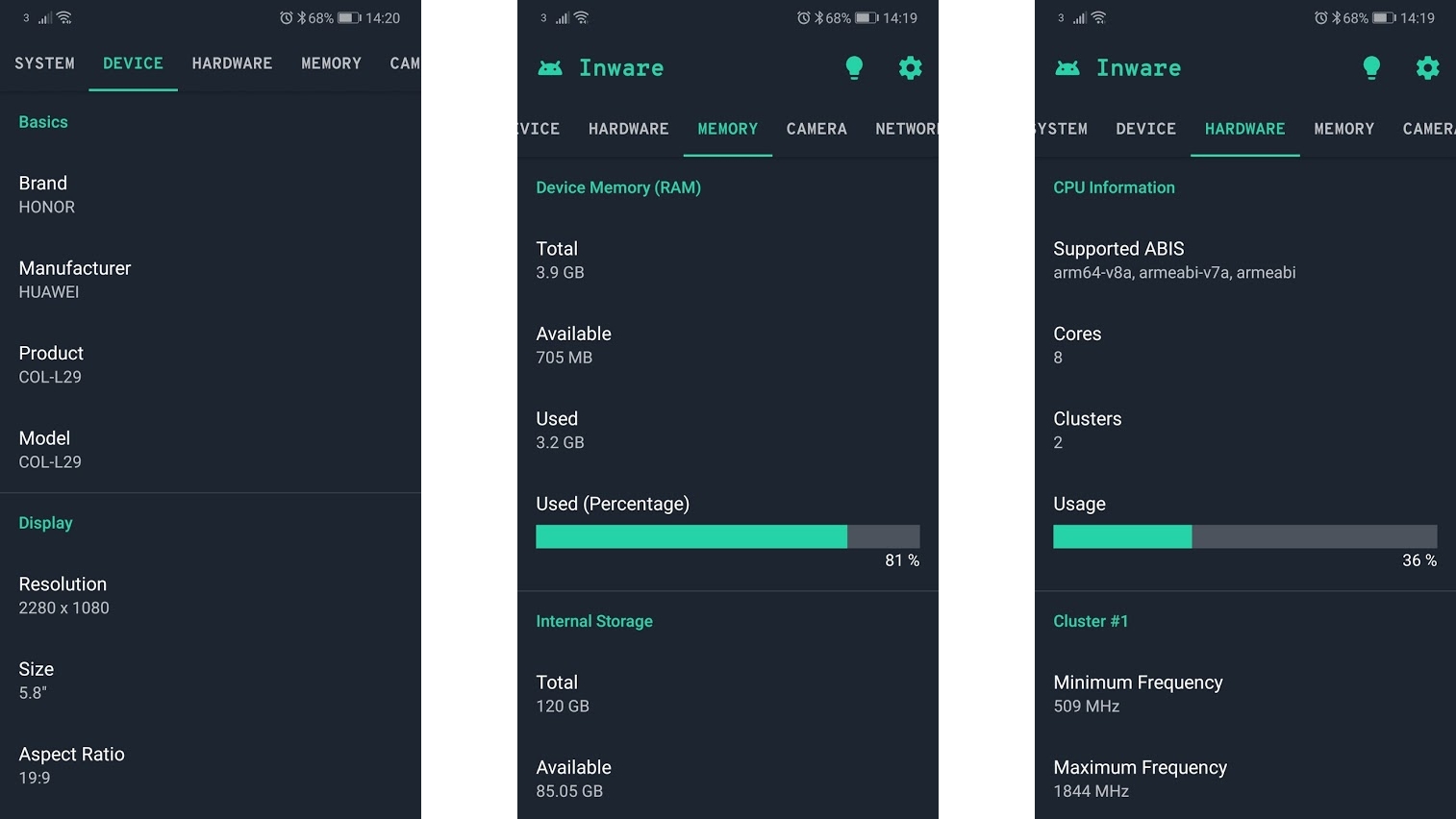
Inware
Free
Inware is a very simple but potentially very useful app that gives you a deep-dive into the specs of your phone.
It will tell you not just basics like the chipset, RAM amount, current Android version, battery capacity, screen size, screen resolution and camera megapixel count of your phone, but also more advanced stuff.
It can show you the maximum and minimum frequency of each CPU cluster, the current speed of each core, the Android version the phone shipped with, the health of the battery, the aperture of each camera lens, the aspect ratio and pixel density of the screen, whether or not HDR is supported, whether Treble and Vulkan are supported, and more besides.
In short, if there’s something you want to know about the specs of your phone, chances are Inware can tell you.
It’s also very easy to navigate, splitting the specs into a handful of screens, such as ‘memory’ and ‘camera’.
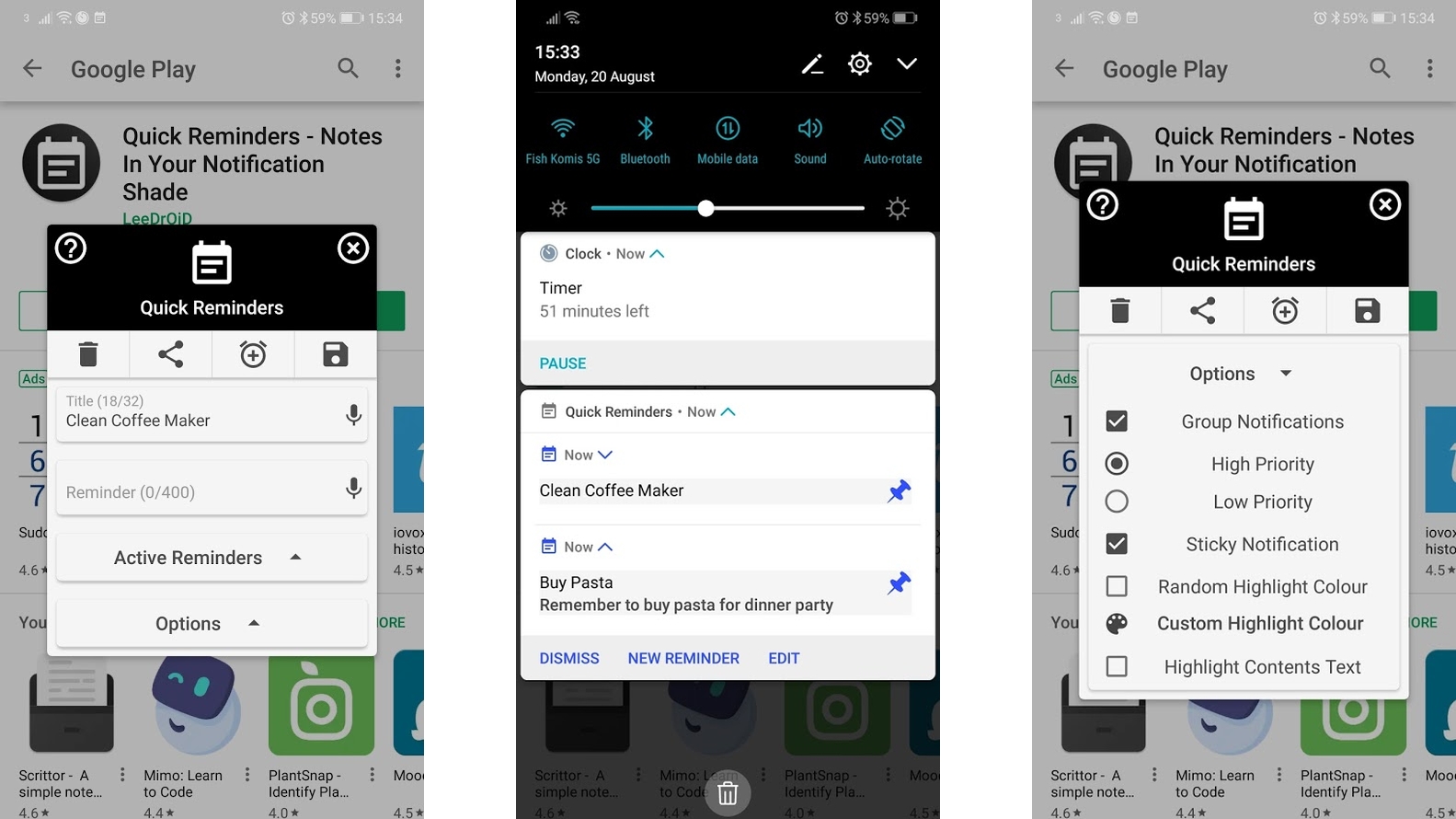
Quick Reminders
$0.99/£0.59
Quick Reminders is a simple but potentially very useful app that lets you pin reminders to your notification shade, so they’re always visible.
You can create a title for the reminder, and if it needs more information you can also add extra text that’s collapsible, so it’s only visible with an extra tap.
You can set a date and time for the reminder (or just have it instantly appear), customize the color it’s shown in, and you can have multiple reminders shown at once. It’s also possible to edit or delete a reminder or create a new one just by tapping the relevant option in the notification shade.
Quick Reminders is fast and simple to use, living up to its name, and if you use reminders a lot it’s a handy alternative to standard calendar reminders.
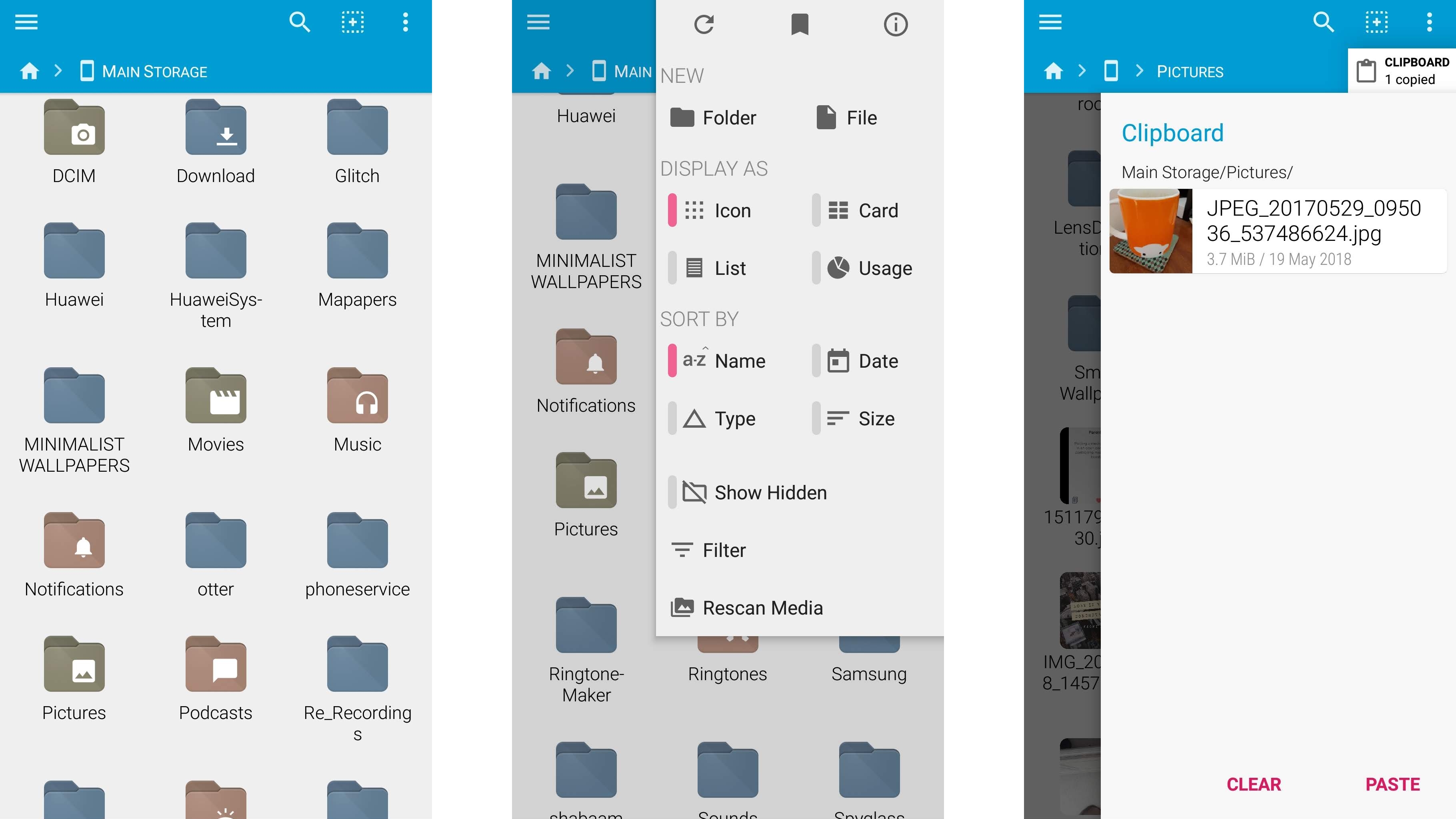
FX File Explorer
Free + $2.99/£2.79 IAP
FX File Explorer isn’t new – in fact, at the time of writing it’s recently been updated to version 7 – but that just shows you how well-supported it is, and it’s worth being aware of if you’re not already, especially as the version 7 update improves it significantly.
It’s a powerful file explorer and manager, with all the tools you’d expect, such as the ability to browse your files and folders, move or copy them, rename them, create new ones, sort them by their name or date and see which things are taking up the most space on your phone.
It goes beyond many rivals, offering things like a split-screen mode, which lets you view multiple folders at once. There are also gesture controls, customizable themes and more.
Most of the features in FX File Explorer are free too, but for US$2.99/£2.79 you can connect your cloud storage accounts and networked computers, create and explore encrypted ZIP files, and manage playlists for audio files.
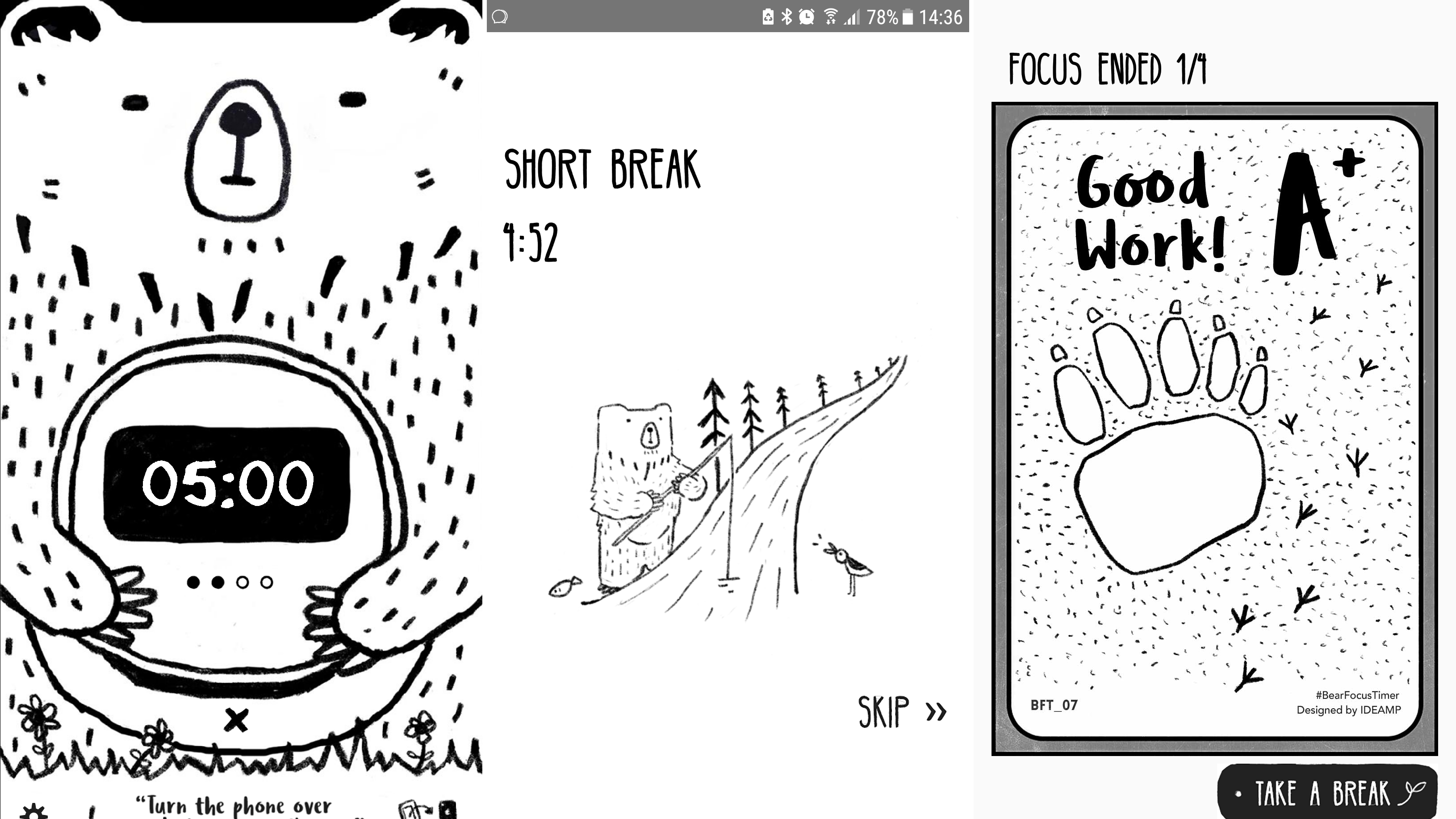
BFT - Bear Focus Timer
$1.49/£0.69
BFT - Bear Focus Timer is one of a number of apps designed to keep you off your phone, so you can stay focused on work or whatever else you need to be doing, but it stands out due to its seriously cute art.
This takes the form of a handful of black and white drawings starring a bear named Tom. On the main screen of the app you’ll see him with a timer on his belly. Place your phone face down to start the timer and then if you turn if face up again the timer will pause, and Tom will look at you angrily. Make it to the end of the timer and you’ll get a short break during which you’ll see Tom fishing.
You can customize the length of the timer and of your breaks, but it’s based on the Pomodoro Technique – a focus technique which involves periods of productivity broken up by short breaks, and eventually a longer break.
BFT – Bear Focus Timer is quite basic really, so it’s the presentation that you’d be buying it for, but it does have a few extra features, such as the ability to play background sounds (such as the noise of a river or a crackling log fire) while the timer counts down.
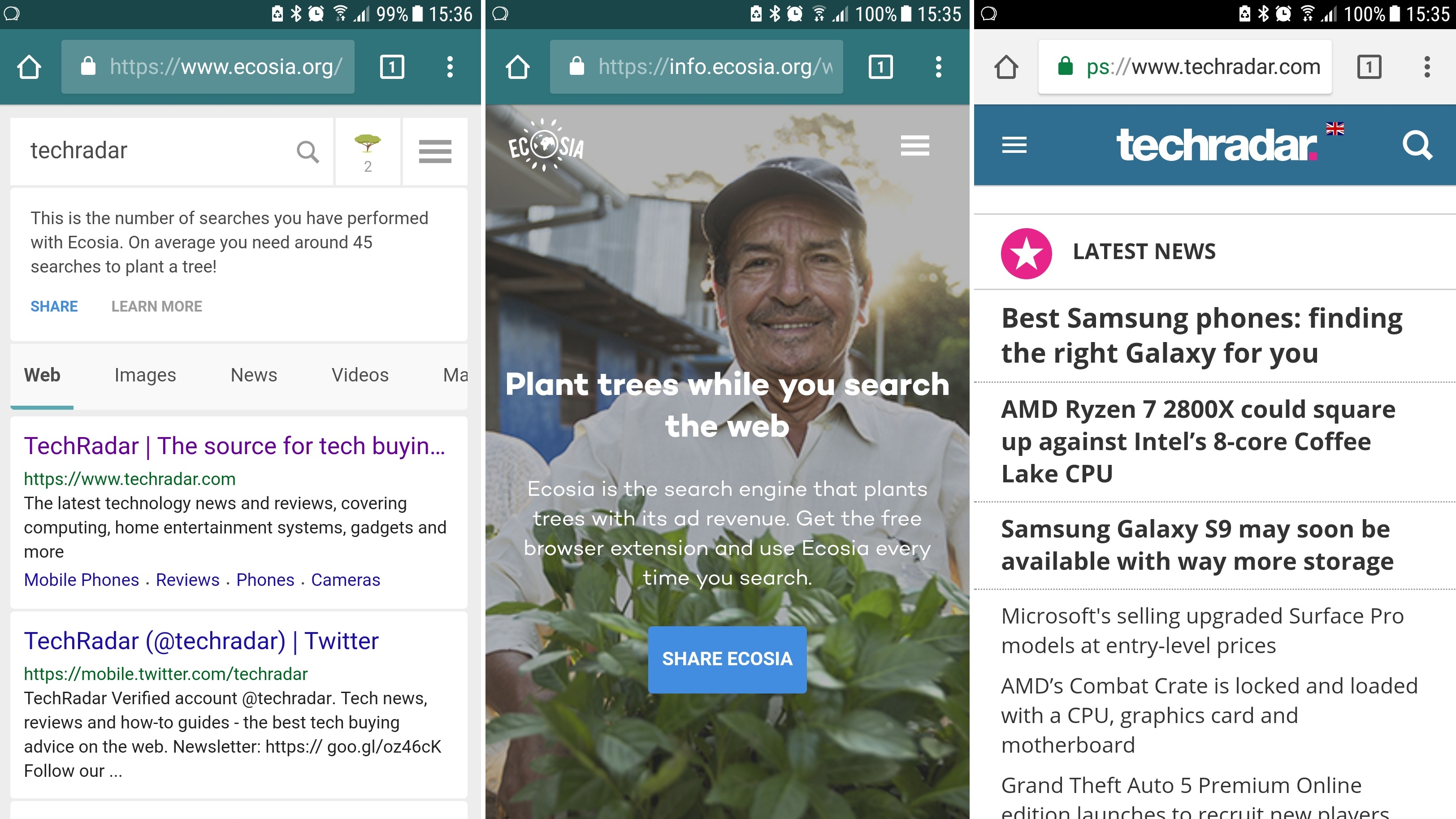
Ecosia Browser
Free
Fancy saving the world one web search at a time? With Ecosia Browser you can, as it uses the ad revenue it makes to plant trees. In practice that means one tree is planted for roughly every 45 searches you make, so you’re not going to be planting forests on your own, but every little helps, and in total Ecosia has now planted over 26 million trees.
But that’s just the beginning, as it aims to plant a billion trees by 2020 and it needs more users to do that.
Beyond letting you make a difference without looking up from your phone, Ecosia is also a polished browser. It’s based heavily on Chrome, sporting a similar look and features, so if that’s your current browser you should feel right at home.
Bookmarks, private browsing and tabs are all supported, as are auto-filling forms and credit card details. You can even enable a search bar on the notifications panel, so you don’t have to launch the app to get searching and get planting.
Our favorite Android apps for customizing your device and improving its security.
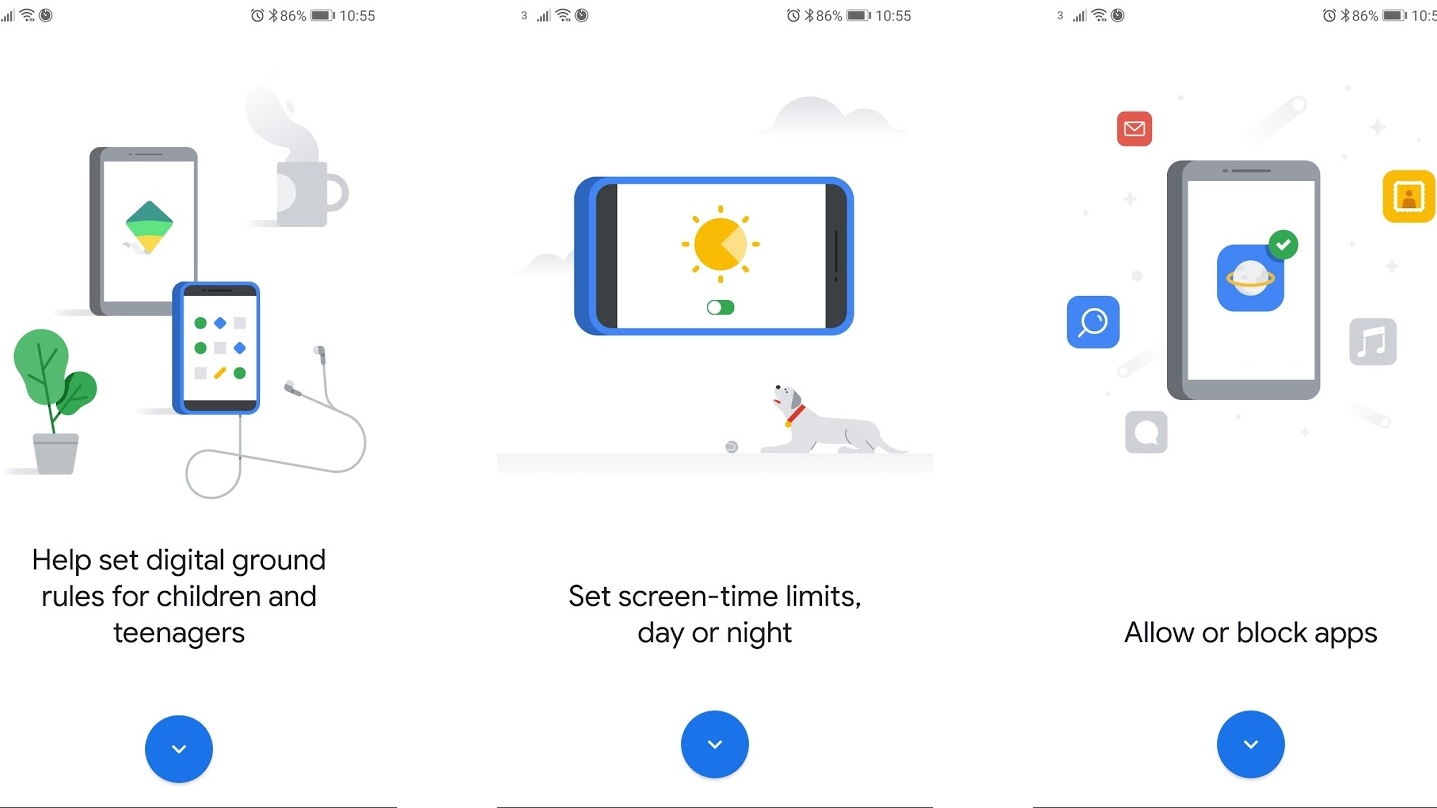
Google Family Link
Free
Google Family Link is an app aimed at helping you keep an eye on your child’s smartphone or tablet use.
The service, which actually requires two apps – one (Google Family Link for Parents) installed on your device, and the other (Google Family Link for Children and Teenagers) installed on your child’s – gives you all sorts of tools.
For one thing, you can choose which apps your child can access and install, either blocking specific ones or just preventing them from installing anything that you haven’t authorized. You can also see what apps they’re using at any given time, set screen time limits and lock the device when you don’t want them using it.
There’s also a feature that’s more about safety than monitoring, as you can also use Family Link to locate your child’s device at any time, so as long as they’re with it you’ll also have located them. There are other apps and services with a similar set of tools but few if any that are free while also being as feature-packed and polished as this.
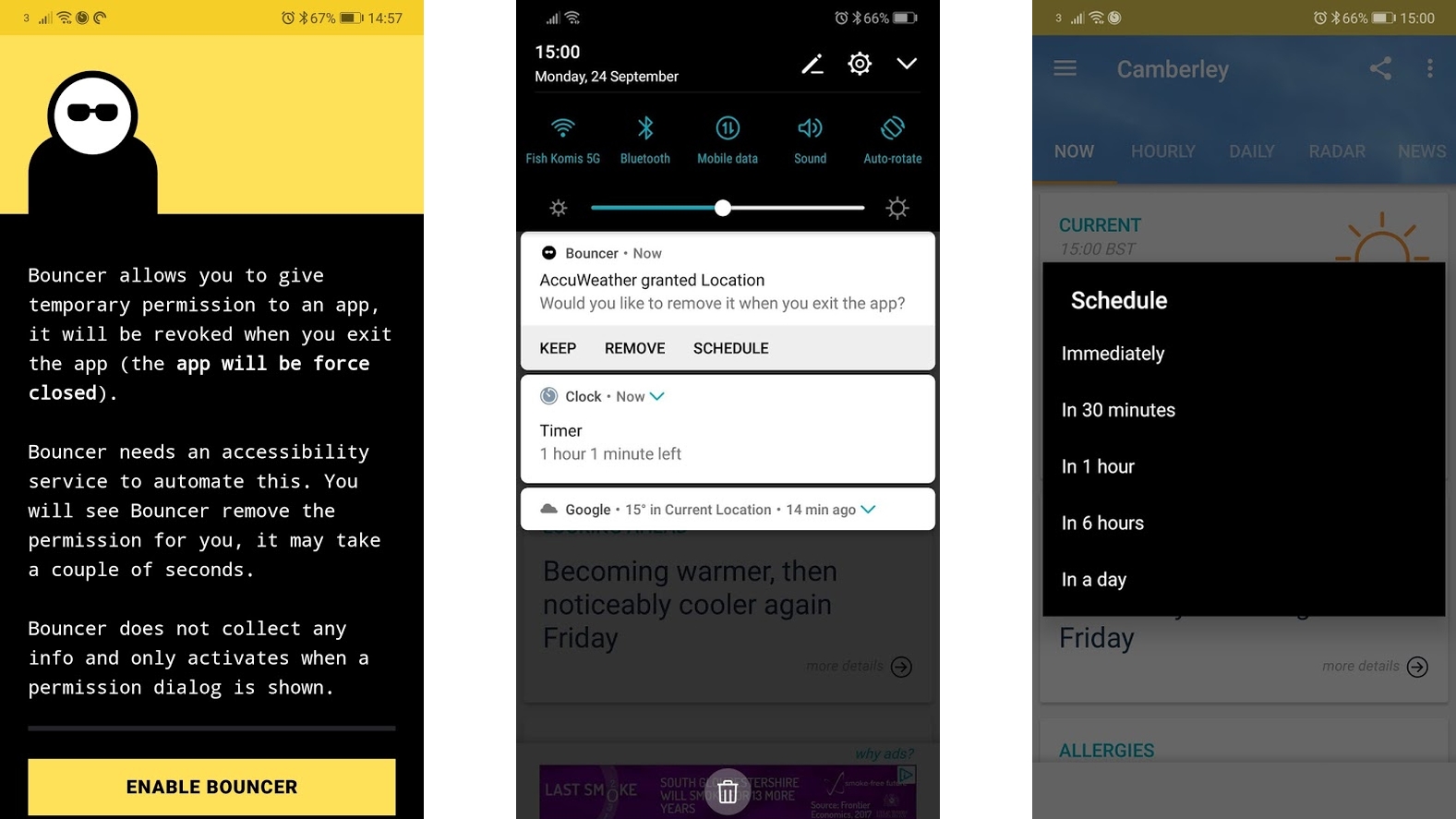
Bouncer – Temporary App Permissions
$0.99/£0.79
Some Android apps ask for a worrying number of permissions, and while you generally have to grant them in order to get full functionality, you might not want them to retain those permissions once you’re done using them.
Usually removing the permissions again would mean digging into your settings screen, but with Bouncer, any time an app requests a permission – say for your location, or microphone access – Bouncer will ask whether you want it to be able to keep the permission, have it removed as soon as you exit the app or have it removed after a certain amount of time.
It makes revoking permissions a lot less hassle, and next time you use the app you’ll get asked for the relevant permissions again and Bouncer will again ask what you want to do, meaning you can make full use of any app while adding and removing permissions almost seamless.
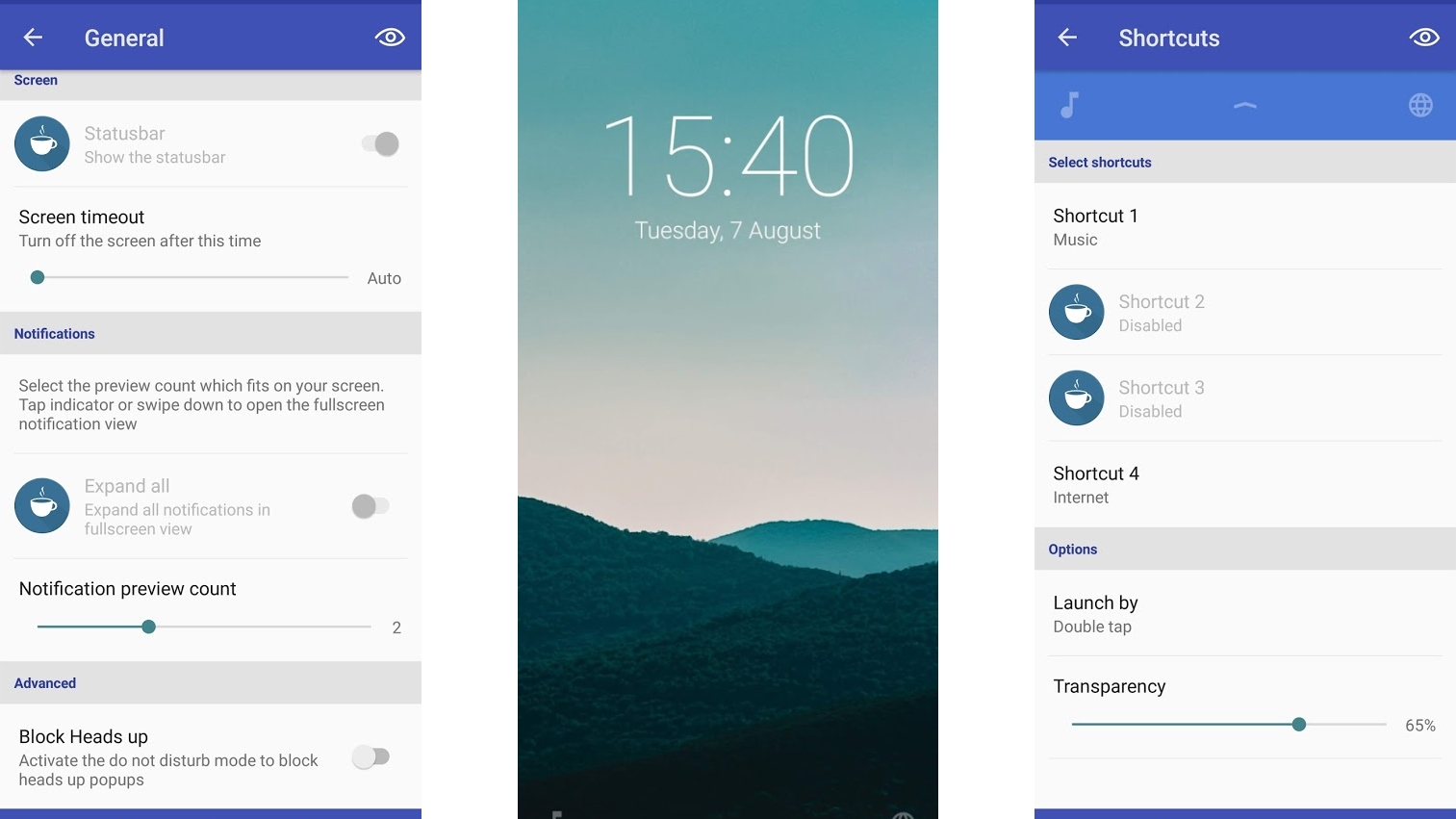
Ava Lockscreen
Free + $2.99/£2.19 IAP
Considering how customizable Android is in general, we’re constantly surprised by how few lock screen replacement apps there are, but Ava Lockscreen is a new and fairly accomplished option.
It lets you add widgets and custom shortcuts to your lock screen, reply to notifications from the lock screen, and customize various elements of it, such as the clock and notification style.
Much of the content is free, but for a one-off IAP you can unlock additional features, such as the ability to set more than two custom shortcuts and use more advanced widgets.
Ava also supports Android security, so you don’t have to disable your fingerprint scanner, PIN or whatever else to use it.
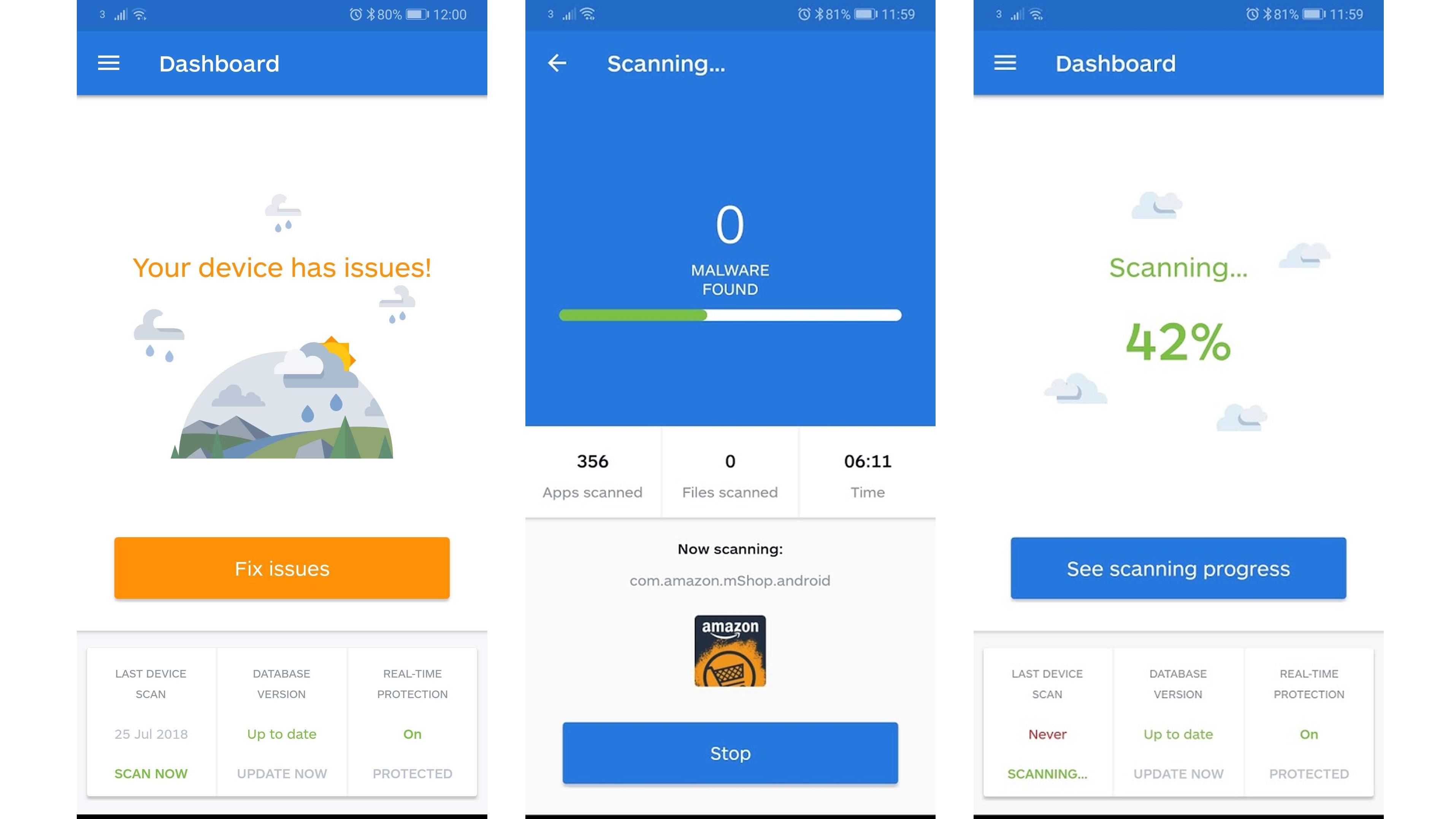
Malwarebytes Security
Free + $1.49/£1.19 monthly subscription
While there are various security features already built into Android, you can’t be too careful, so it’s well worth considering adding Malwarebytes Security to your app arsenal.
Malwarebytes can scan your device for viruses, adware and malware, but it also offers proactive protection, with real-time ransomware shields, protection from phishing URLs when using Chrome, alerts when there’s a malicious link in a text message, and the ability to block unwanted calls.
Malwarebytes can also conduct a privacy audit on your phone, showing you at a glance what privileges your apps have.
Most of these features are only available in the premium version, which costs $1.49/£1.19 per month or $11.99/£10.99 for a year, but you get a 30-day free trial and if you don’t want to pay you can still scan and clean your phone with the free version.
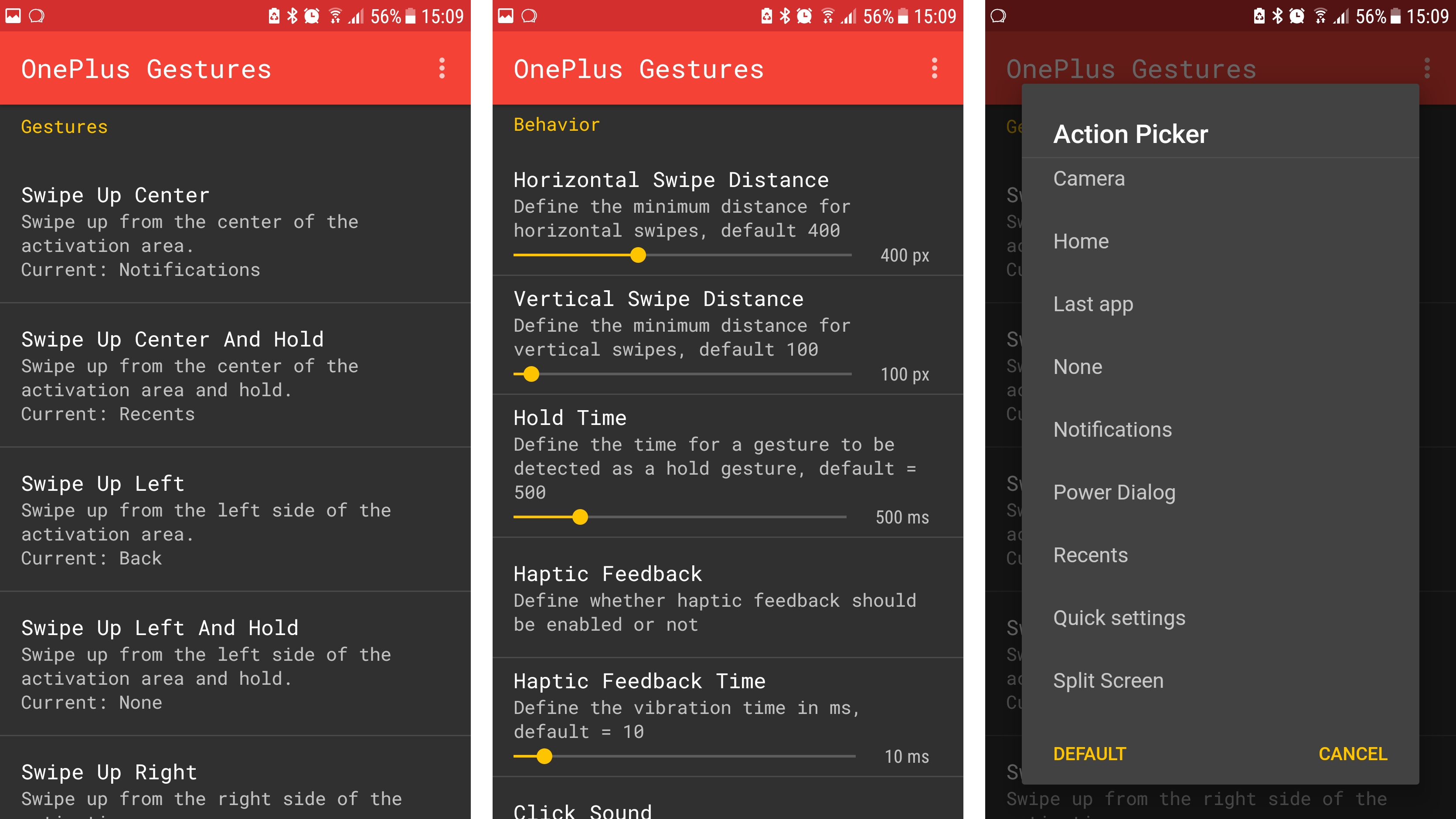
OnePlus Gestures – Gesture Control
$1.49/£1.39
Some phones have gesture controls, but if yours doesn’t you can add them with OnePlus Gestures.
This app (which is inspired by the gestures on OnePlus phones, but not made by OnePlus) lets you toggle up to eight different gestures, each of which involves swiping up, left or right in a certain area of the screen to act as a shortcut to an app or function of your choice.
You could, for example, launch the camera by swiping from the bottom of the screen halfway up and holding, or switch to your recent apps screen by swiping up from the center.
In our tests the gestures were easy to trigger, but if you’re having issues with them you can tweak the swiping distance and hold time, the size of the activation area (where you need to start the swipe from), and even make the activation area visible.
We’d like to see an even wider assortments of possible gestures, but what’s here works well, and can genuinely save you time when navigating your phone.
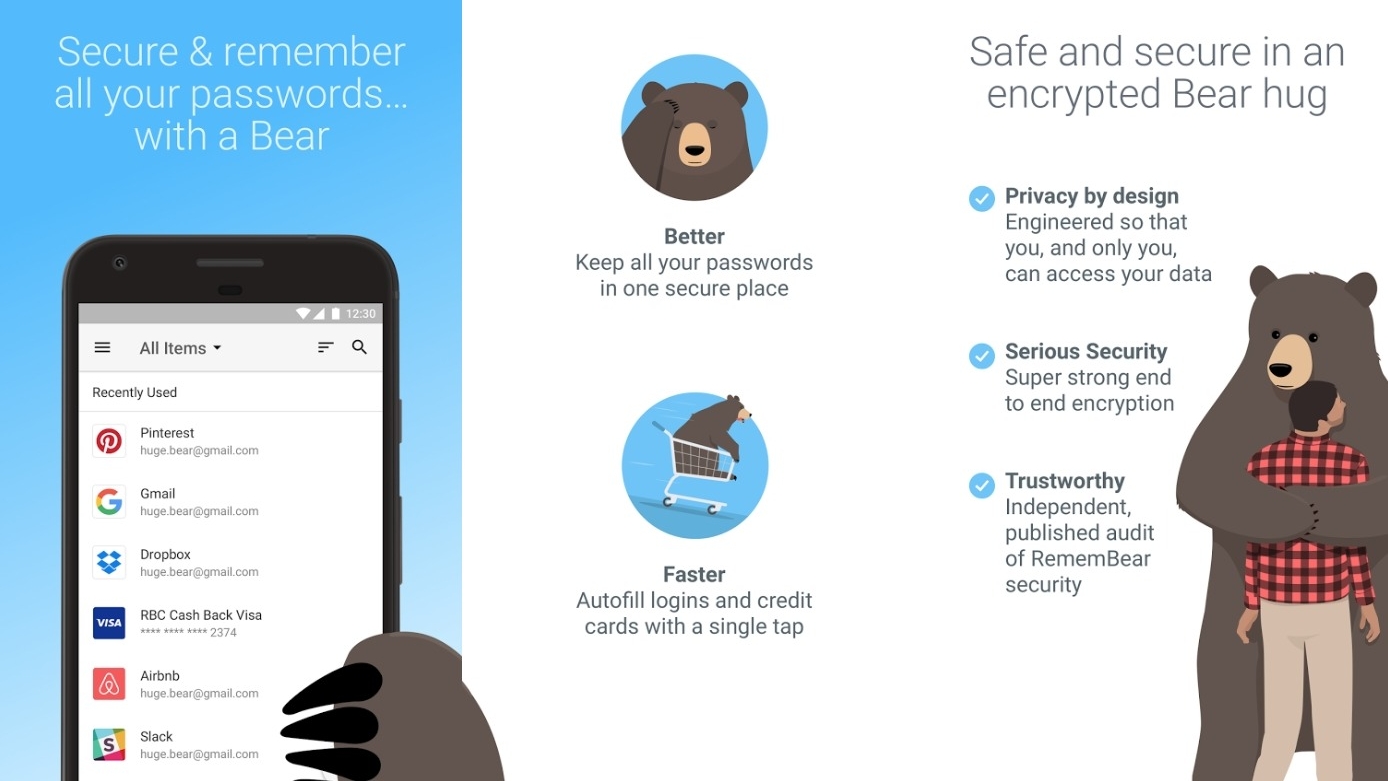
RememBear
Free or $35.99/£32.49 per year
There are plenty of password managers, but most of them don’t have bears. RememBear (by the makers of TunnelBear) puts a friendlier, less dry spin on password management, but it’s good where it counts too, offering end-to-end encryption and autofill, so you can securely store all your passwords in the app and never have to remember or type them.
The app itself is secured with a master password, with the option to add a fingerprint. It’s not just for logins either - you can also store credit card details.
Struggling to think up a secure password for a new login? RememBear can do that for you. It’s also got a web browser for an extra layer of security when you’re browsing the net.
RememBear is also available on PC, Mac and iOS, and the core app is free, but to sync your data across devices you'll need to subscribe to RememBear Premium for $35.99/£32.49 per year. Handily it comes with a 30-day free trial.
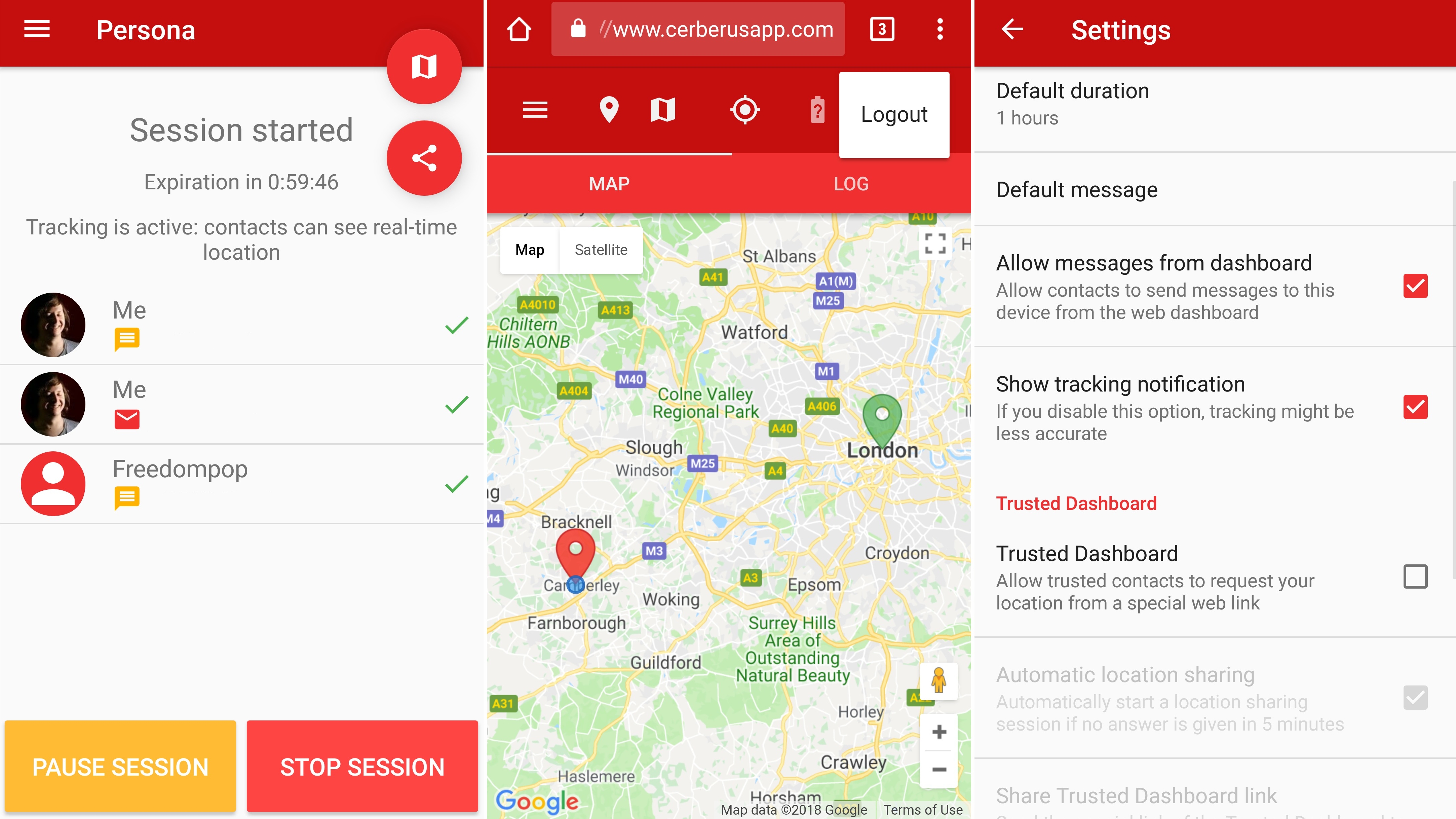
Cerberus Personal Safety
€5 (around $6.20/£4.50) per year
Cerberus Personal Safety (also known as Persona) is a simple but potentially very useful app. It allows you to share your real-time location with friends or family, letting them see where you are and optionally also your destination for as long as you want.
Send your contacts a link via email, text, Twitter or Facebook and they’ll be able to see where you are on a map. The map opens in a web browser, so they don’t need the app installed to use it.
You can share links with individual contacts or with groups, and set up home screen widgets to share your location with a single tap – which could be ideal if you get in an accident and need to quickly tell people where you are. You can also share your location via Android Wear, and anyone viewing your location can message you from the map screen.
When you don’t want to share your location any more, you can disable it, though it also stops automatically after a duration set by you.
Cerberus Personal Security comes with a one week free trial, after which it costs €5 (around $6.20/£4.50) per year, but that includes access to the powerful Cerberus Anti Theft app, which we’ve written about before, so Cerberus Personal Safety is essentially free if you already have a subscription to that.
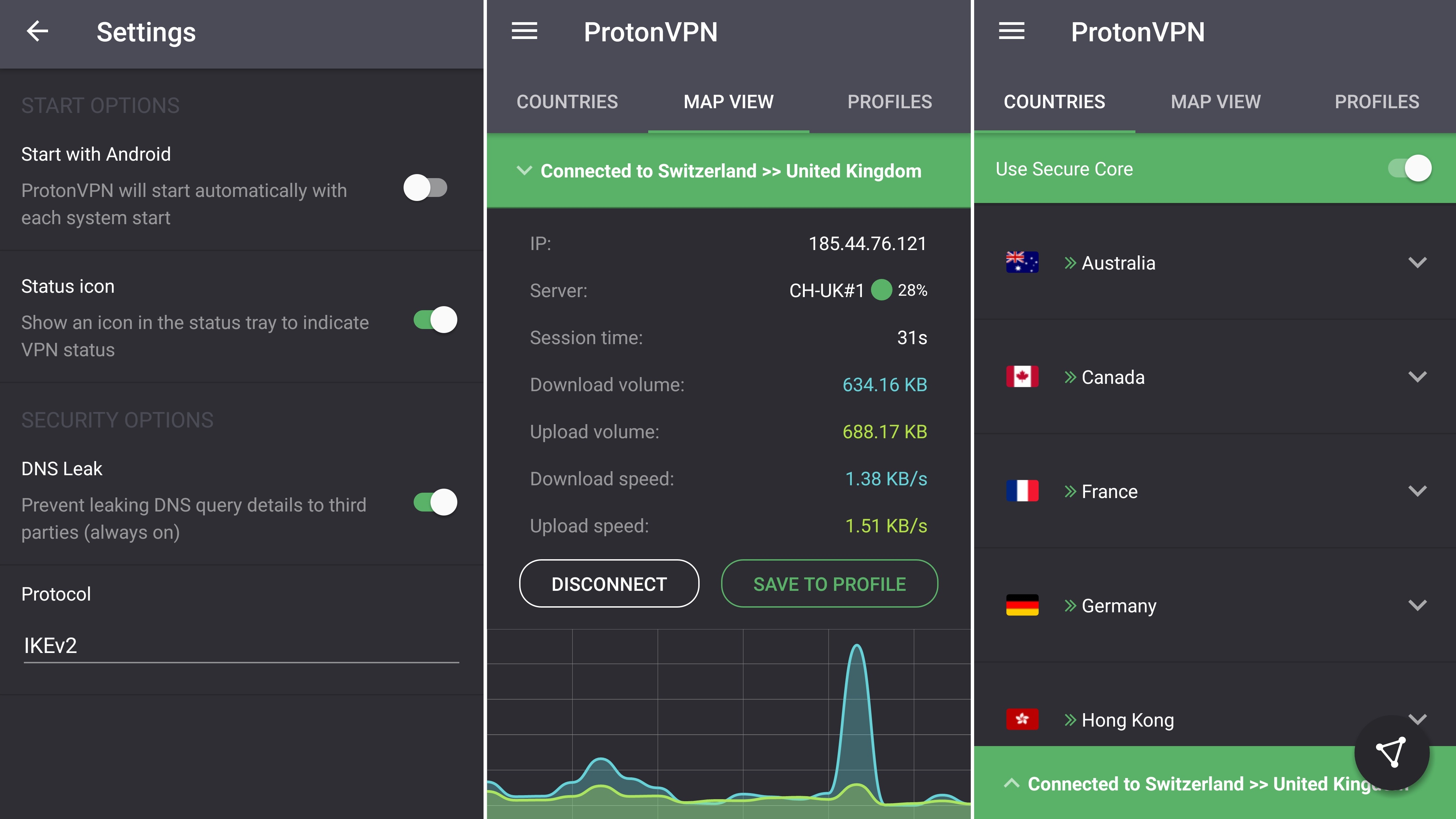
ProtonVPN
Free + various subscriptions
There are loads of VPN services available for Android, but ProtonVPN stands out in a few key ways, starting with the fact that you can use it for free, with no bandwidth limits.
It also puts more focus on security and privacy than some – it doesn’t track or record your activity, it offers hundreds of servers all over the world, and its ‘Secure Core’ maintains your privacy is even if a VPN endpoint server is compromised. It’s also easy to use, letting you connect to a server with just a few taps. It might sound too good to be true, but as far as we can tell it’s not.
There are also paid plans that offer even more. For $4/€4 (around £3.50) per month, a basic subscription increases the speed, unlocks servers in all countries and lets you use the app with two devices, while for $8/€8 (roughly £7) you can use ProtonVPN with up to five devices at maximum speeds.
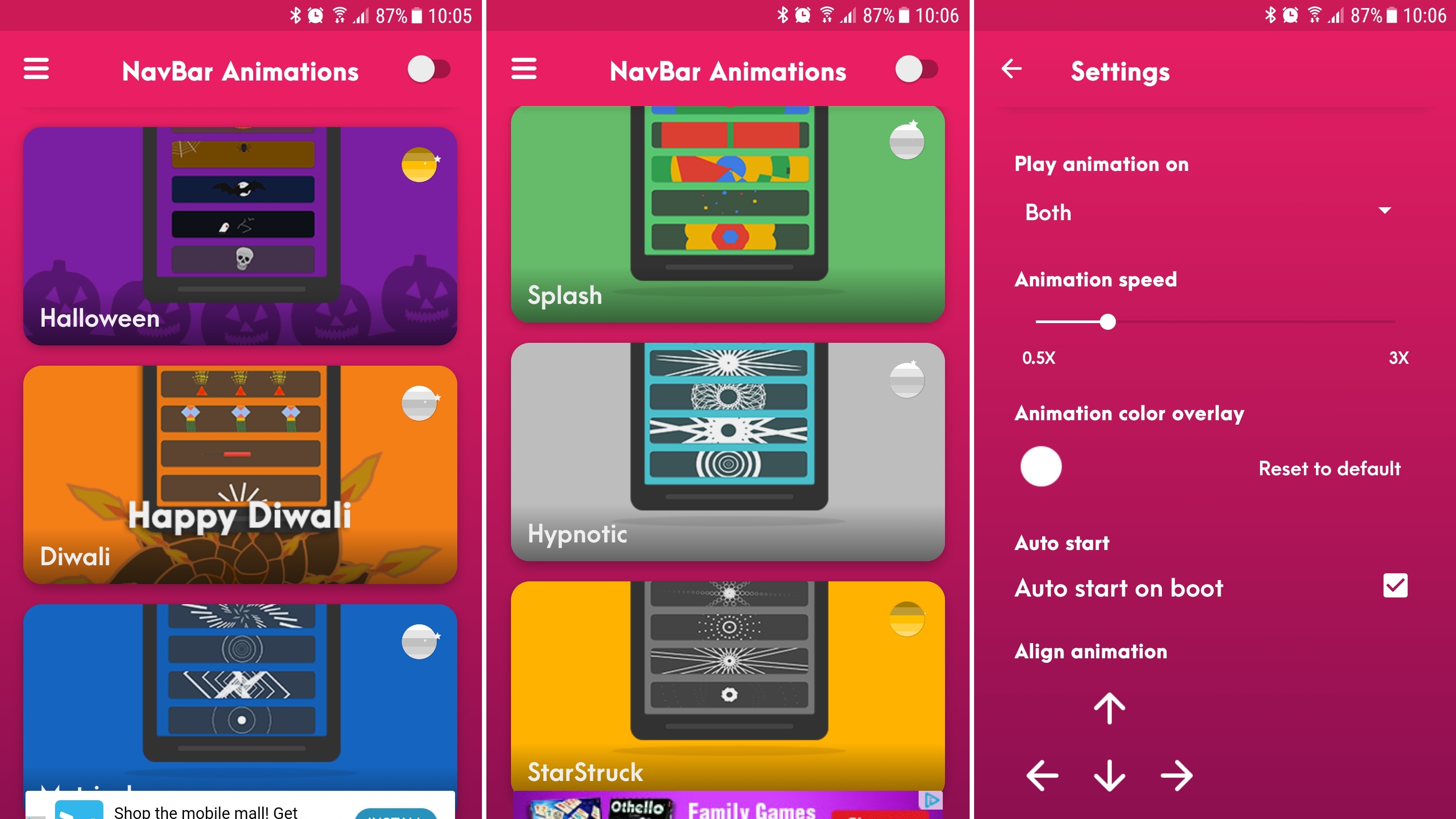
NavBar Animations
Free + $1.49/£1.29 IAP
Want to add a little life to your Android phone? Then you might want to check out NavBar Animations. Assuming your phone has a navbar (the bar at the bottom of the screen housing software buttons) this app will add an animation to it, which plays whenever you hit a button.
The fact that it doesn’t play constantly is a good move, as that would be a bit over the top. As it is, NavBar Animations just adds a bit of flair to your phone, and there are loads of animations to choose from, though many of them are hidden behind a $1.49/£1.29 IAP.
As well as picking an animation you can also pick its speed, whether it plays when hitting the home button, the recent apps button, or both, its colors and its alignment.
Then it’s just a case of set it and forget it – at least until the next time you hit one of those buttons.
Our favorite Android apps for planning a holiday, checking the weather and getting around without getting lost.
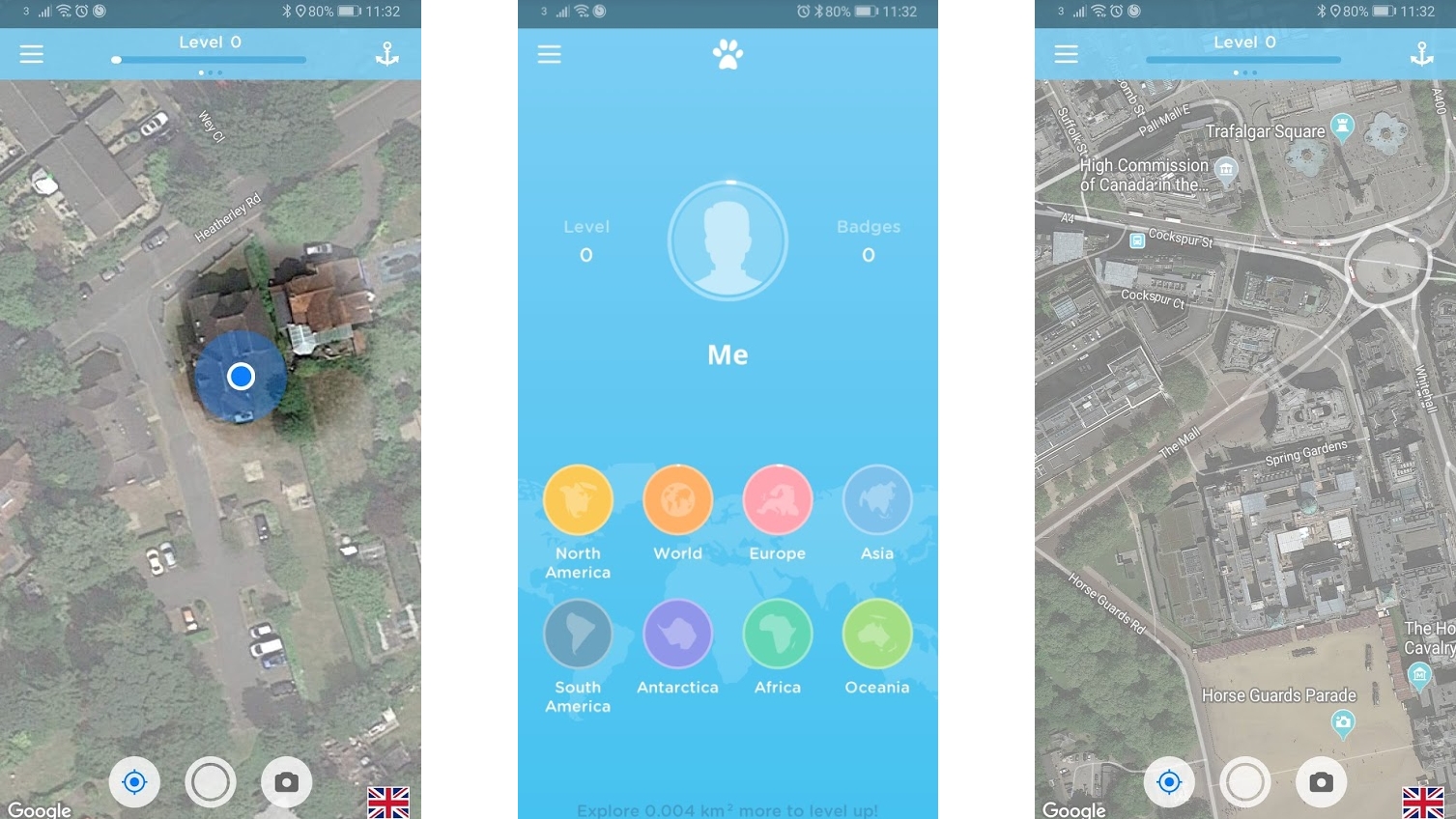
Fog of World
$4.99/£4.49
Fog of World is a new, fun take on mapping apps, as it’s inspired by the ‘fog of war’ that you get in some video games (that being fog that obscures areas of a map that you’ve not been to yet) but applies it to the real world.
The app gives you a detailed world map, but applies fog to it. Unlike most games the fog doesn’t actually hide the map, it just dulls it a bit. When you’ve been somewhere the fog is removed, so over time you can see all the places you’ve been on a single world map, based on which bits don’t have fog.
To make it more interesting you can level up as you make progress and unlock various achievements, such as for visiting a certain number of countries or crossing the equator. You can also sync your data so it’s available on other devices.
Fog of World isn’t going to replace Google Maps for your navigation needs, but it’s a fun, visual way to see where you’ve been, covering everything from a trip to the local store to your various holidays.
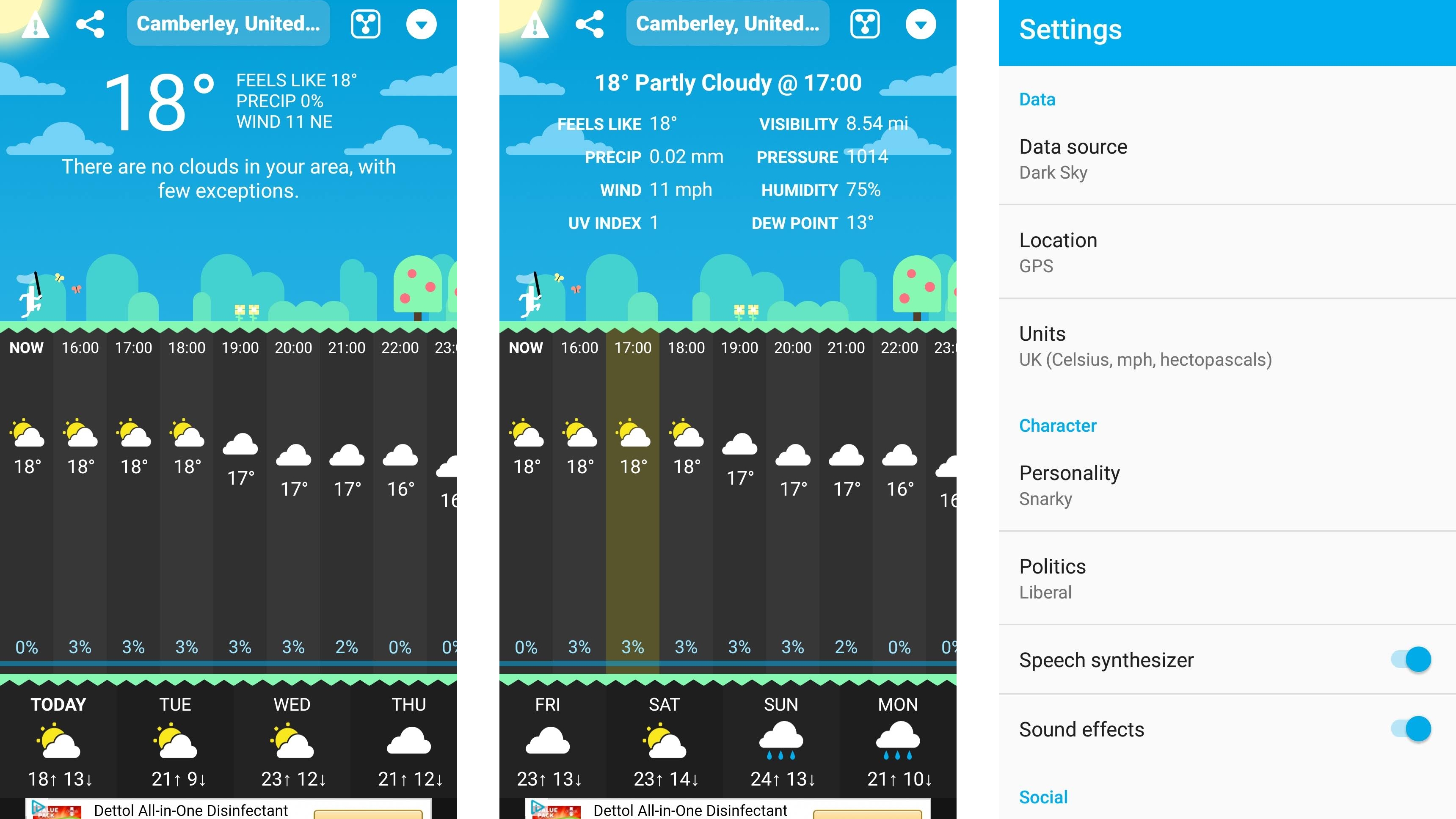
CARROT Weather
Free + optional $3.99/£3.39 yearly subscription
After a long stint on iOS, CARROT Weather has finally come to Android, and if you like a dose of snark with your forecast it’s worth getting excited about.
Because as well as providing accurate forecasts powered by Dark Sky, CARROT Weather is home to an ‘AI’ that insults you and revels in your weather-related misery. This takes the form of more than 6,000 lines of dialogue, each of which can optionally be spoken aloud by its synthetic voice.
With cute illustrations as well and even a game that sees you following clues to hunt down secret locations, CARROT Weather has more personality than any rival app.
It’s also good for the important matter of telling you the forecast, as you can see hourly and daily forecasts, complete with humidity, UV Index, wind speed and more.
The core app is free, but for US$3.99/£3.39 per year (or US$0.99/£0.89 per month) you can unlock a customizable widget, animated satellite maps, and get rid of adverts.
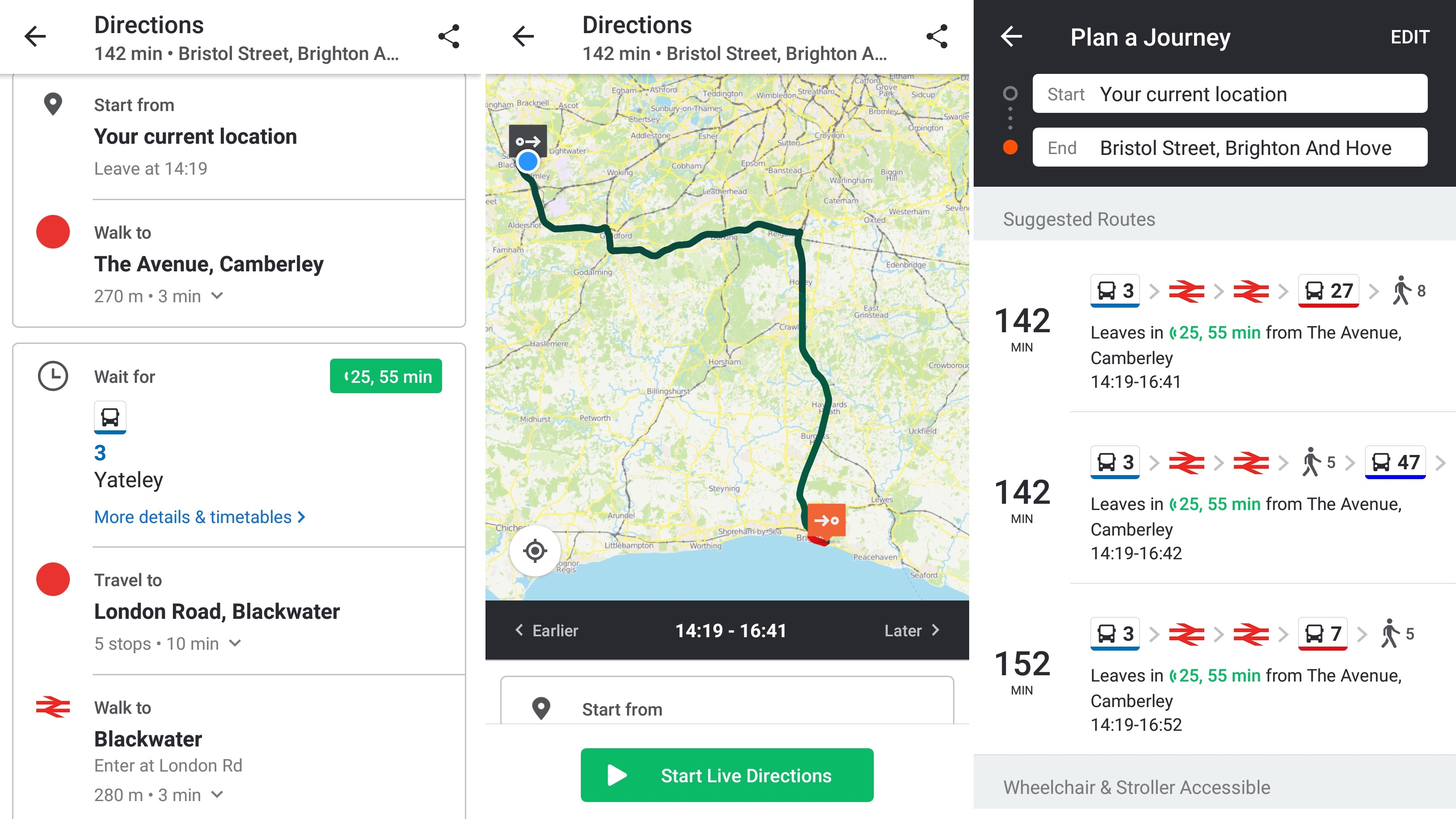
Moovit
Free
Moovit isn’t new, but if you ever use public transport it’s well worth knowing about. Simply type a destination and Moovit will give you a selection of ways to get there, using all the public transport routes available.
Tap on a route to get full directions or even a map with live navigation (complete with alerts telling you when to get off the transport you’re on), or further filter your results to minimize walking, use the least number of transfers or cut out certain transport types entirely.
There are also handy features like the ability to save regular destinations and favorite the bus and train lines you use a lot, so you can quickly see their timetables.
Transport timings are real-time where available, so you’ll know if the train or bus is running late, and you can download various maps for offline use. You can also use Moovit all over the world, with transport details for new cities regularly added.
All in all, it’s one of the slickest, most feature-packed public transport navigation apps you can get.
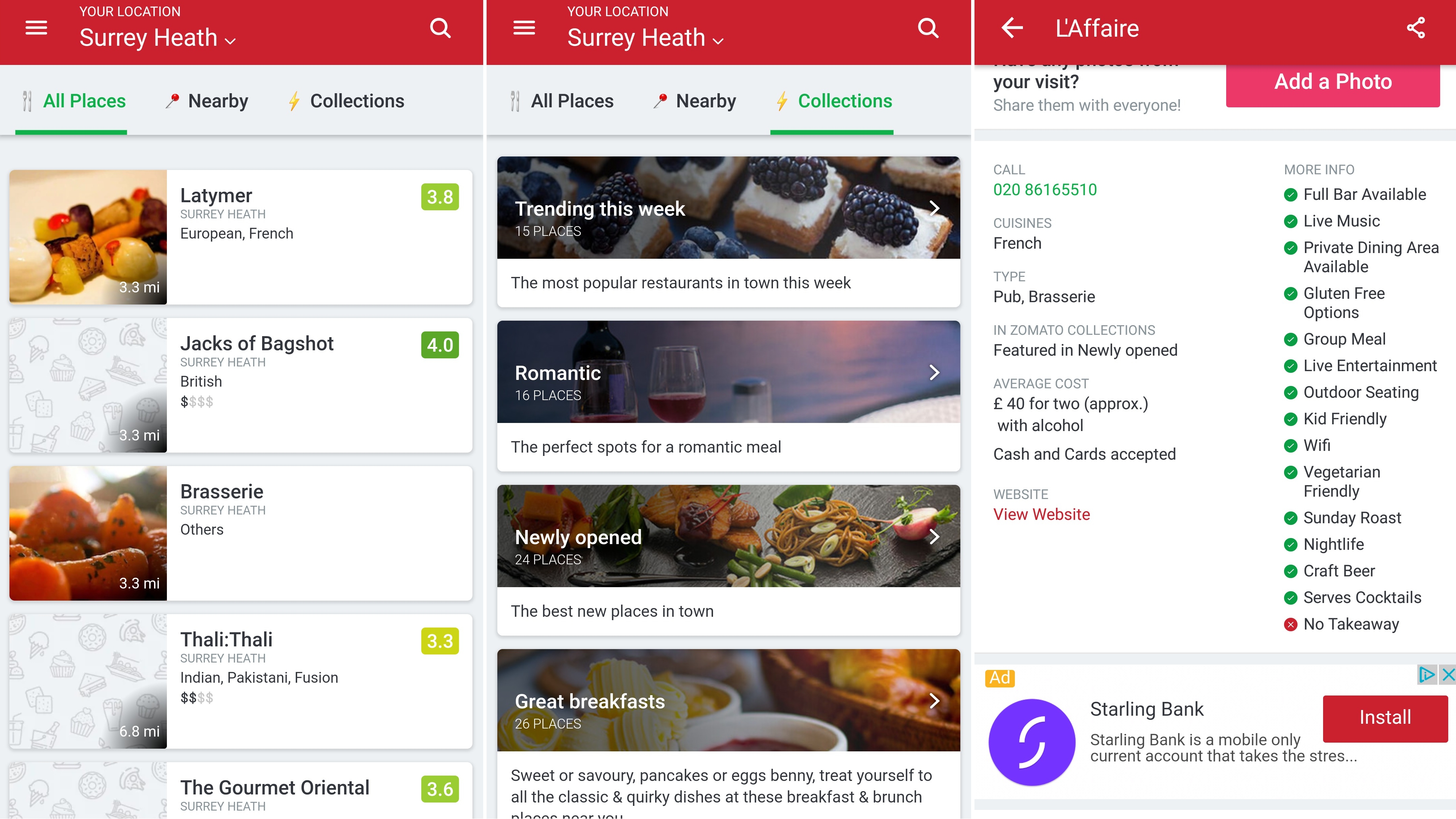
Zomato
Free
Ever need some inspiration for where to eat? If so, Zomato has you covered.
The app can show you nearby restaurants in a list or on a map, and you can filter results in numerous ways. Only want to see Chinese restaurants? No problem. Need somewhere that accepts bookings? You can do that. After outdoor seating? That’s fine too. And those are just a few examples of the many filters on offer.
There are also ‘collections’, which highlight restaurants that fit a specific theme, such as ‘great breakfasts’ or ‘celebrity chefs’, and when you’ve found somewhere of interest you can get loads more information by tapping on it.
You can see the opening times, pictures, reviews and ratings from other users of Zomato, menus, average costs, recommended dishes, contact details and a list of pros and cons.
From here you can also add your own review, rating or photos, call the restaurant or bookmark it so you don’t forget about it.
There’s also a social side to Zomato; you can follow other users, allowing you to see when they review a restaurant or say that they’ve visited it. Zomato has a lot to offer, and it could help you get out of your culinary comfort zone.
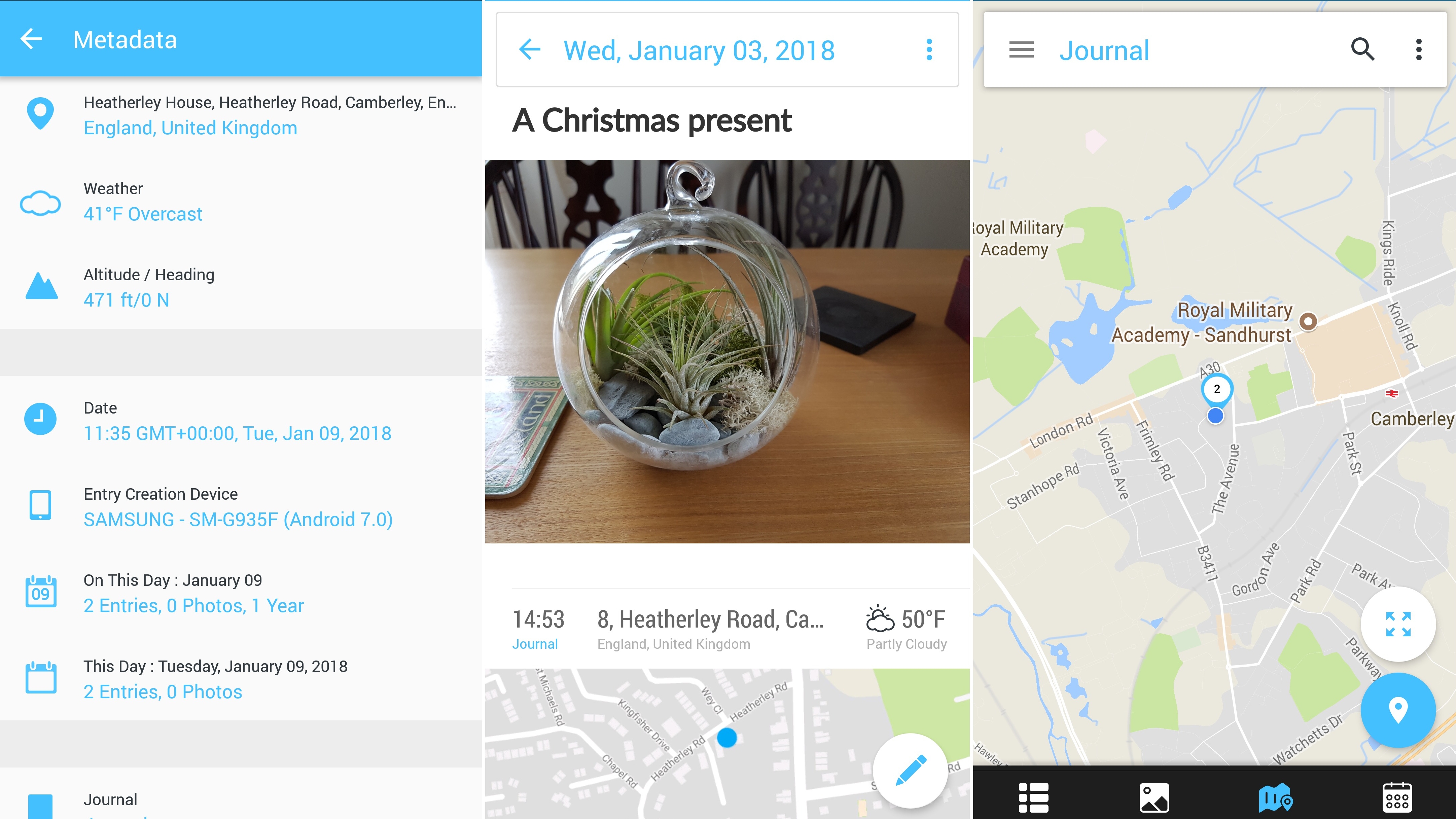
Day One Journal
Free + $24.99/£22.49 yearly subscription
Digital journaling is clearly popular considering the number of apps that let you do just that, and Day One Journal is one of the best.
It’s a recent Android arrival, but benefits from a long stint on iOS, where it’s had time to develop a high level of polish.
Its developers have recognized that there should be as few obstacles to journaling as possible. With a paper journal you just open it and start writing, and with Day One Journal you simply tap the big plus symbol on the main screen and start typing – or if you want to start with an image you can tap the camera instead.
All your entries are automatically tagged with the time, date, location and current weather, and you can later find them either on a calendar view, letting you search by date, or on a world map, with pins in locations where you’ve previously written an entry.
There’s also a gallery view, so you can browse the images in your journals, and you can star your favorites or add keywords for easy filtering.
Struggling to remember to write in your journal? Daily reminders can prod you. Want to look back on past entries but not sure where to start? Day One Journal can highlight entries you’ve made in nearby locations or on this day in previous years.
You can also keep your journals secure with a fingerprint or passcode, and if you pay the subscription for the premium version they’ll also be uploaded to the cloud so they’ll never be lost and are accessible from any device.
That optional $24.99/£22.49 yearly subscription also gets you the ability to keep multiple journals and store an unlimited number of photos. Worth it if you’re a daily journaler.
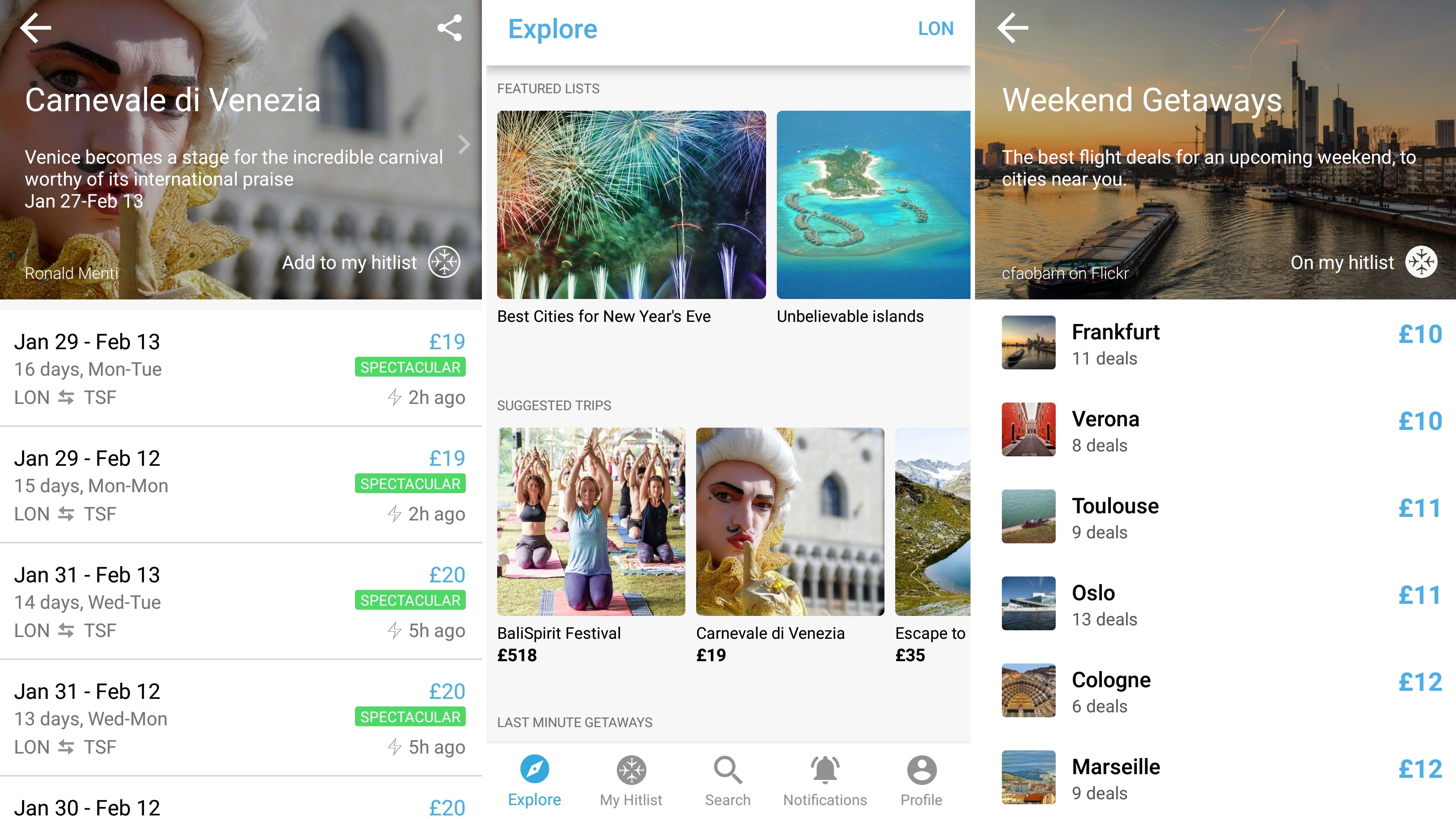
Hitlist
Free
Hitlist is another flight comparison tool, but it’s not just another flight comparison tool. It will search through millions of flight prices to find the best deals, as you’d expect, but it’s also focused on helping inspire you.
Because as well as being able to pick a specific date and destination there are also loads of categories shown off by the app, such as ‘weekend getaways’ and ‘unbelievable islands’, as well as events, such as ‘Alba Truffle Festival’.
The app also highlights low prices on last minute getaways in case you want to take a trip at short notice, and you can save locations if you want to be notified when prices drop.
All of which makes Hitlist decent if you just want to find low prices, and great if you also want some help deciding where to go.

Flowx
Free + various IAPs
Flowx isn’t actually a new app, rather a rebranding of WeatherBomb, but it’s worth your attention if you don’t know about it.
Yes, it’s a forecast app, but it’s more interested in showing you how weather systems move than simply telling you whether it’s going to rain.
The app gives you a map and then you can choose whether to track precipitation, cloud, wind speed, temperature, pressure or wave height. Then zoom in or out with a pinch and swipe slowly to see how these conditions are predicted to change over a period of hours or days, by watching for example clouds or storms move across the map.
You can add arrows to give you a clearer picture of the direction weather systems are moving in, key details such as the temperature are shown at all times, and you can customize the units of measurement.
Flowx probably won’t replace your normal forecast app, in fact the app description even suggests you use Flowx alongside a more conventional weather app, but if you want deeper insight into weather patterns it’s a fascinating addition to your app arsenal.
And if you get really into it there are various IAPs that will remove adverts, give you more days of data, additional features and ensure you get future features.
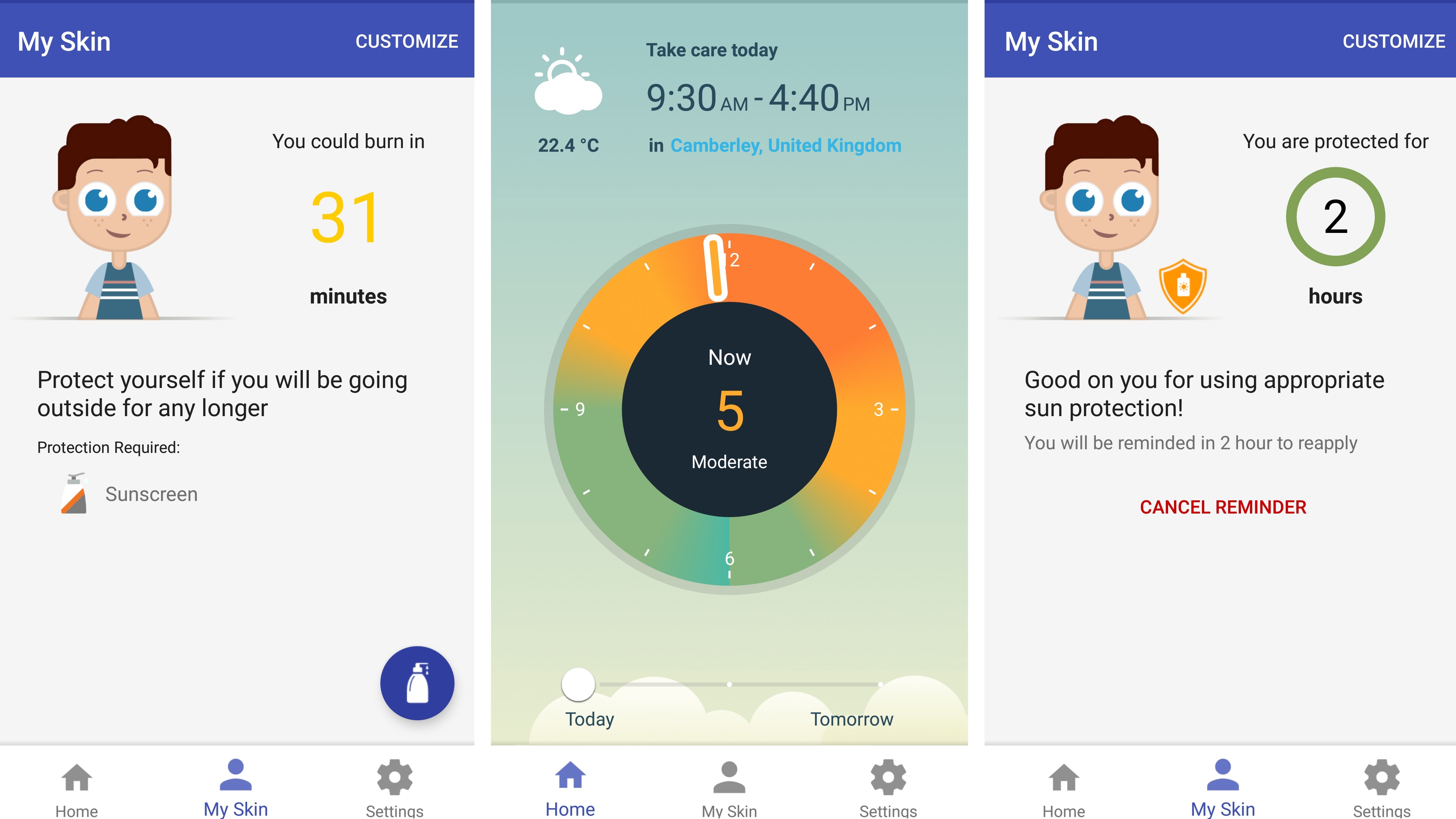
UVLens
Free
Avoiding sunburn can seem like a dark art at times. It doesn’t always need to be that warm or sunny to get burned, and everyone’s different in terms of how much UV they can take. It’s also not always clear how often you should reapply sunscreen, but with UVLens you need never get burned again.
The app tells you the UV index now and throughout the day, so you can plan the best time to be outside. And based on the current index, combined with what you tell it about your skin (the tone, whether you have many freckles etc), it will estimate how quickly you’ll burn and what if anything you should wear to prevent damage – be it sunscreen, sunglasses or a hat.
You can also tell the app the type of sunscreen you’ve applied and what activity you’re doing, and then it will tell you how soon you should re-apply, and can even alert you when it’s time to.
UVLens is a simple, easy to use app that makes the effects of UV - and how to combat them – far clearer.
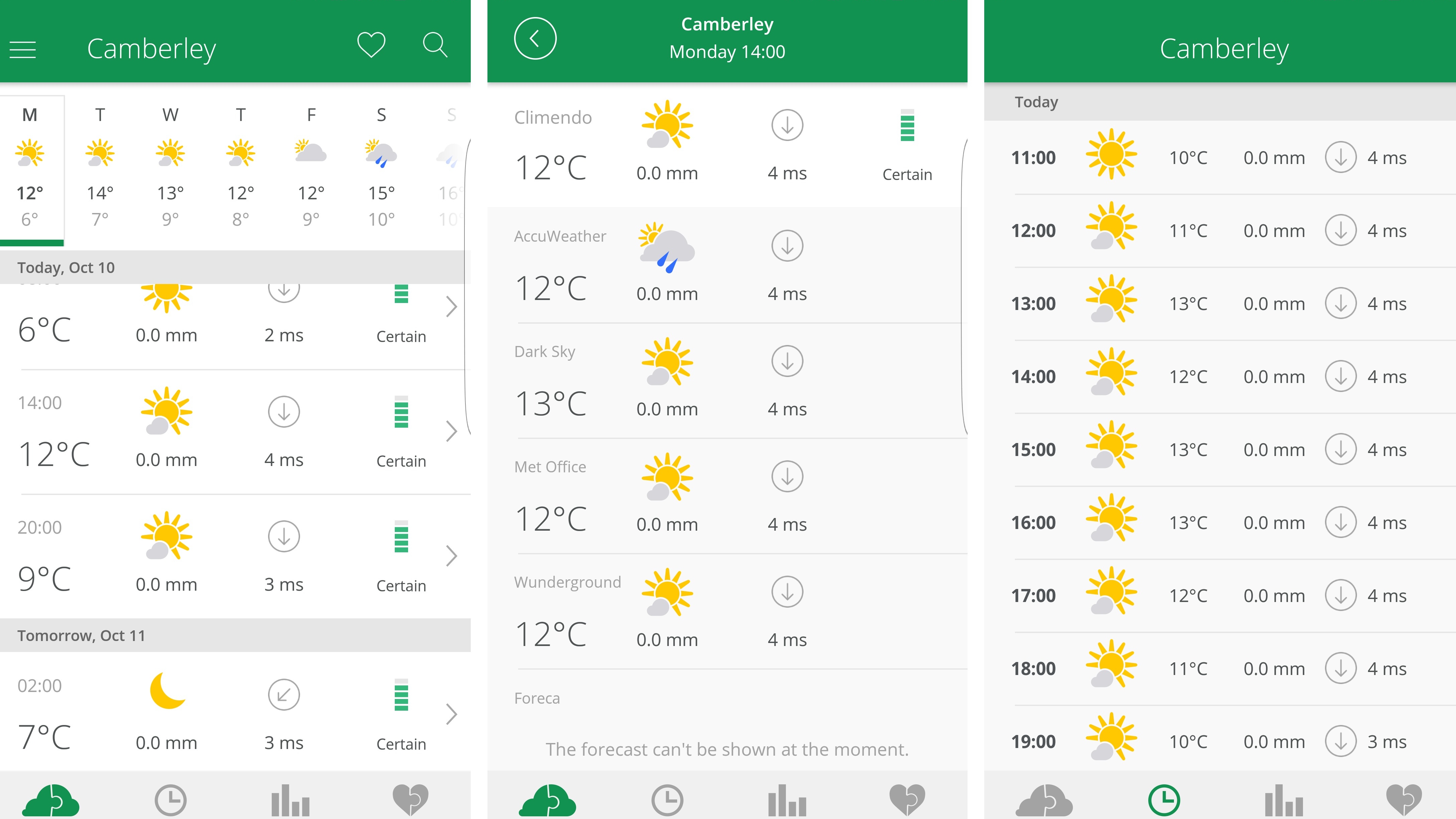
Climendo
$3.99/£3.49
The problem with weather apps is that, for the most part, they only use one source for their data, but Climendo uses lots, and then works out what the most likely weather at any given time is.
The complete selection of weather providers that it uses includes AccuWeather, Weather Underground, NOAA, Met Office, Foreca, Dark Sky, SMHI, YR and World Weather Online – though only the most accurate ones for your location will be used.
You can see hourly or ten day forecasts, complete with the likelihood of each being accurate, or you can dig down to the individual forecasts from each weather provider, to see how they vary.
Climendo lacks some of the more detailed information found in other apps – such as humidity and UV index - but if you just want accurate information on whether or not you need an umbrella then this app is up there with the best.
Contributer : Techradar - All the latest technology news http://bit.ly/2GGKdok

 Reviewed by mimisabreena
on
Tuesday, December 25, 2018
Rating:
Reviewed by mimisabreena
on
Tuesday, December 25, 2018
Rating:















No comments:
Post a Comment